

Vietnam Travel Guide
Last Updated: April 29, 2024
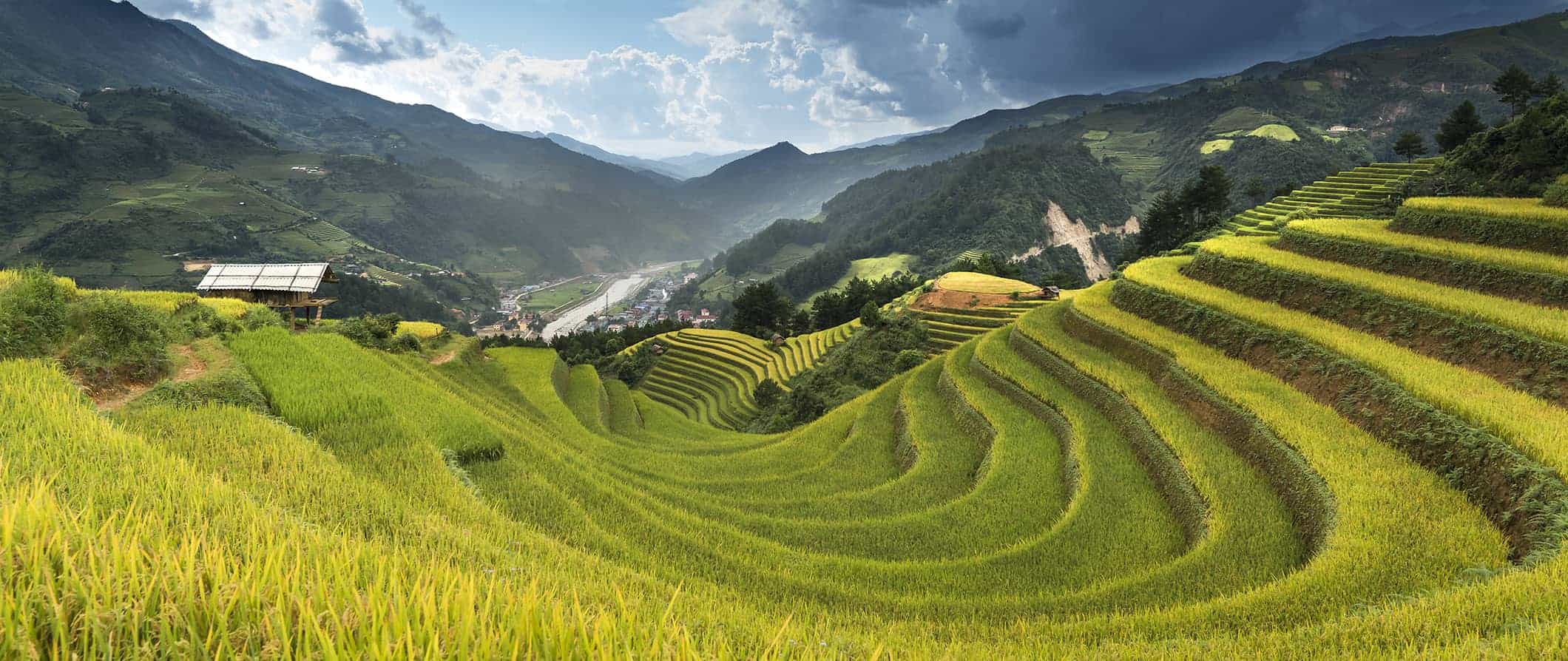
Most people either love or hate traveling in Vietnam. When I first went, there was a negative attitude towards foreign travelers (for good reason), lots of scams, and just not a lot of good vibes. But, since that trip many years ago, the country has changed a lot: it’s embraced tourism, people have opened up more, there’s fewer scams, and Ho Chi Minh City has even become a hub for digital nomads.
From exploring the Old Quarter of Hanoi to the delicious food and fancy garments of Hoi An , Vietnam has a lot to see and do so take your time. Don’t rush your trip.
This budget travel guide to Vietnam can help you plan your trip and ensure you make the most of your visit.
Table of Contents
- Things to See and Do
- Typical Costs
- Suggested Budget
- Money-Saving Tips
- Where to Stay
- How to Get Around
- How to Stay Safe
- Best Places to Book Your Trip
- Related Blogs on Vietnam
Click Here for City Guides
Top 5 things to see and do in vietnam.
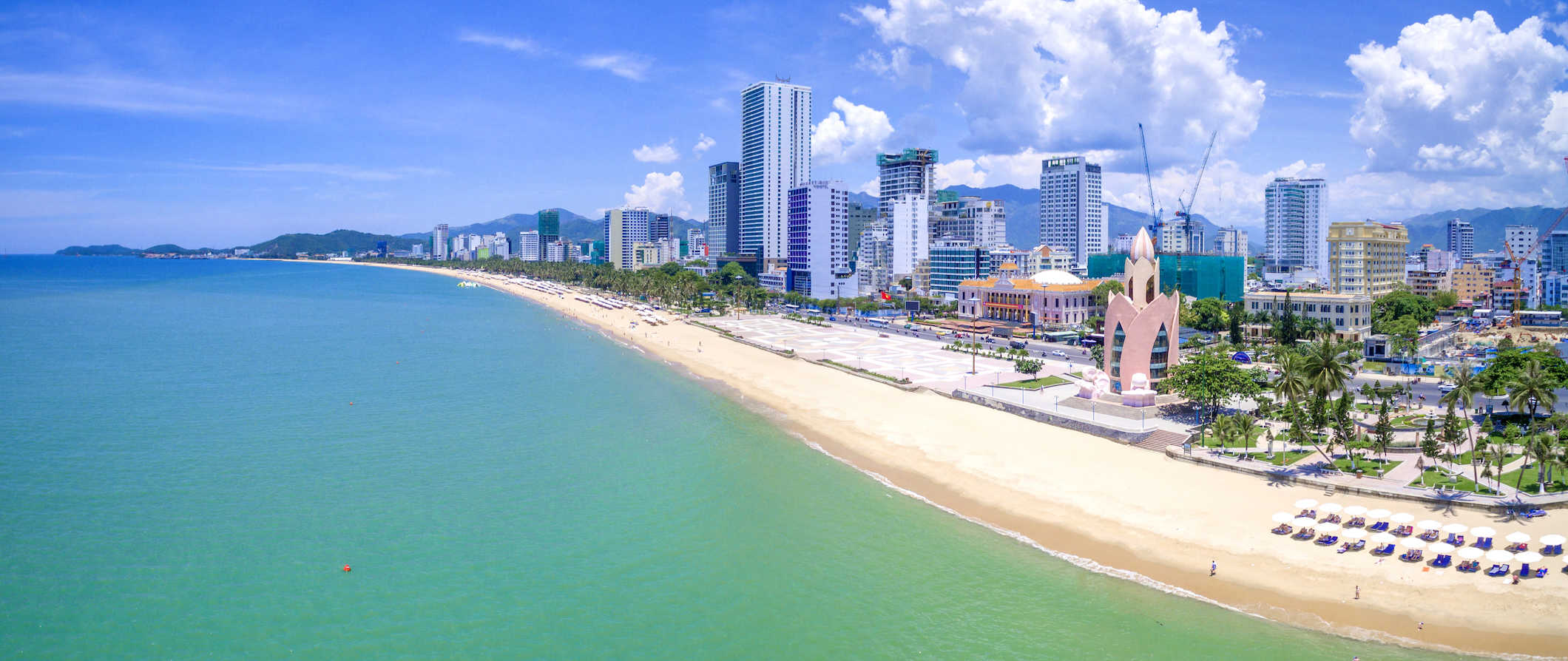
1. Tour the Mekong Delta
The delta is a 60,000-kilometer (37,000-mile) long web of interconnected waterways, which spans three Vietnamese provinces and has been used since the 4th century BCE. What I love about this area is it’s filled with small villages, pagodas, mangroves, and orchards. The best way to experience the area is to go on a boat or bike tour, where you’ll experience rural Vietnamese culture. Some of favorite things include the Cai Rang floating market for the colorful fruits and veggies and vibrant atmosphere; Vinh Trang Pagoda for its impressive golden exterior and lush gardens; and the incredible Sadec Flower Village that is stunning and serene, even if you’re not a flower enthusiast. Spend a few days really getting to know the region outside the hustle and bustle of the cities. Day trips on the river start at around 575,000 VND per person.
2. Wander Hanoi
Vietnam’s capital dates to the 3rd century BCE when it was the capital of the ancient nation of Au Lac. I love to wander around the narrow streets of the Old Quarter. It’s a great place to get a feel for the city as there are tons of vendors, smells of street food, people watching, and bustle. Some of my favorite places to visit include the One-Pillar Pagoda, the Imperial Citadel of Thang Long, and the Hanoi Water Puppet Theater. Be sure to check out the history museum to learn about French colonialism and Communist rule (from the Vietnamese perspective) as well as the Ho Chi Minh Mausoleum. Hanoi is also a good base for doing multi-day tours to Ha Long Bay.
3. Explore Ha Long Bay
This iconic region is home to more than 3,000 islands and is one of the country’s most popular tourist destinations. The towering limestone islands are covered in lush jungles and surrounded by calm emerald waters. A UNESCO World Heritage Site, it’s located 2-3 hours from Hanoi and travelers can take multi-day boat cruises around the islands (most are 2-5 days). During the cruise, you’ll visit floating markets, incredible beaches, massive caves, and either sleep onboard your boat or on one of the many islands. Just keep in mind that this area is super popular and is often overcrowded. Cheap tours start around 1,200,000 VND while a mid-range tour costs around 3,000,000-4,500,000 VND. Just remember that you get what you pay for and the cheaper boats might be a bit run down.
4. Hang out in Hoi An
Hoi An was a thriving port city between the 15th and 19th centuries and the architecture is incredibly well preserved (the entire Old Town is a UNESCO World Heritage Site). It was easily my favorite place in Vietnam because I loved walking around, taking a thrilling sidecar trip in the countryside, and of course, Vietnamese cooking classes, which are great because you learn to prepare fresh fish caught right there. This place is famous for its tailors so if you’re looking to buy some custom made clothes at an inexpensive price, this is the spot to do it in. They will even ship it back to your home country.
5. Get adventurous in Sapa
This is northern Vietnam’s premier trekking area and it’s hugely popular with all sorts of travelers. Sapa is famous for its hill tribes, lush vegetation, beautiful hiking trails, and breathtaking mountains. If you’re looking to experience the scenery and outdoor recreation opportunities Vietnam has to offer, this is the place. This area is rich in culture because it is comprised of 85% ethnic Vietnamese minority groups that have different colorful traditional dress and unique styles of houses. To avoid the tourists, come during the off-season or take longer hikes to parts the crowds don’t go to.
Other Things to See and Do
1. take a free walking tour.
The first thing I do when I visit a new destination is take a free walking tour. It’s the best way to get the lay of the land, see the main sights, and connect with a local guide who can answer all my questions. Both Hanoi and HCMH (the two largest and most popular cities in the country) have a few free tours available that cover the main highlights and are a great primer to the country (Hanoi Free Walking Tours and Saigon Free Day Tours are two companies worth checking out). Just remember to tip your guide at the end!
2. Crawl through the Cu Chi Tunnels
This extensive network of tunnels spans nearly 310 miles (500 kilometers). It was utilized by the Viet Cong during the Vietnam War. Tours involve a description of the tunnels, after which tourists are allowed to crawl about the maze and fire AK47s at shooting targets. It’s a sobering experience and not one meant for anyone claustrophobic. However, if you want to better understand the terror of the Vietnam War, this is a must-visit. Admission is around 100,000 VND per person.
3. Relax or find adventure in Dalat
Dalat is nestled in the hills of the Central Highlands and is popular with tourists who want to relax in the mountain air and those who want to participate in a host of adventure sports (such as rock climbing, ziplining, and rappelling). The hills around Dalat are filled with traditional tribal villages, which you can tour as well. Expect to pay around 2,000,000 VND per person for a full day of ziplining and rappelling around waterfalls.
4. Visit Cuc Phuong National Park
South of Hanoi lies Vietnam’s first National Park, Cuc Phuong. Covering 222 square kilometers (85 square miles), this place is home to over 2,000 species of trees and some truly rare wildlife including the Clouded Leopard, Delacour’s Langur and Owston’s Civet. It was my favorite park in all of Vietnam and the only place I didn’t find hordes of tourists. The entrance fee is 50,000 VND.
5. Explore Ho Chi Minh City
Also known as Saigon, Ho Chi Minh City is Vietnam’s largest city and is definitely worth exploring. Ho Chi Minh is the place to really gain an understanding of French colonialism as well as the US headquarters there during the Vietnam War, which you can learn more about at the War Remnants Museum. Like most cities in Vietnam, you’ll be met with the roar of motorbikes speeding through colonial streets. I loved Ben Thanh Market, which is a must-see for amazing food and there is a great buzz of activity within the place. Don’t miss your chance to get the best Pho soup in Ho Chi Minh, that means some of the best is right on the side of the street.
6. Get active in Mui Ne
Despite being a fishing village, Mui Ne has a significant tourism scene due to its popularity as a wind- and kite-surfing destination. The best highlight for me aside from the beach was riding on the rolling sand dunes similar in size to the Saharan ones and also the Jeep Tour to the Fairy Stream through a canyon, which is not something you get to do very often! Also, don’t miss the 9th-century Po Shanu Cham Towers with beautiful views of the Phan Thiet coastal town. Mui Ne is definitely worth checking out for a day or two when you’re passing by on the bus because it has a nice chill vibe to it, friendly people, and beautiful sunsets.
7. See My Son
My Son is a set of Hindu ruins in Vietnam that date back to the Cham Empire. The Champas ruled over Central Vietnam from the 3rd to the 19th century. The temples here are of incredible historical importance, but they have been largely reclaimed by the surrounding jungle, and have fallen into a great state of disrepair. Don’t come here expecting something as marvelously preserved as Borobudur or Angkor Wat. The entrance fee is 150,000 VND.
8. Visit the caves in Phong Nha-Ke Bang
Hang Son Doong is reputed to be the world’s largest cave and is located in Phong Nha-Ke Bang National Park. It was discovered by a local in 1990, and “rediscovered” by a British caving team in 2009. You can arrange trips to see this stunning cave in all its glory with stalactites and stalagmites, an inner cave forest, and even cave pearls. You’ll be blown away by its beauty. Entrance to the caves is around 150,000 VND per person.
9. Check out the rice terraces
Outside of connections to the Vietnam War, the stereotypical image of Vietnam is of the many rice paddies. You can find these in the Muong Hoa Valley. If you’ve never visited rice terraces, you should make a point to see them in Vietnam. Visit them to learn about rice production and take stunning photographs of the unbelievable Vietnamese countryside. Expect tours to cost around 600,000 VND per person.
10. Relax in Hue
Hue is generally passed by, making it a bit of a quieter stop along the tourist trail. Stroll along the beautiful Perfume River and into the Imperial Citadel. Don’t miss the Tu Hieu Pagoda and the Tombs of the Emperors, which mostly date from the 19th and 20th centuries. Some of the main tombs to see are the Tomb of Minh Mang, the Tomb of Tu Duc, and the Tomb of Khai Dinh.
11. Take a cooking class
Vietnamese food is delicious and the best way to learn about these incredible dishes is to take a cooking class. You’ll not only learn how to make some of these tasty meals but you’ll get to interact with a local chef who can teach you about their history and cultural significance. Many cooking classes also include a visit to the local market where you’ll shop for ingredients. Prices vary but expect to pay at least 800,000 VND per person.
12. Tour the former DMZ
The Vietnamese Demilitarized zone was the dividing line between the Communist north and anti-Communist south during the Vietnam War. It was in use from 1954 to 1976. These days, you can take a tour of the DMZ from Hue and learn about the conflict from expert guides who were actually involved in the war (or survived it as civilians). You’ll see secret tunnels, learn about military surveillance, and get insight about the conflict from a perspective not often shown in the media. Full-day tours from Hue start around 2,500,000 VND.
13. Buy a motorbike
If you’re an adventurous traveler, buy a motorbike and drive the length of the country. This is considered the best way to travel Vietnam by veteran backpackers who like to get off the beaten path. You can buy bikes in Hanoi or HCMC at either end of the country and then make your way to the opposite end, stopping along the way over the course of a few weeks. While it’s not for everyone, this mode of travel offers the most freedom as you’ll be able to visit a lot of places that the buses and trains don’t stop at. You can buy a bike for as little as 4,800,000 VND, and then you can sell it once your trip is done to recoup some of the cost. There are always backpackers looking to buy a bike in HCMC and Hanoi.
14. Sample the local coffee
Vietnam is the world’s second-largest coffee producer (after Brazil) exporting a whopping 1.5 million tons of it per year (after rice, it’s their biggest export). Even if you don’t drink coffee (I don’t), trying fresh coffee here is a must. Whether you just hop arounds cafes, do a tasting experience in Hanoi of HCMC, or head out to one of the many coffee plantations, learning about this vital crop (and also sampling it fresh) is an experience not to be missed. Expect a half-day plantation tour (with lots of samples) to cost around 700,000 VND.
For more information on specific cities in Vietnam, check out the following guides:
- Hanoi Travel Guide
- Ho Chi Minh City Travel Guide
- Hoi An Travel Guide
- Nha Trang Travel Guide
Vietnam Travel Costs
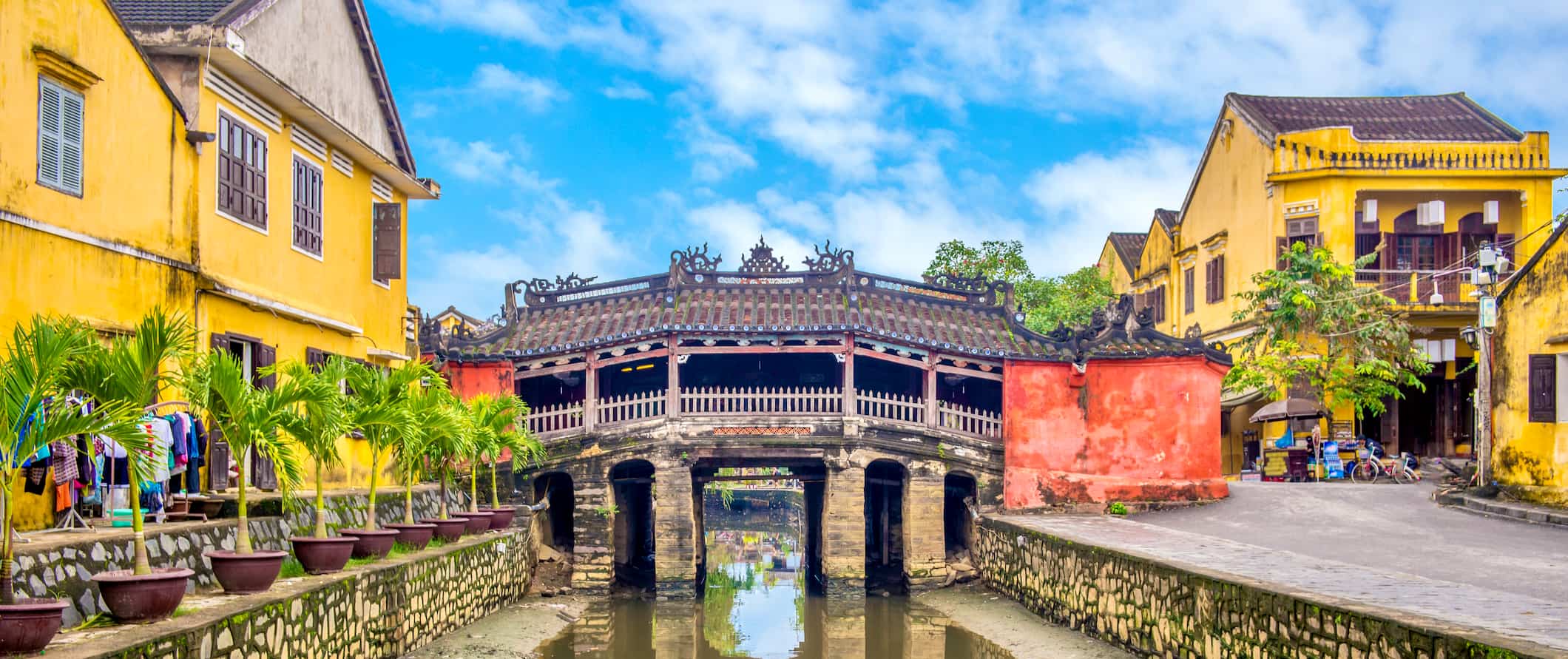
Accommodation – Hostels start at around 100,000 VND per night for a dorm room. These can be a bit rustic and no-frills. For a hostel with more amenities, such as free breakfast or a a free happy hour (as well as improved cleanliness), expect to pay double. Private rooms cost at least 350,890-425,000 VND per night for a double room. Most hostels include free Wi-Fi, and many also include free breakfast or free beer during certain hours of the day. Self-catering facilities are not very common since eating out is so cheap.
For those traveling with a tent, wild camping is not legal in Vietnam. While it is still possible to do as enforcement is sparse (especially if you’re sleeping in a hammock), I also wouldn’t recommend it. Insects and animals can be an issue, there are lots of landmines still undiscovered out in the brush, and robbery can occur. Stay safe and stick to hostels.
For a budget hotel with a double bed, expect to pay around 225,000 VND per night. This usually includes free Wi-Fi and free breakfast.
On Airbnb, a private room costs at least 325,000 VND per night. For an entire home or apartment, prices begin around 600,000 VND. Prices double when not booked in advance so plan accordingly
Food – Vietnamese cuisine is fresh, flavorful, and uses a lot of herbs and vegetables. Rice and noodle dishes are common as are various soups such as the iconic pho (a beef noodle soup). Wonton soup, meat curry, fresh French bread (known as bahn me , and grilled fish are just some of the popular dishes you’ll encounter. Standard ingredients include fish sauce, lemongrass, chili, lime, Thai basil, and mint.
You can get a bowl of pho or a rice dish for 20,000 VND. Street food is the cheapest and the most delicious food option in the country.
Most sit-down restaurants are also inexpensive at around 45,000-95,000 VND. The fancier (and more touristy) the restaurant, the more expensive.
Western food is also more expensive, usually around 110,000 VND for a fast food meal, so skip it if you’re on a budget.
If you want to splash out on a fancy three-course meal, expect to spend around 250,000 VND.
A liter of water at a convenience store is about 15,000 VND, while beer or soda is about 20,000-35,000 VND.
For those looking to cook their own meals, expect to pay at least 400,000 VND per week for basic groceries. Be sure to shop at the local markets to get the cheapest and freshest food. That being said, food is so cheap in the country that it’s simply easier – and cheaper – to just eat street food, especially as most hostels and hotels don’t have shared kitchens.
Backpacking Vietnam Suggested Budgets
On a backpacker budget, you can visit Vietnam for 600,000 VND per day. This budget covers a stay in a large hostel dorm, eating street food for all of your meals, limiting your drinking, taking the bus, and doing free activities in each destination. If you plan on drinking, add another 20,000-40,000 VND to your daily budget.
A mid-range budget of about 1,125,000 VND per day covers staying in a cheap hotel, eating street food and at the occasional sit-down restaurant, enjoying a few more drinks, taking the occasional taxi to get around, and doing more paid activities such as museum visits and water upper shows.
On an upscale budget of 2,460,000 VND, you can stay in a nice hotel, eat out for all your meals anywhere you want, enjoy lots of drinks, and more taxis, and do whatever tours and activities you want, including a multi-day trip to Ha Long Bay. This is just the ground floor for luxury though. The sky is the limit!
Vietnam Travel Guide: Money-Saving Tips
Vietnam is a very affordable country. In fact, it’s one of the cheapest in Southeast Asia. Even with the explosion of tourism in the last few years, it still remains very affordable. You’ll be hard pressed to spend money if you’re sticking to non-Western food, cocktails, and hotels. However, if you’re looking to travel even cheaper and save some money, here are some tips:
- Eat delicious street food – The street food here is excellent and cheap, and you can watch it being cooked in front of you. Stick to the local food and you’ll save money. The street-side pho, bread, sandwiches, donuts, and bananas are your best deals.
- Late-night travel – If traveling on long journeys, try to take the late-night “sleeper” buses or trains as these will save you the cost of a night’s accommodation. Depending on the company, you may even have a chance to comfortably lie flat as you ride through the dark countryside to your next destination.
- Take the tourist bus – It is actually cheaper to take the tourist bus around the country than taking local transportation because of the “tourist” price you get at the bus station. Tickets from one end of the country to another are very affordable.
- Fly for cheap – Vietnam’s low-cost airlines VietJet and FlyVietnam are extremely inexpensive. This is a great option for people with limited time to explore different regions of Vietnam. Both airlines frequently offer special deals and at the time of writing this, Hanoi to Da Nang is just 820,000 VND!
- Bargain hard – Tourists tend to be charged more than locals for everything from cyclos (a three-wheel bicycle taxi) to clothes to street food. Bargain harder than you would ordinarily, and don’t underestimate the value of walking away.
- Avoid paying tourist prices – Before you leave the hostel, ask them to estimate how much what you want to do should cost. How much should a ride to the museum cost? How much should I pay to have a gown like this made? They will be able to give you bargaining guidelines.
- Bring a reusable water bottle – The tap water in Hanoi is not safe to drink. To save money and reduce your plastic use, bring a reusable water bottle with you. LifeStraw make a reusable bottle with a built-in filter so you can be sure your water is always safe and clean.
Where to Stay in Vietnam
To help you save money on accommodation, here’s a list of my recommended hostels and budget hotels in Vietnam:
- Mad Monkey (Hoi An)
- Hoi An Golden Holiday Hotel (Hoi An)
- Little Hanoi Hostel (Hanoi)
- San Palace Hotel & Spa (Hanoi)
- Hanoi House Hostel & Travel (Hanoi)
- Ccasa Hostel & Coffee Bar (Nha Trang)
- The Hideout (HCMC)
- Orchid’s Saigon Hotel (HCMC)
How to Get Around Vietnam
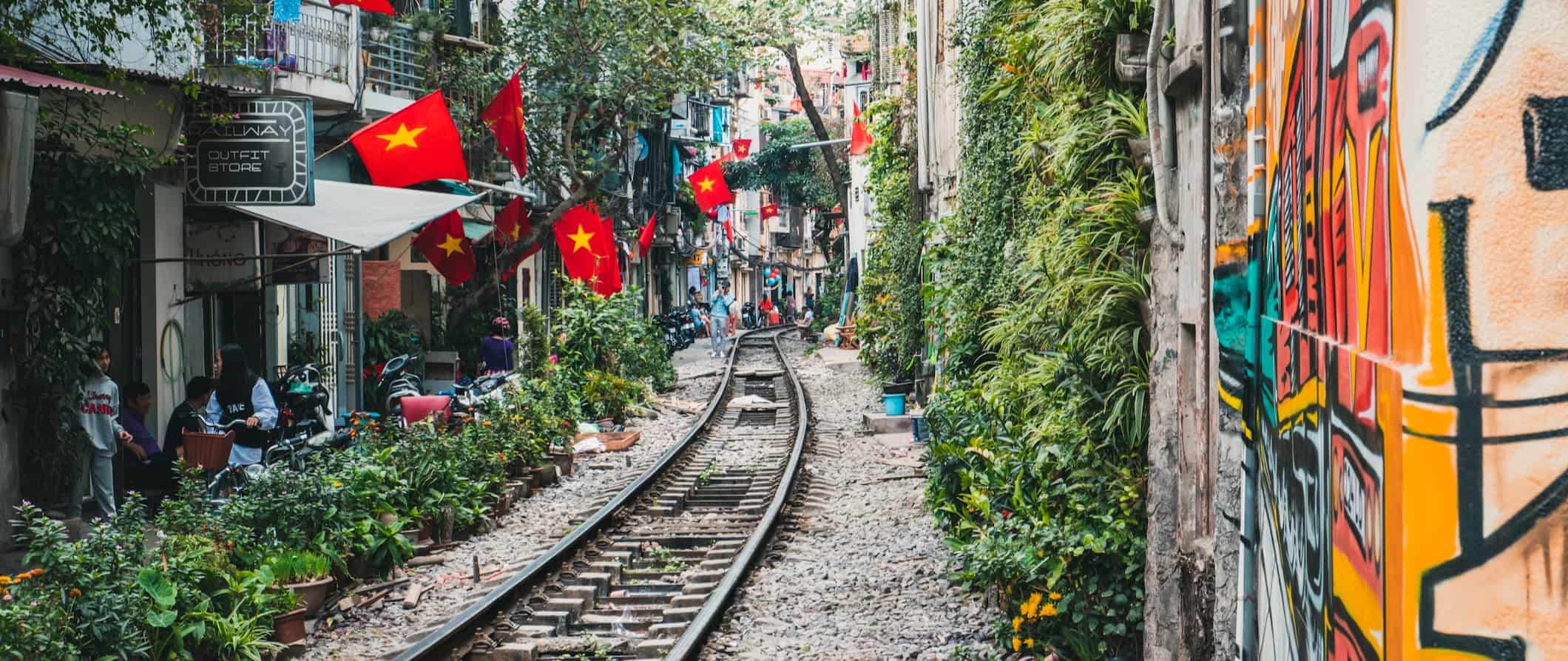
Public transportation – Larger cities in Vietnam (such as Hanoi and HCMC) have reliable and safe public transportation. In Hanoi, there are buses that cover most of the city and generally have stops near all the major tourist sites. Tickets are paid for in cash on the bus and generally cost 7,000-15,000 VND depending on how far you go. HCMC also has a large network of buses, with tickets costing up to 10,000 VND (again, depending on how far you travel).
Cyclos (a bicycle rickshaw) is one of the cheapest ways to get around. A short ride costs as little as 12,000 VND, while a longer night ride costs upwards of 40,000 VND. A more popular option is the ze om , a motorbike taxi that has fares starting from 15,000 VND. You’ll have to hold on tight though (and make sure you wear a helmet as accidents are common).
Train – A lot of people love taking the train in Vietnam because it’s safe, affordable, and comfortable and, although some routes might be slow, you’ll get some amazing views of the Vietnamese countryside. The rail network also covers most of the country, so you can get just about everywhere you want to go (except the Central Highlands and the Mekong Delta). You can use the website Baolau to research train schedules and book your tickets. A train journey between Ho Chi Minh and Hanoi (which spans the entire length of the country) starts at 1,000,000 VND for a soft seat (not a berth). The journey takes three days. Hanoi to Hue costs around 600,000 VND and takes around 13 hours while HCMC to Nha Trang costs around 500,000 VND and takes 8 hours.
Bus – It’s easy to find long-distance hop on, hop off bus tours running the length of Vietnam. You can hop on or off at any stop along the way. They cater to tourists, but locals actually use this service too since it’s super affordable. Prices depend on route and operator but generally, Hanoi to Ho Chi Minh is between 815,000-1,600,000 VND.
To find bus routes and prices, use BusBud .
Flying – Flying domestically in Vietnam is a good idea if you’re looking to fit a lot into a shorter trip. For example, a flight from Hanoi to Ho Chi Minh City takes two hours while the train ride would take at least 30 hours. One-way flights around the country start at around 590,000 VND.
Car rental – Vietnam is very easy to navigate by bus, so I don’t really suggest renting a car here — especially because traffic in the cities is very hectic and accidents are common. That said, car rentals are affordable, costing around 500,000 VND per day. An IDP (International Driving Permit) is required. For the best car rental prices, use Discover Cars .
When to Go to Vietnam
In the southern part of Vietnam, the dry season lasts from December to late April/May while the rainy season occurs from May to the end of November. The rainy season usually just means brief heavy downpours in the afternoon, although sometimes the Mekong Delta will flood. The dry season is the best time to visit but keep in mind that it’s winter up north and it’s going to be a lot colder in the north than the south. Rainy season isn’t that bad either but, like the name implies, it rains a lot.
May through November is still a good time to visit. Temperatures rarely dip below 20°C (68°F), but they can sometimes get as high as 40°C (104°F) in the hottest months (March to the end of May). The south especially gets very hot and humid during this time but it’s perfect beach weather!
Along the central coast, the rainfall pattern differs quite a bit. In the northern part of the region (like Hué and Da Nang), the rain lasts from September to February. February to May is the best time to visit this area. Temperatures soar from June to August, often in the high 30s°C (80s°F).
In Northern Vietnam, the weather is most pleasant from October to December.
The weather in Vietnam varies so much per region so it’s hard to pick the best time to go. But generally, it’s recommended to visit sometime between September-December and March-April if you’re hoping to get an overall experience in the country.
How to Stay Safe in Vietnam
Vietnam is an incredibly safe place to backpack and travel. Violent crime is really, really rare. Petty theft is the most likely thing to happen to you here. Always keep your valuables secure when out and about just to be safe. Lock your windows and use common safety sense, especially in bars at night and in touristy areas.
Traffic in the major cities (specifically Hanoi) is super hectic and there are virtually no rules of the road. There are also millions of motorbikes and scooters here (literally). For that reason, take extra caution when crossing the street. It’s best to just walk as directly and calmly as possible and let the traffic weave around you. If you’re not comfortable doing that alone, follow locals when they cross.
If renting a bike or riding on the back of one, make sure you always wear a helmet. Accidents are incredibly common here, both in the traffic-heavy cities but also in rural areas where roads can be less than optimal.
There are some common scams in Vietnam, such as the motorbike scam where vendors try to charge you for pre-existing damage to your bike rental. When renting anything, take photos and videos beforehand just in case.
Be sure to always count your change. The money is similar looking here so oftentimes people will “mistakenly” give you the wrong change hoping you won’t notice that the 200,000 VND bill you just got is actually only 20,000. Always count your change here!
Most scams here are really just people trying to try to nickel and dime you and try to get you to spend extra money since they know, as a tourist, you have more than they do. You can read about common travel scams to avoid here .
Solo female travelers should generally feel safe here, however, the standard precautions apply (never leave your drink unattended at the bar, never walk home alone intoxicated, etc.). Use common sense when using dating apps while traveling and meet in public places.
Street food here is very safe, but whenever you’re not sure of where to eat simply find somewhere where there are locals eating. If it’s good (and safe) enough for them, you should be fine. Avoid meat that looks uncooked or that has been out in the sun too long. Always wash your hands before and after eating just to be safe.
If you experience an emergency, dial 113 for assistance.
Be sure to make copies of your important documents in case of theft.
The most important piece of advice I can offer is to purchase good travel insurance. Travel insurance will protect you against illness, injury, theft, and cancellations. It’s comprehensive protection in case anything goes wrong. I never go on a trip without it as I’ve had to use it many times in the past.
Vietnam Travel Guide: The Best Booking Resources
These are my favorite companies to use when I travel. They consistently have the best deals, offer world-class customer service and great value, and overall, are better than their competitors. They are the companies I use the most and are always the starting point in my search for travel deals.
- Skyscanner – Skyscanner is my favorite flight search engine. They search small websites and budget airlines that larger search sites tend to miss. They are hands down the number one place to start.
- Hostelworld – This is the best hostel accommodation site out there with the largest inventory, best search interface, and widest availability.
- Agoda – Other than Hostelworld, Agoda is the best hotel accommodation site for Asia.
- Booking.com – The best all around booking site that constantly provides the cheapest and lowest rates. They have the widest selection of budget accommodation. In all my tests, they’ve always had the cheapest rates out of all the booking websites.
- Get Your Guide – Get Your Guide is a huge online marketplace for tours and excursions. They have tons of tour options available in cities all around the world, including everything from cooking classes, walking tours, street art lessons, and more!
- SafetyWing – Safety Wing offers convenient and affordable plans tailored to digital nomads and long-term travelers. They have cheap monthly plans, great customer service, and an easy-to-use claims process that makes it perfect for those on the road.
- LifeStraw – My go-to company for reusable water bottles with built-in filters so you can ensure your drinking water is always clean and safe.
- Unbound Merino – They make lightweight, durable, easy-to-clean travel clothing.
Vietnam Travel Guide: Related Articles
Want more info? Check out all the articles I’ve written on Vietnam travel and continue planning your trip:
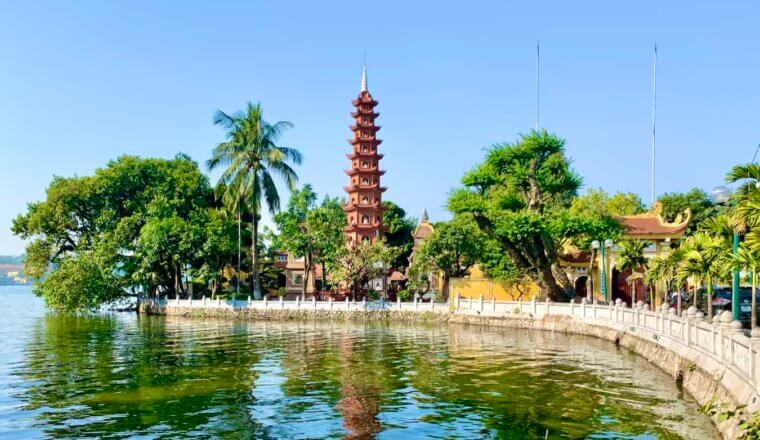
The 6 Best Hostels in Hanoi

Is Southeast Asia Safe for Travelers?
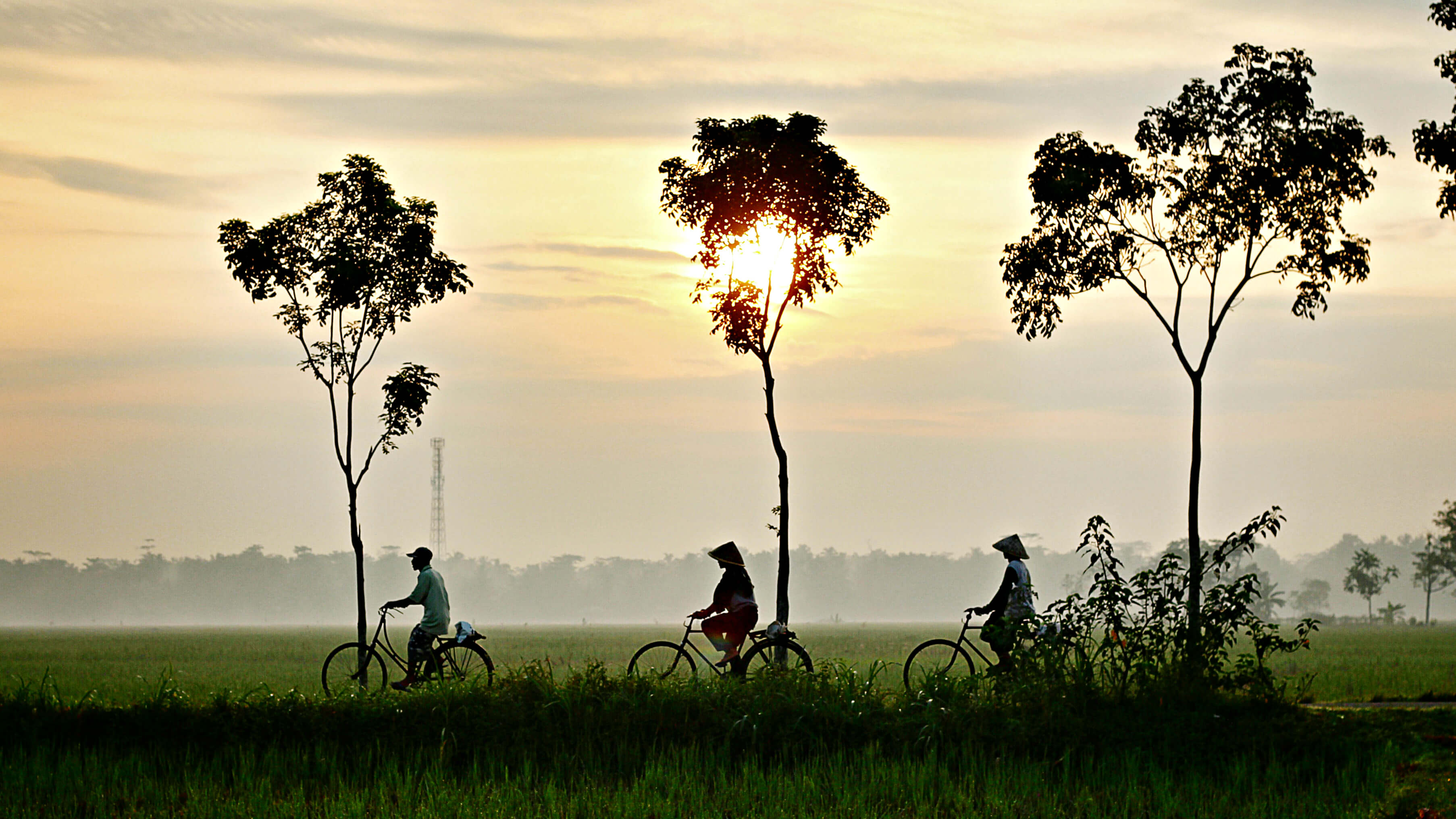
Biking the Mekong Delta in Vietnam
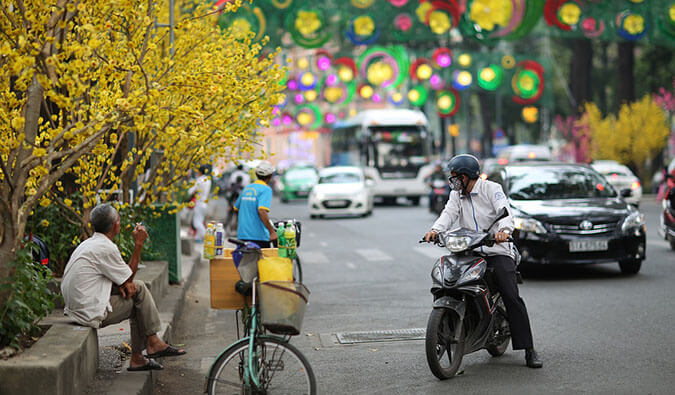
Why I’ll Never Return to Vietnam
Get your free travel starter kit.
Enter your email and get planning cheatsheets including a step by step checklist, packing list, tips cheat sheet, and more so you can plan like a pro!

- Where To Stay
- Transportation
- Booking Resources
- Related Blogs
Vietnam travel guide
This Vietnam Travel Guide is a comprehensive resource that offers essential information for travelers exploring this diverse country. It includes details on popular destinations, practicalities such as visas, currency, and language, as well as transportation options like taxis, buses, trains, and domestic flights. The guide also provides insights into the weather patterns month by month, allowing you to plan your trips accordingly. Furthermore, it offers cultural background and inspiration.
Destinations
Essential guide, getting around, vietnam weather by month.
- Inspiration
Vietnam is a country with a countless of destinations to explore, and this Vietnam travel guide highlights some of the most popular ones.
North Vietnam
Hanoi , the capital city of Vietnam, is known for its rich history, vibrant culture, and bustling street life. Visitors come to explore its charming Old Quarter, taste delicious street food, and visit iconic attractions like Hoan Kiem Lake and the Temple of Literature.
Sapa , located in the northwest of Vietnam, is renowned for its stunning terraced rice fields and ethnic minority hill tribes. Travelers flock to Sapa to trek through breathtaking landscapes, experience the unique culture of local communities, and witness the beauty of the Fansipan Mountain, known as the “Roof of Indochina.”
3. Halong Bay
Halong Bay , a UNESCO World Heritage site, is famous for its breathtaking natural beauty. Travelers visit this iconic destination to cruise along the emerald waters, marvel at the limestone karsts and islets, and explore hidden caves and floating fishing villages.
4. Ninh Binh
Ninh Binh , often referred to as the “Halong Bay on land,” captivates visitors with its stunning karst landscapes, ancient temples, and picturesque countryside. Travelers come to Ninh Binh to take boat rides through the Trang An Complex, explore the ancient capital of Hoa Lu, and enjoy the tranquility of the rural scenery.
5. Ha Giang
Ha Giang , located in the far north of Vietnam, offers adventurous travelers an off-the-beaten-path experience. Known for its dramatic mountains, winding roads, and ethnic minority communities, Ha Giang attracts visitors seeking epic motorbike journeys, trekking adventures, and cultural immersion in remote and pristine landscapes.
6. Mai Chau
Mai Chau , nestled in the peaceful valley of Hoa Binh Province, offers a serene escape from bustling cities. This rural destination is famous for its picturesque landscapes, traditional stilt houses, and warm hospitality of the Thai ethnic minority. Visitors can cycle through scenic villages, participate in local homestays, and enjoy traditional dance performances.
Central Vietnam
7. phong nha.
Phong Nha , is a paradise for nature and adventure enthusiasts. This UNESCO World Heritage Site is famous for its magnificent cave systems, including the world’s largest cave, Son Doong. You can explore the stunning underground wonders, go trekking in the lush jungle of the national park and kayak over the Son River.
Hue , the former imperial capital of Vietnam, is renowned for its historical significance and majestic citadel. Visitors come to Hue to explore its UNESCO World Heritage sites, including the Imperial City and the royal tombs, and to experience the city’s rich cultural heritage, traditional music, and delicious royal cuisine.
Da Nang , a coastal city in central Vietnam, is known for its beautiful sandy beaches, stunning bridges, and modern skyline. Travelers visit Da Nang to relax on its pristine shores, explore iconic attractions such as the Marble Mountains and the Dragon Bridge, and indulge in delicious seafood.
Hoi An , a charming ancient town, enchants visitors with its well-preserved historic architecture, lantern-lit streets, and vibrant riverside atmosphere. People flock to Hoi An to wander through its atmospheric alleys, shop for tailored clothing, immerse themselves in its lantern festival, and savor local delicacies
11. Nha Trang
Nha Trang, a coastal resort city, is famous for its turquoise waters, white sandy beaches, and vibrant underwater world. Travelers visit Nha Trang to relax on its idyllic beaches, enjoy water sports and island-hopping tours, and experience its lively nightlife and seafood dining scene.
Dalat , situated in the Central Highlands, is known as the “City of Eternal Spring” for its pleasant climate and picturesque landscapes. Visitors come to Dalat to escape the heat, explore its French colonial architecture, visit flower gardens and waterfalls, and engage in outdoor activities like hiking, biking, and canyoning amidst its natural beauty.
South Vietnam
13. ho chi minh city.
Ho Chi Minh City , the bustling metropolis of Vietnam, offers a captivating blend of modernity and history. Visitors are drawn to Ho Chi Minh City to explore its iconic landmarks like the Independence Palace and Notre-Dame Cathedral, indulge in vibrant street food, experience the vibrant nightlife, and immerse themselves in the city’s rich history and culture.
14. Mekong Delta
The Mekong Delta , a vast maze of rivers, canals, and lush green fields, is a unique region known as the “Rice Bowl” of Vietnam. Travelers venture to the Mekong Delta to cruise along its waterways, visit floating markets, witness traditional village life, and taste the fresh tropical fruits and local delicacies unique to this region.
15. Phu Quoc
Phu Quoc , a tropical paradise island, is renowned for its pristine white-sand beaches, crystal-clear waters, and stunning coral reefs. Visitors flock to Phu Quoc to relax on its picturesque beaches, explore its national parks, indulge in water activities such as snorkeling and diving, and savor the island’s fresh seafood.
16. Con Dao
Con Dao , a secluded archipelago, offers unspoiled natural beauty and a rich historical background. Travelers seek out Con Dao for its pristine beaches, lush forests, and diverse marine life, as well as to discover its haunting history at the former prison complex, Con Dao Prison. The island provides a tranquil retreat for relaxation, outdoor activities, and exploring its captivating landscapes.
Mui Ne , a coastal town, is renowned for its stunning sand dunes, vibrant kite-surfing scene, and serene fishing villages. Visitors come to Mui Ne to witness the dramatic landscapes of the Red and White Sand Dunes, engage in water sports, taste fresh seafood, and enjoy the laid-back beach atmosphere and stunning sunsets.
Off the beaten track destinations
Explore the off the beaten track destinations in Vietnam: Cao Bang , home to the stunning Ban Gioc Waterfall ; Mu Cang Chai , renowned for its breathtaking terraced rice fields; Quy Nhon , a tranquil beach town; Kon Tum, where you can discover the mountains and ethnic minorities of the central highlands. Experience the unspoiled beauty of Lan Ha Bay and Bai Tu Long Bay , the lesser-known siblings of Halong Bay. Visit Cat Ba, the largest island in the bay, and uncover the hidden gem of Ba Be Lake , the largest natural lake nestled in the jungle.
Health & Safety
When traveling to Vietnam, it’s important to be aware of certain health and safety considerations.
Mosquitoes are prevalent, especially in certain regions, so it’s advisable to use mosquito repellent and take precautions to prevent mosquito-borne diseases like dengue fever or malaria.
Road safety can be a concern, with chaotic traffic and different driving habits, so it’s recommended to exercise caution and use designated pedestrian crossings.
It’s advisable to avoid drinking tap water and instead opt for bottled or filtered water to prevent waterborne illnesses.
Additionally, practicing good food safety by eating freshly cooked or hot meals, avoiding street food stalls with questionable hygiene practices, and practicing proper hand hygiene can help prevent food-related illnesses.
It’s always recommended to consult with a healthcare professional or travel health clinic before your trip for personalized advice on vaccinations and health preparations.
Vietnam is generally a safe destination for travelers, with a low rate of crime targeting foreign visitors; however, it’s important to remain vigilant and take precautions against petty theft, such as keeping a close eye on personal belongings and being aware of common scams.
Money & budget
Vietnam’s official currency is the Vietnamese Dong (VND), and it’s advisable to carry local currency for most transactions as other currencies are not accepted. Banks and authorized currency exchange offices are the best places to exchange foreign currencies, but interestingly, gold jewelry shops often offer competitive exchange rates.
The average cost of a trip to Vietnam varies depending on your travel style. For budget travelers, a weekly average budget can range from $150 to $300, including accommodation, meals, transportation, and some sightseeing. Midrange travelers can expect to spend around $300 to $700 per week, while luxury travelers may have a budget of $700 and above per week.
In Vietnam, there is no tipping culture , and service charges are usually included in the bill. However, it’s appreciated to give small tips for exceptional service. ATMs are widely available throughout the country, but it’s important to note that there may be limits on the amount you can withdraw per transaction. Additionally, many local shops and restaurants may not accept card payments, so it’s advisable to carry enough cash for smaller purchases.
Internet & calling
Vietnam has a widespread availability of Wi-Fi networks, ranging from local restaurants and coffee shops to upscale resorts. As a customer, you can typically access these Wi-Fi networks for free.
However, to ensure a reliable internet connection and avoid dependence on Wi-Fi, it is recommended to buy a Vietnamese SIM card . SIM cards are affordable and convenient, allowing you to have internet access for various purposes such as navigating with Google Maps, using Google Translate, booking taxis through ride-hailing apps, or checking reviews on platforms like TripAdvisor. While there are several providers to choose from, Viettel is generally considered the best option for its coverage and reliability.
Electricity & socket adapters
The voltage in Vietnam is typically 220V, and the sockets commonly used have 2 pins , accommodating both flat and round pins. If your devices use a different type of plug, you can either bring a travel adapter with you or easily purchase one in Vietnam at one of the many convenient stores available.
Traveling to Vietnam
Before traveling to Vietnam, it is essential to check the visa requirements for your country. While a few countries, including 11 European countries, are eligible for visa-free entry , allowing a maximum stay of 15 days, those wishing to stay longer or coming from other countries such as the US, Australia, Canada, or New Zealand, must arrange a valid visa before their trip.
For most travelers, the e-visa is the recommended option, which can be easily obtained through the official website of the Vietnamese immigration. The e-visa process typically takes 3 to 4 working days, costs 25 USD, and allows a stay of up to 30 days in Vietnam.
Arrival options
Unlike major hub cities like Hong Kong, Singapore, Bangkok, and Kuala Lumpur, Vietnam doesn’t have as many international direct flights from the US, Australia, and Europe, often requiring a transit. It’s important to note that even when boarding your flight to Vietnam, you need to show a valid visa.
In addition to flights, Vietnam can be accessed by land borders from countries such as Cambodia, Laos, and China. Another option is entering Vietnam via a seaport. Fortunately, all of these entry options, including land and seaports, are possible with an e-visa.
Long distance
1. domestic flights.
Domestic flights in Vietnam are a great option for traveling within the country, offering convenience and affordability. With tickets that can be as cheap as $40 USD, it’s an excellent alternative to avoid long journeys by bus. Vietnam has three major airlines, namely Vietnam Airlines, Vietjet Air, and Bamboo Airways, providing extensive coverage to numerous domestic airports across the country, totaling around 21 airports.
2. Bus travel
Bus travel in Vietnam is a popular and extensive mode of transportation, with a network that connects every corner of the country. It is known for being very affordable, making it an economical choice for budget-conscious travelers. There are various options available, including day buses and sleeper buses, with different classes such as smaller limousine buses, VIP sleeper buses, normal sleeper buses, and mini vans. Opting for the luxury options may provide a more comfortable and enjoyable experience without a significant increase in cost.
3. Train travel
Train travel in Vietnam offers a unique and nostalgic experience, allowing you to soak in the scenic beauty of the country at a more relaxed pace. While trains may be slower compared to buses, they are generally considered a safer mode of transportation. Depending on your preference and budget, trains offer various options including hard seat, soft seat, and different cabin configurations such as 4 berth and 6 berth cabins. For popular routes like Sapa to Hanoi, there are tourist trains available, providing additional comfort for the journey.
4. Private transfers
Private transfers in Vietnam offer convenience and flexibility for travelers, as foreign tourists are not permitted to drive cars themselves. Renting a car with a driver allows for comfortable and hassle-free transportation, whether for airport transfers or exploring different destinations. Moreover, private transfers can be customized to include stops along the way, giving you the opportunity to create your own personalized tour or embark on a multi-day trip to discover the diverse landscapes of Vietnam.
Short distance
5. public transportation.
While public transportation options like the metro and buses exist in Vietnam, they are often underutilized by tourists. The metro system is still in its early stages of development, and communication barriers can make it difficult to navigate public bus routes. However, the biggest reason not to use public transportation in Vietnam is the way better alternative of using taxis.
Taxis in Vietnam are an affordable and convenient mode of transportation, offering door-to-door service for travelers. Additionally, taxi apps like Grab have gained popularity, providing an effortless way to book a taxi and communicate your destination, effectively overcoming any language barriers you may encounter.
Walking in Vietnam’s cities can be challenging as sidewalks are often in poor condition and occupied by parked motorbikes, forcing pedestrians to walk on the main road. Crossing roads can also be a daunting task, unless you come across a traffic light. Generally, Vietnam is not considered pedestrian-friendly in urban areas.
However, outside the cities, there are excellent opportunities for trekking in Vietnam , allowing you to explore beautiful landscapes, such as rice fields, jungles, and smaller villages.
Other options for getting around
Apart from practical transportation options, there are leisurely alternatives for getting around in Vietnam. Cycling is a fantastic way to explore the peaceful cities and picturesque countryside, offering a closer connection to the surroundings.
Cyclo rides provide a unique and authentic local experience, allowing you to leisurely explore the streets and soak in the vibrant atmosphere. Boats and cruises are popular for discovering the rivers, canals, and stunning landscapes of the Mekong Delta and the famous Halong Bay.
Best time to visit Vietnam
Vietnam experiences three distinct weather regions due to its elongated shape. Each region has its own best time to visit , making it somewhat challenging to pinpoint a single ideal time. However, if you’re looking for a period that aligns with all three regions, the best time to visit is generally from January to May, with March being particularly favorable.
Northern Vietnam : In the north, the weather is divided into four seasons. From January to March, it is often chilly with occasional fog in Hanoi and Halong Bay. Spring (April and May) brings pleasant temperatures and blooming flowers. Summer (June to August) is hot and humid, while autumn (September to December) offers cooler temperatures and clearer skies.
Central Vietnam : Central Vietnam has a tropical climate with distinct wet and dry seasons. From January to August, the weather is relatively dry, making it a good time to visit cities like Hue and Hoi An. However, be aware of potential typhoons from August to November. The region also experiences high temperatures in the summer months.
Southern Vietnam : Southern Vietnam has a tropical climate with two main seasons – dry and wet. From November to April, the dry season prevails, characterized by lower humidity and pleasant temperatures. May to October is the wet season, with frequent rainfall and higher temperatures. Ho Chi Minh City and the Mekong Delta are popular destinations in this region.
Vietnam by month
With so many incredible destinations to choose from in Vietnam, it can be overwhelming to decide where to go. Here are some inspiring recommendations to help you plan your trip:
- For the best rice fields , consider visiting Sapa, which is easily accessible and boasts vast landscapes. Alternatively, Pu Luong offers smaller, less touristy rice fields but requires a bit more effort to reach.
- When it comes to beautiful beaches , Phu Quoc is renowned for its stunning shores. Along the central coast, you’ll also find picturesque beaches in Hoi An, Quy Nhon, Phu Yen, and Nha Trang.
- Seeking adventure? Embark on a thrilling motorbike journey in Ha Giang, explore captivating caves in Phong Nha on caving expeditions, or try canyoning in the scenic town of Dalat.
- Vietnam is home to some of the most beautiful cities , including the charming ancient town of Hoi An, the bustling capital city of Hanoi, the historic city of Hue, and the picturesque hill station of Dalat.
- If trekking is your passion, head to Sapa, Ha Giang, Pu Luong, or other mountainous regions for unforgettable hiking experiences amidst breathtaking landscapes.
- For nature enthusiasts, Ha Giang, Sapa, Ninh Binh, Halong Bay, and Ban Gioc Waterfall offer spectacular natural wonders to explore and admire.
For more inspiration and detailed information about these and other remarkable destinations in Vietnam, you can check out our Vietnam inspiration list .
Vietnamese culture
To fully immerse yourself in Vietnamese culture, here are some helpful tips to enhance your experience:
- Embrace Vietnam’s culinary pride by indulging in local cuisine. Take a street food tour or join a cooking class to discover the diverse flavors and ingredients that make Vietnamese food so renowned.
- Vietnam is home to 54 ethnic groups , each with its own unique traditions. Learn from them by visiting ethnic markets, staying at homestays, and exploring villages to gain insights into their customs, arts, and way of life.
- Gain a deeper understanding of Vietnam’s history by learning about the Vietnam War . Visit significant sites such as the Cu Chi Tunnels and the War Remnants Museum , which provide valuable perspectives on the country’s past.
- When visiting temples and pagodas, dress appropriately by covering your shoulders, wearing modest clothing, and removing your shoes as a sign of respect.
- Make an effort to learn some basic Vietnamese phrases . While many Vietnamese may not speak fluent English, they appreciate and welcome your attempts to communicate in their language.
- Celebrate special events with the locals, such as Tet (Lunar New Year), Mid-Autumn Festival , or National Day . Participate in traditional festivities, enjoy local customs, and savor the festive atmosphere.
- When entering someone’s home or certain establishments, it is customary to remove your shoes as a gesture of cleanliness and respect.
- Always ask for permission before taking photos of people, as it shows respect for their privacy and personal space.
- Avoid any disrespectful actions towards the national flag or the country’s leaders. Show reverence and sensitivity towards symbols of national importance.
- Explore traditional craft villages to witness artisans practicing age-old crafts, such as pottery, silk weaving, or wood carving. This provides an opportunity to appreciate Vietnam’s rich artistic heritage.
- Join locals for a casual beer-drinking experience on the street. Sidewalk stalls offer a social and lively atmosphere where you can engage with Vietnamese people and soak up the local culture.
- Experience the warmth of Vietnamese hospitality by joining a family dinner. Embrace the tradition of sharing abundant food and engaging in lively conversations, creating lasting memories of authentic Vietnamese hospitality.
- Ho Chi Minh City
- Mekong Delta
- Language & travel dictionary
- Electricity
- Internet & calling
- Best travel time & weather
- Hoe does it work?
- Visa on Arrival
- Visa at embassy
- Holidays & Events
- People & minorities
- Flights to Vietnam
- Domestic flights
- Motorbike buy/rent
- Train travel
- 15 most beautiful destinations
- 20 best things to do
- 10 best off the beaten track
- 10 most stunning beaches
- 10 best rice fields places
- 10 best adventures
- 10 cultural experience
- All travel inspiration
- Package trips
- Custom made trip
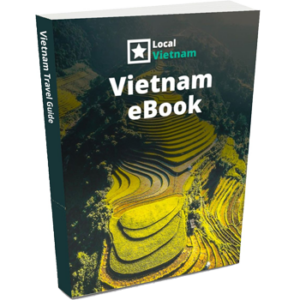
- Destination Guide
- Essential Guide
- Getting Around
- Vietnam Month by Month
- Vietnam blog
- Travel tips
- Custom Made Trip
- Day- & Multiple Day tours
- Holiday Packages
- Local Meo Vac Homestay
- Local Dong Van Homestay
- Our Team & Company
- Our Customers & Reviews
Copyright © 2023 Local Vietnam
Start typing and press enter to search
Free ebook vietnam travel guide.

A first-time guide to Vietnam

Aug 21, 2024 • 7 min read

The caves at Phong Nha – Ke Bang National Park number among Vietnam’s many surprises for visitors. Huy Thoai/Shutterstock
Gone is the era when Vietnam evoked only images of rice fields, floating markets and conical-hat-wearing workers. This Southeast Asian powerhouse has today become a destination known for majestic natural beauty , pristine beaches , unexplored ecological reserves and delectable cuisines.
Halong Bay, Hoi An’s Old Town , Phong Nha – Ke Bang National Park and other Vietnamese sites have joined the UNESCO World Heritage roster. Staple Vietnamese foods like banh mi and pho are common enough to appear in English-language dictionaries. Some of the most discerning travelers in the world are ranking Phu Quoc with the Maldives and Bali on lists of the world’s most beautiful islands.
And that’s only the beginning of what this country has to offer .

The best time to visit Vietnam
Vietnam is nearly 1650km (1025 miles) from north to south – a length that ensures weather patterns vary widely, and that the best time to visit depends very much on your planned destinations and personal preferences. Most visitors will want to avoid the stormy season, especially in Northern Vietnam and Central Vietnam , as violent rainstorms often lead to flash floods, mudslides and road closures. In contrast, the southern storm season (June to November), while inconvenient, does not pose nearly as significant a risk to travelers.
The storm season starts from May and ends around October in the north; from September to December in the central coastal regions; and from May to August in the central highland regions.
Other than that, the country climate is separated into three general zones:
- In North Vietnam (Hanoi, Sapa, Ha Giang, Halong Bay) in September and November or March and April, the weather is cool and dry and the local tourism sector is not overwhelmed by intra-Vietnamese travel. August and September are also Sapa’s harvest season and the best time to highland hills in vibrant bloom.
- Central Vietnam (Hoi An, Nha Trang, Hue, Danang) is best visited from April to August, when you’ll avoid the worst of the storm and flood season and abundant sunshine will help you make the most of the white-sand beaches around Hoi An and Nha Trang.
- We recommend visiting South Vietnam (Ho Chi Minh City, Mekong Delta, Phu Quoc) from October to April, after plentiful rains from the prior months ensure the rivers and channels of the Mekong Delta are abundantly fed, allowing for smooth travel through this maze of crisscrossing waterways.
We’d recommend avoiding visits during major holidays like Tet (the Vietnamese New Year, usually in late January or early February) due to soaring prices and booked-out accommodations.

How much time should I spend in Vietnam?
To experience the full breadth of experiences here? Months. Acknowledging that’s unlikely for most visitors , two weeks will get you through most of Vietnam’s best-known destinations.
Starting from either Hanoi or Ho Chi Minh City (HCMC), you can travel the length of the country and enjoy a wealth of sights, tastes and experiences. Must-visit places include iconic favorites Sapa and Halong Bay; cultural and historical hot spots such as Hoi An and Hue ; river capitals like Can Tho and the sprawling Mekong Delta that surrounds it; and the tropical island paradise of Phu Quoc .
If you’re short on time or money, quick trips of three to four days focusing on a singular area or city like Hanoi, Ho Chi Minh City or Phu Quoc are feasible and offer a satisfying taste of Vietnam’s attractions.
Getting around Vietnam
Vietnam has three major international airports, in Hanoi, Ho Chi Minh City and Danang (the gateway to Hoi An and Hue). In addition, Phu Quoc Island has its own international airport with direct flights to Singapore, Shanghai, Cambodia and Laos – and the airport at Phan Thiet will launch international flights in 2025.
Traveling within Vietnam itself is relatively easy and affordable , with options including trains, buses and domestic flights. Flights are the most convenient and speedy way to travel within the country. Buses are affordable, reach almost everywhere in the country and offer sleeper options for those who want to get between north and south without stopping overnight. In recent years, renewed interest has led to a few train lines being refurbished and revitalized . These days, traveling by train is a great option for those who want to take their time enjoying the scenic routes across the country.
Within cities, cabs, rideshare apps like Grab or Be , and traditional motorbike taxis are easily accessible. For those with the stomach for chaotic traffic, most Vietnamese cities are walkable and a lot of fun to explore on foot – although the tropical heat and humidity coupled with urban city dust and exhaust can make walking long distances unpleasant.

Top things to do in Vietnam
All the thrilling things you can do in Vietnam could never fit all on one list. Yet first-time visitors won’t want to pass up a few key experiences.
Cruise Halong Bay . This stunning UNESCO World Heritage Site comprises nearly 2000 towering limestone islands in a massive blue-water bay. An overnight cruise is the best way to take it all in. If you happen to have some extra time, Lan Ha Bay is to the south of Halong: it’s no less beautiful but much less traveled.
Explore Hoi An . With its lantern-lit streets and turbo-speed tailor shops, this ancient town seems frozen in time. In the countryside surrounding the town, a plethora of traditional craft villages await to be explored.
Climb down the Cu Chi Tunnels . This warren of war-era tunnels is already a heart-stopping experience – and as of early 2024, night tours have been offered to travelers with nerves of steel and a taste for reliving wartime thrills.
Hike the highland trails of Sapa . The Northwest Highlands are famous for majestic trails and stunning natural beauty. Sapa serves as the landing pad and base camp for adventurous trekkers looking to explore the rugged region on foot.
Wander the Old Quarter of Hanoi. Get lost in this maze of narrow streets, each named after the goods once sold here. It’s a great place to experience Vietnamese street culture and food .

My favorite thing to do in Vietnam
My favorite thing about Vietnam? The food .
Beyond pho and banh mi, you can slurp up more than 200 distinct noodle dishes from every corner of Vietnam. There are foods unique to a single town. There are herbs unique to a certain patch of a single forest. There are cuisines designed to suit the palates of emperors past. There are simple and humble, cheap and hearty dishes meant to fill peasants’ stomachs.
There’s much to learn about the history of Vietnam and its people through the food they cook to nurture each other. My low-key dream is to travel to every town in Vietnam and try its specialty dish – and hear the backstory behind it. (There’s almost always some wacky story attached to a hometown favorite.) That would make quite a book.
How much money do I need for Vietnam?
While you’ll find luxury resorts, world-class dining and premium experiences in certain parts of Vietnam, the country retains its well-earned reputation for budget travel .
- Hostel room: US$10–15
- Basic room for two: US$10–40
- Self-catering apartment (including Airbnb): US$20–50
- Local bus ticket: US$0.20–1
- Coffee: US$1–3
- Banh mi: US$1–3 (note that the famous and drama-filled Madam Huynh Banh Mi in HCMC charges $3 per sandwich – and one can easily feed two regular adults or one starving weightlifter)
- Dinner for two in a local sit-down restaurant: US$10–30
- Beer: US$1–2 per can; $3 per liter of draft beer at a local beer hall

More tips for enjoying Vietnam
Bring lots of layers, no matter the season.
Especially if you are traveling the length of Vietnam. The country’s climate varies greatly within short distances, so packing for different temperatures and weather conditions is the prudent thing to do.
Respect local customs and etiquette
As in other Asian nations, the Vietnamese value politeness and respect. When visiting temples, remember to dress modestly, and always remove shoes when entering someone’s home.
Stay away from tap water, and choose your street foods carefully
Tap water in Vietnam is not safe to drink, so stick to bottled water everywhere. Enjoying street food is an essential Vietnamese experience – but since food hygiene can be an issue, observe the locals and choose the street vendors they favor.
Prepare for chaotic traffic
The joke in Ho Chi Minh City and Hanoi is that traffic laws are more like suggestions, so be cautious when crossing streets and only consider renting motorbikes if you are an experienced driver.
A few words in Vietnamese go a long way
You can expect English to be fairly widely spoken in Vietnam, especially in big cities. Still, learning a few basic phrases in Vietnamese can only help – and will likely go a long way in demonstrating respect to and forming connections with locals.
This article was first published Aug 12, 2019 and updated Aug 21, 2024.
Explore related stories

Sep 23, 2024 • 8 min read
Ho Chi Minh City is fast-paced and fabulous, but brilliant day trips await nearby in the Mekong Delta. Here are our top day trips from Ho Chi Minh City.

Aug 27, 2024 • 11 min read

Aug 20, 2024 • 13 min read

Aug 12, 2024 • 12 min read

Jul 19, 2024 • 5 min read

Jul 12, 2024 • 11 min read

Jul 10, 2024 • 6 min read

Jun 21, 2024 • 9 min read

Feb 29, 2024 • 11 min read

Feb 19, 2024 • 6 min read
Travel Guide Vietnam
Book your individual trip , stress-free with local travel experts
Select Month
- roughguides.com
- Travel guide
- Itineraries
- Local Experts
- Travel Advice
- Accommodation
Plan your tailor-made trip with a local expert
Book securely with money-back guarantee
Travel stress-free with local assistance and 24/7 support
Elisabeth and Alain Wilbois
This e-mail is to express how we enjoyed the trip we had with Henry as driver and guide, all over Malaysia. Henry was very committed in his role: he could ...
Despite its tumultuous history, Vietnam has bounced back to become a big-hitter on the Southeast Asian travel circuit. Unsurprisingly, from a country so long and skinny, there’s plenty of variety on offer: emerald paddy fields and white-sand beaches, full-tilt cities and venerable pagodas, limestone islands looming dramatically out of the sea, vast caves, craggy mountains, and friendly minority communities – with their elaborate tribal costumes and age-old customs. Travel to Vietnam and you’ll be met with warmth and curiosity. Add to that, some of the region’s most nuanced cuisine, and you’re onto a winner.
Where to go in Vietnam
Best time to travel to vietnam.
- How to get to Vietnam
Top 7 best places to visit in Vietnam
Vietnam travel itineraries.
While Hanoi , Ho Chi Minh City and the other major centres are intriguing enough, it’s Vietnam’s striking landscape that most impresses. Rugged mountains hug the west, bordering Cambodia and Laos ; to the east lies the South China Sea – or the East Sea, as the Vietnamese call it. To the north and south, the land fantails out into the splendid deltas of the Red River and the Mekong , and it’s in these regions that you’ll encounter the paddy fields, dragonflies, buffaloes and conical-hatted farmers that constitute the classic images of Vietnam.
As for wildlife, the discovery in recent years of several previously unknown species of plants, birds and animals showcases the wealth of Vietnam’s biodiversity. This makes the improving access to the country’s national parks all the more gratifying for travellers wanting to visit Vietnam.
- Spoken language : Vietnamese (majority of population).
- Official unit of currency : dong (VND ₫).
- Population : 95 million. Around two-thirds live in the countryside (one of the highest rural population densities in Southeast Asia), yet the country has a literacy rate of around 95 percent.
- Tourist numbers : two million in 2000; fifteen million in 2018.
- Politics : The Socialist Republic of Vietnam (capital Hanoi), is one of the world’s last surviving one-party Communist states. It shares land borders with China, Laos and Cambodia and comprises over 330,000 square kilometres, with more than 3400km of coastline.
- UNESCO World Heritage sites : Vietnam has eight. Phong Nha-Ke Bang National Park is home to Hang Son Doong, the world’s known largest cave.
- Visas: Some nationalities are exempt from visa requirements. Travellers from the UK need a visa if staying longer than 45 days. Find out more and get your Vietnam visa .
Want to know even more useful information about Vietnam before your trip? Read our Vietnam travel tips .
Travel to Vietnam and you’ll discover there is no shortage of beautiful and intriguing places to explore. Experience the buzz of vibrant Ho Chi Minh City, or captivating Hanoi, with its lively Old Quarter and mouth-watering street food, while the alluring riverside town of historic Hoi An in central Vietnam makes for a more mellow experience.
The Central Highlands affords fantastic trekking opportunities and other outdoor pursuits, with the breezy mountain town of Da Lat providing the ideal base, while a visit to the remote upland regions of central and northern Vietnam is likely to focus on the ethnic minorities who reside there.
Explore the pancake-flat rice lands of the Mekong Delta with its wonderful floating markets, and meander between Ha Long Bay ’s striking limestone forested islands.
Of course, a visit to Vietnam wouldn’t be complete without some relaxing beach time . Take your pick from the gorgeous golden beaches in the south, such as Doc Let beach, on the Hon Khoi Peninsula, and enjoy some superb swimming and snorkeling – as well as exquisite seafood.

Sunrise in Golden Valley near Da Lat © TBone Lee/Shutterstock
Discover more places in Vietnam

- North Vietnam Travel Guide
- The Mekong Delta, Vietnam
- The northern coast Travel Guide
- The Southern Coast Travel Guide
Vietnam is long and slender, with different regions subject to different weather conditions at any one time, which makes figuring out the best time to visit Vietnam somewhat tricky.
The country has a tropical monsoon climate. If you’re visiting the south of the country the driest months tend to be between December and April, while the north of the country is typically driest in spring and autumn.
Within this broad weather picture are regional variations, with differences in altitude also key to varying temperatures. Whereas the south tends to have a year-round tropical climate, the north is considerably cooler in winter.
You can still enjoy a visit to Vietnam during the rainy season, but it’s worth bearing in mind that if you’re intending to go trekking, monsoon downpours can mean flooding in certain areas, and transport can be severely disrupted. You’ll also have to put up with a lot more mosquitoes. On the plus side, there are fewer visitors. Find out more about the best time to visit Vietnam here .
The number of international flights heading to Vietnam has been steadily increasing of late – a fair sign of the country’s burgeoning popularity as a tourist destination.
The vast majority of visitors fly into Ho Chi Minh City and Hanoi, although a fair chunk of visitors still take the cheaper option of an indirect flight routed through Bangkok, Singapore or Hong Kong.
Taking an indirect flight might be your only option if there are no direct flights available from where you intend to travel. While you can fly direct from London, for example, there are no direct flights from Ireland, North America, New Zealand, and very few from Australia. Take a look at Skyscanner for options.
If you’re coming from one of Vietnam’s neighbouring countries, you can fly from several cities, taking advantage of the low cost flights available through budget airlines.
Or, you can enter Vietnam overland from China , Laos, or Cambodia. It’s pretty simple as long as you have the appropriate visa, and this option means you can see more of the region than you would if you simply jetted in.
There are several options for travel within Vietnam. Though still a little rough around the edges, its transport network is continuing to improve. Comfortable buses operate regularly and fares are cheap, or you can travel by coach. If you’re going long distances, booking a berth on an overnight train could be an appealing option. Or, there are cheap domestic flights available, making it possible to visit different ends of the country in a short space of time. Read more about how to get to Vietnam and how to get around Vietnam .

Bout tours around Ha Long Bay © S-F/Shutterstock
1. Sample Hoi An delicacies
Little Hoi An has an almost bewildering selection of mouth-wateringly good restaurants, offering up specialities, such as Cao Lau – rice-flour noodles in soup flavoured with mint and star anise, topped with slices of pork, bean sprouts and pork-rind croutons. The elegant restaurant Morning Glory is one of the best places to try it, along with other superbly prepared dishes, for a reasonable price. You can also try your hand at Vietnamese cooking by taking one of many cookery classes available in town.
Discover 10 Vietnamese foods you need to try .
2. Cruise around Ha Long Bay
An exploration of Ha Long Bay in northern Vietnam is a must for any visit to Vietnam. Dramatic limestone rock formations which jut straight up from the water make up the two thousand or so forested islands. Visit the enchanting caves via one of the tours available and, if you can, make time for one of the three-day tours, as you get to spend a night at sea. Swimming and kayaking around the bay’s bright green waters is a glorious experience.
Looking for ideas for exploring North Vietnam? You'll find it in our North Vietnam itineraries .
3. Trek around Sa Pa
On a clear day the views around Sa Pa in the far north of Vietnam are breathtaking. Lush terraced rice fields line the steep valley and mountains loom from all sides. It’s the gateway to fantastic trekking country and the reason most visitors come here. Explore the Hoang Lien Son Mountain range, home to Fan Si Pan, Vietnam’s highest mountain, and visit the small ethnic communities still living a traditional way of life.
4. Relax on Phu Quoc Island
Picture postcard Phu Quoc island in the Gulf of Thailand is no longer a well-kept secret. Word is out about its powdery white-sand beaches facing glorious sunsets, its dense jungle, and the laid-back atmosphere of the island. But even though visitor numbers are up, there is still plenty of unspoiled creamy soft sand in which to dig your toes. You can also paddle around the bays in a kayak, or dive around the reefs, weaving among colourful tropical fish and perhaps a hawksbill turtle.
Around half of the island is part of a UNESCO-listed national park and remains pretty much untouched. You’ll find hiking trails in its tropical rainforests, and a fantastic array of wildlife.
Zipping on a motorbike is a great way to explore the island’s back roads and quiet fishing villages.
5. Hike and bike around Da Lat
Dubbed the city of Eternal Spring for its year-round cool climate, this former hill station in the Central Highlands, with its winding streets and French colonial-era villas, is the place to head when the heat in cities below becomes stifling. Combine a visit to the splendid Bao Dai’s Summer Palace with the Crazy House, a fairytale riot of twisted cement.
But it’s the area surrounding Da Lat that’s the big draw. Fragrant pine forests and dramatic waterfalls beckon, and alongside hiking there’s the opportunity for mountain biking and rock climbing – or, for those seeking greater thrills, canyoning. You can also rent a motorbike for a bit of adventure, and it’s a great way to explore more of the area.
For a more sedate experience, enjoy the beautiful view via the cable car to the Truc Lam Pagoda.
6. Stay in a Stilthouse on The Pu Luong Nature Reserve
This spectacular nature reserve in the northern coastal area of Vietnam is as yet comparatively unknown to outsiders. Trek amid magnificent rice terraces, and visit the white Thai or Muong minority groups, some of which offer home-stay accommodation. You can help prepare a meal and join in with family life, and then bed down in a thatched stilthouse.
7. Soak up the sights and smells of Hanoi
A visit to Vietnam wouldn’t be complete without a visit to its capital city. Hanoi , with its constant buzz of motorbikes and general hubbub is the place to experience city life at full throttle. Wander the sinuous streets of the Old Quarter, with its narrow red roofed tube-houses, temples and pagodas, and whir of street vendors. Perch on a plastic stool and watch the hectic world go by over a cup of Vietnamese coffee or glass of beer.
Check out the atmospheric French Quarter, with its impressive Opera House, and visit the many cultural and historical sites, such as the Ho Chi Minh Mausoleum and Museum of Ethnology.
Everywhere you go you’ll be hit with the scent of delicious street food, such as the traditional breakfast dish of pho, a beef noodle soup.

Busy streets of Hanoi © John Bill/Shutterstock
The carefully created travel itineraries in our Vietnam travel guide will inspire and help you make the most of your trip. Combining the classic tourist sights and busy cities with laidback beaches, quiet temples and remote mountain villages, where you’d be hard-pushed to find another visitor, there’s an itinerary to match your interests and suit your time frame – whether you have a month to travel in Vietnam, or just a week or two. And don’t worry about seeing everything – each of the routes will give you a good taste of the country.
Travel ideas for Vietnam
Created by local experts

Vietnam Culinary Discovery
Vietnamese cuisine can be divided into three categories, each pertaining to a specific region, namely the North, Centre and South. You will visit all of these on this culinary tour of Vietnam. Awaken all of your senses to the wonderful sights, sounds and aromas of this fascinating country.

Very Vietnam
Vietnam is full of surprises, seamlessly mixing both ancient and modern. See rice paddies, traditional villages, markets, temples and pagodas. Discover romantic cities, cruise around mystical Halong Bay, laze on pristine beaches and get out and about in exuberant Ho Chi Minh City.

Cultural Saigon
Southern Vietnam is home to modern Ho Chi Minh City, a vibrant southern capital full of historic attraction and old Saigonese charm. Soak up some café culture, enjoy authentic street food, and get a taste of the city’s thriving markets.

Southern Vietnam Explored
Discover the charms of Southern Vietnam. From the excitement of Ho Chi Minh City to the sleepy scenic canals of the Mekong Delta with its traditional villages and floating markets, Vietnam’s deep south is one of the most appealing parts of the country.

Vietnam Culinary Experience
Embark on a Vietnamese culinary adventure, taking cooking classes in Ho Chi Minh City and Hanoi. Get cultural in the imperial city of Hue with a visit to some royal tombs, cruise around stunning Halong Bay a final stay in nostalgic Hanoi before your return home.

Ancient Meets Modern
A trip to Vietnam offers a unique adventure. From ancient Hanoi to imperial, romantic Hue, coastal Hoi An with its atmospheric ruins to burgeoning Saigon or Ho Chi Minh City as it is known today, Vietnam is both an exciting and a rewarding destination.
If you have a month to travel around Vietnam the Grand Tour could be the one for you: it’s the classic itinerary, packing in the essential sights, bustling cities, beautiful beaches, rural Vietnam, and much more. If you have a week or two and want to focus on Vietnam’s ethnic minority groups residing in the north, the Ethnic Culture tour is ideal. And if you have just a week and want to get off the beaten track go for the Unseen Mekong Delta itinerary.
Below is a sample itinerary, ideal for the first-time visitor to Vietnam, but you can see all our itineraries here .
Quintessential Vietnam
You’ll get a taste of everything with this itinerary: big cities, historical and cultural sights, idyllic beaches, boat trips, intriguing caves, unspoiled countryside, homestays in rural villages, and more. Allow sixteen days, or longer if you want to take things at a more relaxed pace.
Start off your tour in Vietnam’s capital and enjoy its busy yet laid-back vibes. Visit some of the principal sights in Hanoi : the Ho Chi Minh Mausoleum, and the nearby One-Pillar Pagoda, the Military History Museum, or the Ethnology Museum, and the Temple of Literature, Vietnam’s principal Confucian sanctuary and its historical centre of learning. Wander around the Old Quarter and take a stroll around Hoan Kiem Lake. Sample delicious street food and watch a traditional water puppet show in one of the famous theatres.
2. Ha Long Bay
Take a two-day boat tour around some of the two thousand or so dramatic limestone islands and intriguing caves of the World Heritage Site Ha Long Bay , Vietnam’s top draw. Enjoy the magical scenery while swimming in the emerald green waters around Titov island beach. Tours can be arranged from Hanoi.
3. Mai Chau and Ninh Binh
Just a few hours away by road Hanoi, The Mai Chau valley is largely unspoiled.
Hop on a bicycle and explore the surrounding rice paddies nestled against forested mountains, and wander around Mai Chau’s bustling morning market. Then visit the nearby White Thai villages to spend the night in a homestay.
Drive to Ninh Binh, the ideal base from which to visit beautiful Tam Coc, essentially a miniature landlocked version of Ha Long Bay, and an easy cycle ride from Ninh Binh. Take a boat trip through the limestone tunnels and between karst hills to the three long, tunnel caves at Tam Coc itself.
Travel to the engaging city of Hue and take a day-long boat trip along the Perfume River to visit the Thien Mu Pagoda and Hon Chen Temple, the Imperial City, and the Tu Duc mausoleum. At the end of the day have a wander through the lively Dong Ba Market.
The next morning take a bicycle, or tour by cyclo, along the north bank of the river to tranquil Kim Long village, where mandarins and other Imperial officials built their houses surrounded by lush gardens, in the late nineteenth century.
Drive to Da Nang via the Hai Van Pass, or “Pass of the Ocean Clouds”, taking in the superb views of Da Nang Bay. Stop off at the Cham Museum in Da Nang, with its impressive display of terracotta and sandstone figures. Then continue to Hoi An .
Wander the narrow streets, soaking up historic Hoi An’s charming old-world atmosphere, with its old merchants houses and wooden-fronted shops. Visit some of the sights, such as the Phuoc Kien assembly hall, the Museum of History and Culture and the beautifully preserved eighteenth-century Tan Ky House. It’s worth tying in your visit to coincide with its monthly lantern festivals – candle-lit paper lanterns meandering down the river is a magical sight.
Don't have a lot of time at your disposal? Our 5-day Vietnam itineraries will come to your rescue.

The riverside town of Hoi An © Judyta Jastrzebska/Shutterstock
6. Nha Trang
Cosmopolitan Nha Trang combines cultural highlights with stylish restaurants and lively bars, and 6km of glorious sandy coastline offering prime opportunities for swimming, snorkeling and other watersports.
Visit the wonderful Po Nagar Cham towers, built between the seventh and twelfth centuries by the Hindu Cham people, and then take a look around the Long Son Pagoda.
Then head for one of the city’s gorgeous beaches, such as Tran Phu beach, closest to the city action and backed by a great promenade, the quieter Hon Chong beach, or the more secluded and pristine Bai Dai beach.
Move on to Da Lat , 1500km high in the Lang Bian Plateau. Visit the splendid Summer Palace of Emperor Bao Dai, and the gaudy Crazy House. Enjoy the Da Lat flower gardens and then set off for Ho Chi Minh City, stopping en route to visit tea, coffee, or rubber plantations.
8. Ho Chi Minh City
Embrace the bustle of the metropolis and see some of city’s main sights: the Notre Dame Cathedral, the History Museum, the Jade Emperor Pagoda, the Reunification Palace, the War Remnants Museum. Take a wander around Cho Lon, the city’s Chinatown, sample street food at Ben Thanh market and, come sundown, stroll along pedestrianized Nguyen Hue.
Take a day-trip from Ho Chi Minh City to the Cu Chi tunnels at Ben Dinh or Ben Duoc, a system of tunnels created by the Viet Cong during the Vietnam war.
An alternative day-trip is to the wonderful countryside around Ben Tre in the Mekong Delta. Explore by boat the many creeks along the Ben Tre coastline and stop off at rice-wine and sugar processing workshops.
Already decided that you want to spend 10 days in Vietnam? Choose one of our 10-day Vietnam itineraries .
Travel advice for Vietnam
From travel safety to visa requirements, discover the best tips for visiting Vietnam
- Crime and personal safety tips Vietnam
- Eating and drinking in Vietnam
- Getting around Vietnam: Transportation Tips
- Travel Health Vietnam
- Shopping tips for Vietnam
- Sports and Outdoor activities in Vietnam
- Tips and travel advice for Vietnam
- Best time to visit Vietnam
- Vietnam Weather in September
- Vietnam Weather in November
- Vietnam Weather in June
- Vietnam Weather in July
- Vietnam Weather in December
- Vietnam Weather in August
- Vietnam Weather in January
- Vietnam Weather in February
- Vietnam weather in March
- How to get from Hanoi to Halong Bay
- How To Get From Hanoi To Da Nang
- How to get from Hanoi to Sapa
- Vietnam Weather in April
- How to get a Vietnam visa
Before you go to Vietnam, make sure you have up-to-date travel advice. From insurance information to shop opening hours, tipping etiquette to advice on travelling with kids – our Vietnam travel guide offers tips and advice to cover all you need to know.
Costs and money
Vietnam’s unit of currency is the dong, which you’ll see abbreviated as “đ”, “d” or “VND” after an amount. The American dollar is also widely used and it’s a good idea to carry some dollars as a back-up to pay large bills.
Daily expenses, for example, admission charges to historic sites, for food and drink (especially if you do as the locals do), are low, and it’s almost always possible to haggle. Tipping, while not expected, is always appreciated – 10% is the norm in a restaurant.
For budget accommodation expect to pay between $6-10 for a bed in a dormitory, $15-25 for a simple private room; allow between $35-80 for mid-range accommodation, and for high end the sky’s the limit.
Temples and pagodas are usually free.
Culture and etiquette
Vietnamese society is both conservative and fairly tolerant, so it’s best to follow these simple rules to avoid causing offence: shorts and sleeveless tops fine for the beach, not so at religious sites, and nudity on the beach is a no-no. Women in particular should dress modestly.
As in most Asian countries, it’s not normal to get outwardly angry. Passing round cigarettes (to men only) is always appreciated and is widely used in negotiations, bargaining and so forth.
Electricity
The electricity supply in Vietnam is 220 volts. Plugs generally have two round pins, though you may come across sockets accepting two flat pins and even some that take three pins. Power supplies can be erratic in the sticks, so be prepared for cuts and surges.
It is essential to have a good travel insurance policy to cover against theft, loss and illness or injury. It’s also advisable to have medical cover that includes evacuation in the event of serious illness, especially if you’re doing any motorbike touring. Check your policy specifically covers you for motorbiking in Vietnam and ascertain whether benefits will be paid as treatment proceeds or only after you return home, and whether there is a 24-hour medical emergency number). If you’re planning on doing any ‘dangerous’ sports, check your policy for cover.
In the event that you have anything stolen, you must obtain an official statement from the police.
Internet and email
In the major cities and tourist centres, most cafés and hotels provide wi-fi, and smaller towns are catching up. Unfortunately, some top-end hotels still charge a hefty fee for the privilege of getting online.
Opening hours
Basic hours of business are 7.30–11.30am and 1.30–4.30pm. The standard closing day for offices is Sunday, and many now also close on Saturdays, including most government offices. Most banks tend to work Monday to Friday 8–11.30am and 1–4pm, but there are variations, with some open evenings and weekends, so check. Post offices generally stay open from 6.30am until 9pm.
Shops and markets open seven days a week and in theory keep going all day, though in practice most stallholders and many private shopkeepers will take a siesta. Shops mostly stay open late into the evenings, perhaps until 8pm or beyond in the big cities.
Officially, homosexuality is regarded as a “social evil”, alongside drugs and prostitution. However, there is no law explicitly banning homosexual activity and, as long as it is not practised openly, it is largely ignored. For more information, consult the excellent Utopia Asia website .
Mobile phones
If you want to use your own mobile phone in Vietnam, the simplest – and cheapest – thing to do is to buy a SIM card locally (or even a phone, if your own is locked). It’s best to go to stores run by the major operators – you’ll find them at the major international airports (bring your passport, too).
Travellers with special needs
Few provisions are made for the disabled, and so it’s important to contact airlines, hotels and tour companies as far in advance as possible to make sure they can accommodate your requirements. Getting around can be made a little easier by renting a private car or minibus with a driver; taxis are also widely available in all cities.
Travelling with children
The Vietnamese adore kids and make a huge fuss of them. The main concern will probably be hygiene, as Vietnam can be distinctly unsanitary. So avoiding spicy foods will help while their stomachs adjust. Bear in mind that healthcare facilities can remain basic outside Hanoi and Ho Chi Minh City, so make sure your travel insurance includes full medical evacuation.
There are reduced fares for children on domestic flights, trains and open-tour buses. On trains, for example, it’s free for under-5s (as long as they sit on your lap) and half-price for children aged 5 to 10.
Working and studying in Vietnam
Without a prearranged job and work permit, you shouldn’t bank on finding work in Vietnam. English-language teaching is probably the easiest job to land, especially if you have a TEFL, TESOL or CELTA qualification. You’ll need to apply for a work permit, sponsored by your employer, and then a working visa.
The main English-language teaching operations recruiting in Vietnam include the British Council, ILA Vietnam Language Link Vietnam and RMIT International University. The TEFL website and Dave’s ESL Café also have lists of English-teaching vacancies in addition to lots of other useful information.
There are also opportunities for volunteer work. Check the websites of the VUFO-NGO Resource Centre and Volunteer Abroad .

Sandy coastline of Nha Trang © HelloRF Zcool/Shutterstock
Travel visa requirements for Vietnam
Most foreign nationals need a visa to visit Vietnam – citizens of some Asian and Nordic nations get 15–30 days visa-free, and from 2016 the government allowed the same of passport-holders from the UK, France, Germany, Italy and Spain, although this is for a limited time so do check with your local consulate.
To apply for tourist visas, you have to submit an application form with passport-sized photographs (procedures vary) and the fee. The visa is valid for entry via Hanoi, Ho Chi Minh City and Da Nang international airports and any of Vietnam’s land borders open to foreigners.
Visas are generally valid for thirty days, though longer durations can be arranged; make an application in any Vietnamese embassy or consulate, or through a specialist agent, although it’s quicker (a few days, as opposed to around a week) to get a “visa on arrival” online. There are several reliable websites offering this service, such as the Vietnam Visa Center .
Present your approval letter, photographs (they can take one at the airport, for a fee) and application form (available at airport desks) to immigration on arrival, and the stamping fee. The process is very easy and efficient but note that they can only be picked up at Hanoi, Ho Chi Minh City or Da Nang airports, not at land border crossings.
Thirty-day extensions can be arranged at travel agencies in Hanoi, Ho Chi Minh City, Nha Trang, Da Nang, Hue and Hoi An. In general, they take three days to process and cost from US$25. Overstaying your visa will result in a fine of US$10–25 per day, and border staff at the airport may insist that you head back into the nearest city, in order to pay the fine at an immigration office.
A full list of Vietnamese embassies and consulates is available at Vietnam Visa Center.
Business visas are valid for one month upwards and can be issued for multiple entry, though you’ll need a sponsoring office in Vietnam to underwrite your application.
One-year student visas are relatively easy to get hold of; for example, if you enrol on a Vietnamese language course at one of the universities, though you’ll be required to attend a minimum number of classes per week to qualify. It’s easiest to arrange it in advance, but you can enter Vietnam on a tourist visa and apply for student status later – the only downside is that you may have to leave the country in order to get the visa stamp.
Travel safety in Vietnam
Vietnam is a relatively safe country for visitors and the Vietnamese are generally welcoming to foreign visitors. Petty crime is on the rise on a relatively small-scale and shouldn’t be a problem if you take common-sense precautions: don’t wear expensive jewellery, carry your passport and other important documents concealed in a money belt, and keep a close eye on your bags when travelling on public transport, particularly if they’re on a luggage rack, or on top of a bus.
Also, when walking or riding in a cyclo you are vulnerable to moped-borne snatch thieves, so don’t wear cameras or expensive sunglasses hanging round your neck.
The place you are most likely to encounter street crime is in Ho Chi Minh City , which has a fairly bad reputation for bag-snatchers, pickpockets and con artists. Be wary of innocent-looking kids and grannies who may be acting as decoys for thieves – especially in popular tourist hangouts.
Petty crime is also a problem in Nha Trang , where you should watch your belongings at all times on the beach. Be wary of taking a cyclo after dark and women should avoid walking alone at night.
Unexploded ordnance from past conflicts still poses a threat in some areas. Wherever you are, stick to well-trodden paths and never touch any shells or half-buried chunks of metal.
Drug laws in Vietnam
Possessing or selling prohibited drugs in Vietnam is extremely unwise. Drug laws in Vietnam are strict, with fines and jail sentences are imposed for lesser offences, while the death penalty is regularly imposed for possessing, trading or smuggling larger quantities.
Female travellers in Vietnam
For solo female travellers, Vietnam is generally a safe country. However, it’s best to take the normal precautions if you’re a woman travelling alone; avoid taking a cyclo by yourself, and use taxis from a reputable agency.
(Last updated: October 2019)
The Rough Guides to Vietnam and related travel guides
In-depth, easy-to-use travel guides filled with expert advice.

Find even more inspiration for Vietnam here

Planning your own trip? Prepare for your trip
Use Rough Guides' trusted partners for great rates
written by Rough Guides Editors
updated 02.09.2024
Ready to travel and discover Vietnam?
Get support from our local experts for stress-free planning & worry-free travels.
- Where to stay
- Travel advice
The Complete Travel Guide to travel to Vietnam (Updated 2023)
Over the past years, Vietnam has emerged as a premier tourist destination in Southeast Asia, with an estimated 18 million international arrivals in 2019. The number is only expected to rise – and for a number of good reasons. The country is renowned for its colorful history, diverse culture and quintessential natural landscapes.
If you are planning to visit, an illustrated guide will prove handy. This post is packed with all the important information so you don’t have to spend a lot of time researching online and browsing multiple websites. We have done much of the work for you and we are extremely proud of this comprehensive article as it will serve as a valuable resource to anyone who wishes to visit Vietnam.
Part I. Travel Visa
3 month multiple entry visas will be available from 15 August 2023. Citizens from all countries are now eligible for the e-visa program. 09 more ports of entry have been added to the list of eligible Entry/Exit points. Effective from 15 August, 2023, regular passport holders of 13 countries will be exempt from visa requirements for Vietnam for 45 days instead of 15 days.
1. Do you need a Visa to go to Vietnam?
Vietnam offers visa exemptions to tourists from 13 countries and e-Visas to tourists from all countries. Travelers can also apply for a visa on arrival online or in person at a Vietnamese embassy or consulate.
2. Visa Exemptions
Vietnam’s new visa policy effective from 15th August 2023 extends stay duration for 13 countries enjoying unilateral visa exemption from 15 days to 45 days , regardless of passport type and entry purpose. The 13 coutries include: Germany, France, Italy, Spain, the UK, Russia, Japan, Republic of Korea, Denmark, Sweden, Norway, Finland and Belarus .
Below is the full list of 25 countries +Kazakhstan that are exempted from visa requirement:
Brunei, Myanmar, Belarus, Denmark, Finland, France, Germany, Italy, Japan, Norway, Russia, South Korea, Spain, Sweden, The UK, The Philippines, Cambodia, Indonesia, Kyrgyzstan, Laos, Malaysia, Singapore, Thailand, Chile, Panama.
Notes on Exemptions:
The exemptions listed above are valid until Dec. 31, 2025.
Pro Tip: + All nationalities traveling directly to Phu Quoc Island can visit for 30 days visa-free. You just need to show an outbound ticket on arrival in Vietnam. + If you enter Phu Quoc and then travel to the mainland, you will need to apply for an e-visa/visa to Vietnam. The best way is to apply for evisa/visa in advance and you will need to show your e-visa/visa on arrival at Phu Quoc International aiport for eligible stamp on your passport to visit the mainland later on. If you fail to do so, you might have to apply for a different visa and the procedure would be more complicated.
3. e-Visa Requirements
The e-Visa is one of several visa types offered by the Vietnam Immigration Department to foreigners entering the country. It is valid for 90 days and single entry and multiple entry . It costs US$25 for single entry and US$50 for multiple entry for card payments and requires at least three working days to process.
Vietnam e-Visa Requirements:
- A passport with six (6) months’ validity
- A photo in .jpg format of your full passport data page
- A passport photo in .jpg format (4×6 cm, white background, without glasses)
- A valid international credit or debit card
- An email address for support purposes
- A temporary address in Vietnam
- Your entry and exit dates and entry and exit points/airports
How to Apply for Vietnam’s e-Visa:
Step 1 : Prepare the required materials
Step 2 : Open the official website for Vietnam’s e-Visa Application
Step 3: Upload your .jpg images (passport data page and passport photo) and fill out the required fields on the form.
Step 4: Pay the e-Visa fee of US$ 25 for single entry visa or US$50 for multiple entry visa using any of the payment methods offered. Copy the document code provided. This fee is not refunded if your application is refused or your visa letter contains any wrong details that have been provided by you in the application form.
Step 5: Within three working days you will receive an email about your e-Visa application. Use your document code to locate your e-Visa online. Download and print the e-Visa in two copies for safety.
Pro Tip: Tourists with an e-Visa do not need to queue at Visa on Arrival counters. You can go directly to the immigration counter at your point of entry.
3. Vietnam E-visa official website
- https://dichvucong.bocongan.gov.vn/bocongan/bothutuc/tthc?matt=26276 for guaranteeing agencies and organizations, and
- https://dichvucong.bocongan.gov.vn/bocongan/bothutuc/tthc?matt=26277 for individual foreigners
4. Vietnam Visa on Arrival
If you want a multiple-entry visit or a stay that would last more than 30 days , you may want to apply for a visa on arrival. You will need the following:
- A 4×6 passport photo (white background and no glasses)
- A fully filled-out visa application form
- A passport or substitute ID valid for six (6) months from the date you plan to visit Vietnam
- Payment (US$25 per person for single entry or US$50 per person for multi-entry) for visa fees
- A Letter of Approval from a Vietnamese embassy or consulate (if you will pick up your visa at the airport)
If you are located close to a Vietnamese embassy or consulate, you may submit your application form, passport, photo, and visa fee in person.
If you are short on time or a Vietnamese embassy is far from your location, there are reputable online services that can provide a valid Letter of Approval for a fee. Bring this letter along with your visa application form and other documents to the Visa on Arrival counter at the airport when you arrive.
Part II. Best Time to Visit
There is really no right or wrong time to visit Vietnam because for much of the year there’s both sunshine and rain in different quantities. Vietnam has more than 2000 miles of coastline and three varying weather systems. You can think of the country as having three separate tourist destinations when it comes to the weather.
In Hanoi and the north, May to October is hot and humid, while November to April is cool and dry. In Central Vietnam, the weather is hot and dry between January and August when temperatures can rise to mid-30°C. Heavy rains tend to pour in the months of September, October and November. The southern region is generally hot and dry from November to April, and a bit warm and wet between May and October, with high precipitation in June, July and August.
1. Weather by Region and Season
Far North (Sapa, Bac Ha, Mu Cang Chai, and Ha Giang)
The climate in Sapa and the northwest region is divided into two seasons: the wet season runs from April to September, while the dry season lasts from October to late March. It can get extremely cold in December and January, especially in the evening.
The best time to visit the northeast is during the dry season, which runs from October to April. December and January can get very cold. Try to avoid travel during the rainy season, from May to September.
North Vietnam (Hanoi, Halong Bay, Cuc Phuong, Mai Chau and Ninh Binh)
North Vietnam, including the capital Hanoi, has a summer and winter season. The latter is generally cool but mostly dry and lasts from November to April. The coldest months are January, February and March, with average temperatures of 17-22°C .
Summer is from from May to October. It is hot and humid, and it is during this time when the region has its highest rainfall. July to September are frequently the wettest months, during which inclement weather can prevent cruises in Halong Bay.
**Central Vietnam (**Danang, Dalat, Hoi An, Hue, Nha Trang and Quy Nhon)
Danang, Hoi An and Hue have hot and dry weather that lasts from mid-January to late August. During this period temperatures often rise to mid-30°C. Winter sees an increase in rainfall, with October and November being the wettest.
Hue is usually cooler than Hoi An, particularly early in the year. The coastal city of Quy Nhon shares a similar weather pattern to Hoi An but the dry season lasts a little longer because of its proximity to the southern system.
Dalat, in the Central Highlands, is wet from June to October. It is far drier from November to May, and cold from December to January.
The coastal resort city of Nha Trang in the far south of Central Vietnam has a longer dry season that runs from January to September. The rainy season lasts from October to December, with approximately 50 percent of the annual rainfall pouring in October and November.
South Vietnam (Ho Chi Minh City, Phu Quoc and Con Dao, The Mekong Delta, Phan Thiet and Mui Ne, Ho Tram and Long Hai)
Temperatures remain constant throughout the year, usually ranging from 25 to 35°C. The climate is split into two seasons: wet and dry. The latter starts in November and ends in April or early May. It is slightly hotter and more humid from late February to May. The wet season lasts from May to November, with June, July and August receiving the most rainfall.
In the far south, Phu Quoc and Con Dao often see sunny days so both islands can be enjoyed year-round.
Part III. Holidays & Special Events
1. tet nguyen dan – the vietnamese lunar new year.
Tết is the most important celebration in Vietnamese culture. It is also known as the Vietnamese New Year, Vietnamese Lunar New Year or Tet Holiday. It is the shortened form of Tết Nguyên Đán, which is the Sino-Vietnamese term for “Feast of the First Morning of the First Day”.
Tết marks the arrival of spring and generally takes place from late January to mid-February. Since a lot of people return home to celebrate the holiday with friends and family, the busy cities clear out and become almost like ghost towns.
Tết can be an exciting time to visit Vietnam, but it is also the busiest time of the year to be there. The festivities will definitely have a huge impact on your travel plans. Markets and shopping malls become busier and hotels get booked. Popular beach destinations and tourist spots like Hoi An have more sightseers than usual.
It can become incredibly noisy though. Cities will have fireworks everywhere, people will be making noise by banging gongs, ringing bells, and lighting firecrackers to scare away evil spirits that bring bad luck. The revelry typically lasts for three days, although in some areas it could drag on for more than a week. The first day of Tet is normally spent with family, the second day is for catching up with friends, and the third day is dedicated to teachers and visiting temples.
Traveling during this holiday season can pose some difficulties. Buses and trains are sold out in advance so travel itineraries can’t wait until the last minute. Museums, shopping areas, and other commercial establishments can be closed for up to five days and this can affect sightseeing plans. See to it that you have things to do to keep you occupied.
Pro Tip: Plan well in advance as hotels and domestic flights might be fully booked already. Please bear in mind that tour guide fee and transportation fees are often increased during this period due to high demand.
Dates for Tet in Vietnam:
- 2022: February 1-4
- 2023: January 22-26
- 2024: February 10-14
2. Hue Festival
This is a big biennial festival that takes place in the city of Hue, where you can enjoy a wide variety of games, cultural events, and performances held for more than a week. It was created in 2000 with the goal of preserving traditional customs that date back to the Nguyen Dynasty. Since then it has been observed in the months of April, May and June every two years. During this period special showcases are held like the Hue Poetry Festival, Ao Dai Fashion Shows, Dialogue of Drums and Percussions, and sporting activities such as boat racing, kite flying and human chess. There are also movie screenings, street performances and art exhibitions.
In addition, a number of ancient sceneries of the Nguyen Dynasty are reproduced to give tourists a sneak peek into the feudal era of Vietnam. Some of the typical events include the Xa Tac Offering Ritual, the Nam Giao Offering Ritual, and the Royal Refined Music of Hue which was recognized by UNESCO in 2003 as a Masterpiece of the Oral and Intangible Heritage of Humanity.
3. Mid-Autumn Festival
This magical festival is celebrated on the 14th and 15th day of the lunar month. Also known as the Harvest Festival, Full Moon Festival and Children’s Festival, it features an array of activities like lion dances, children carrying paper lanterns, and food booths selling sticky rice, mooncakes, fruits and sweets. During the night of the festival, families set up their ancestral altar upon which they display offerings honoring the full moon.
The Mid-Autumn Festival is best observed in the UNESCO-listed town of Hoi An, where locals kick the festivities up a notch. There’s plenty of lantern processions, street performances and art shows. Kids are encouraged to participate in drawing, coloring and essay writing contests, while tourists get to enjoy the awesome sights of brightly colored paper lanterns lining the Japanese Covered Bridge and the banks of the Thu Bon River.
Part IV. Getting Around Vietnam
Vietnam is a sinuous, serpentine nation, slithering 1,025 miles down along the eastern seaboard of Indochina. This is probably the reason why imaginative ways of transportation are a fascination. From being pedaled along in a bicycle rickshaw known as the cyclo to an exhilarating ride on a motorbike taxi , transportation runs as big a gamut as you’ll find elsewhere in the world.
If you wish to traverse the entire length of the country with side trips to Hanoi and Ho Chi Minh City, you have quite a handful of transportation options. The big question is which ones should you choose? Well, the answer depends on your time, budget, and sense of adventure.
If you’re short on time, travelling from north to south by plane makes a lot of sense. If you plan to visit the more remote tourist destinations such as the Northern Highlands, hiring a taxi or taking the train are the best options. If you’re on a budget but have plenty of time and patience, then the bus system will do. Or, if you’re the adventurous type, you may just have to hop aboard a motorcycle!
1. Vietnam by Plane
Vietnam has more than 20 airports. Quite a big number for a relatively small country. The reason behind this is that most of the airstrips constructed during the Vietnam War were converted to peacetime airports.
To date, majority of international flights land in Hanoi and Ho Chi Minh City, with daily arrivals coming from Asian hub cities. Bangkok, Guangzhou, Hong Kong, Phnom Penh, Siem Reap, Singapore, and Seoul have the most number of flights. Some international flights also head to Danang and Nha Trang.
Major international airline companies include Vietnam Airlines, China Southern Airlines, Hong Kong Airlines, Korean Air, Singapore Airlines, Thai Airways, Jetstar, and AirAsia.
Vietnam Airlines, Bamboo Airways, Vietravel Airlines, VietJetAir, Jetstar and VASCO operate domestic flights.
A lot of tourists explore Vietnam by making their way north from Ho Chi Minh to Hanoi, and then they do the other leg by plane. This will only take two hours, but if you take other modes of transport, the journey could take days, weeks, or even months.
The other key cities are also well connected. Whether you need a flight from Can Tho, Da Nang, Da Lat, Hai Phong, Hue, Phu Quoc or Nha Trang – flying to these areas from Hanoi or Ho Chi Minh is easy because of the range of available domestic flights.
2. Vietnam by Train
Vietnam has 1,600 miles of railway, with the main line called Reunification Express providing an all-in encounter with the nation’s amazing beauty, people and history. The rail line runs from Hanoi to Ho Chi Minh City. It has multiple stops including popular tourist destinations like Danang, Hue and Nha Trang. Note, however that the whole trip takes more than 40 hours! Moreover, trains are generally more expensive than buses, but the comfort level is well worth it.
Book an overnight train so you can sleep your way through most of the travel time inside an air conditioned sleeper berth. There are several classes on Vietnamese trains, but try to go for the highest level that you can afford. For overnight travel, there are hard-berth and soft-berth compartments, with six and four bunks, respectively.
Vietnam is currently upgrading its train system, but even today, you can rest assured that traveling by train is one the best experiences you can have in this southeast Asian nation. Make sure you purchase your ticket in advance, especially during peak season.
Another option is to engage the services of a private company, which links more luxurious carriages to standard trains. A lot of tourists prefer this when they are going from Hanoi to Lao Cai in the Northern Highlands. A number of companies, including Fanxipan, Chapa Express Train, Sapaly Train, and Victoria Hotels, operate luxurious private carriages called Victoria Express Train. While the Victoria cars are regarded as the most comfortable on this route and travellers don’t need to book Victoria Hotel Sapa to travel on Victoria Express Train like before.
3. Vietnam by Bus
If you have lots of time and comfort is not your top priority, going around Vietnam by bus is a good option. Majority of the cities are served by a bus route, but a word of caution, travelling along the country’s rickety roads may not be for everyone. For instance, a 172-mile bus ride from the Mekong Delta to Ho Chi Minh City will take approximately 8 hours .
For tourists and those on a budget, the best bus options are the privately operated vehicles called ‘open tour’ buses. The fares are cheap and they cover all the top destinations. You can purchase an ‘open’ ticket so you can ask the driver to stop if you see something interesting along the Hanoi-Saigon route. However, some prefer to keep their options flexible by purchasing individual tickets as they go.
The open tour buses are better than national buses because they are air-conditioned and operate on fixed schedules with a limited number of passengers. State-run buses can be the exact opposite so beware. Research any private bus company before buying a ticket and see to it that you bring along some snacks and drinks for the ride.
4. Vietnam by Boat
Ferry services can whisk you to the major islands. One thing that you should never miss is a cruise in Halong Bay – the top boat destination in Vietnam. There are dozens of private ships plying the emerald waters, taking tourists to marvel at the magnificent karst island formations. You can choose from day trips and overnight excursions, with a full range of vessels, from bare-bones to the most luxurious.
Boat tours are also offered in the charming city of Hue where local households try to earn a few bucks from passing gappers. Lunch trips, fishing, and snorkeling are available from Hoi An, Phu Quoc, and Nha Trang to the nearby islands.
You can also go on a river tour along the Mekong Delta, on board a private company’s river cruise. For tourists who are traveling to both Vietnam and Cambodia, a popular itinerary that links the two neighboring countries is a ride on a fast boat from Phnom Penh to Chau Doc.
5. Vietnam by Motorcycle or Motorbike
For the adventurous, motorbike or scooter rentals are offered in most major cities. You can also find motorcycle rentals, especially in Dalat. Carefully inspect the bike before you roar off and remember that there is a helmet law in Vietnam.
If you are not ready to roll on your own, you may opt for the Easy Rider Adventures in Dalat. It is quite a popular tour company so beware of the imitators. They offer short rides, bespoke, and multi-day trips.
6. Vietnam by Local Transportation
You’ve got three options: taxi, cyclo or the xe om. Metered taxis are cheap by international standards. However, dubious taxis with tampered meters ply the streets of Hanoi and Ho Chi Minh City. Only hire taxis from reputable companies like Mai Linh and Vinasun.
The cyclo is a three-wheel bicycle taxi. They first appeared during the French colonial period following a failed attempt to introduce rickshaws. This mode of transport is dying out, but is still available in some key cities. Cyclo drivers usually hang out near markets and major hotels. Remember to negotiate the fare before going anywhere.
The xe om is a motorbike taxi. Literally translated, xe means motorbike, while om means hug, so now you have an idea on how it works. Going around by xe om is okay as long as you are traveling light and don’t have a lot of luggage. There are lots of xe om drivers hanging around bus stations, hotels, and street corners. Just like with cyclos, negotiate the fare before you hop in.
Part V. Best Places to Stay in Vietnam
When it comes to accommodation in Vietnam, affordable luxury is the name of the game. You get to bask in sheer comfort and convenience in Indochina for what you would normally spend for a cracker-box suite in the United States and major European cities. Pay a little over US$100 and you are treated like royalty! If you plan to visit, go for a luxury room and you can rest assured that it’s worth every single penny.
Check out our mini ebook for additional information so it will be easier for you to pick which hotel perfectly suits your needs and preferences…
Part VI. Top Destinations/Attractions in Vietnam
Vietnam is country of staggering natural beauty, with its islands and beaches considered as among the very best in Southeast Asia. It’s a land of cultural complexities and its cuisine is arguably the most sumptuous in the region**.** More than 20 years have passed since the country was formally unified, and during that period, it has done an exceptional job of mending its wounds. Today, this proud country is a superb travel destination. You can’t go wrong – it’s both exotic and compelling!
Hanoi is chock full of history and culture, particularly in the Old Quarter, which is the tourism hub of the city with its bustling market streets, pulsating nightlife and some of the best local cuisine in the country. If you plan to visit, here are the other destinations that you shouldn’t miss:
- Imperial Citadel of Thang Long
- Water Puppet Theatre
- Ho Chi Minh Mausoleum
- Hoan Kiem Lake and Ngoc Son
- Dong Xuan Market
- Ba Vi National Park
- Hanoi Opera House
- Temple of Literature
This picturesque town has both culture and breathtaking natural beauty rolled into one enticing package. It is home to a number of ethnic groups and has grown significantly over the past years. What was once a quiet mountain town is now a tourist hot spot. Try to find a homestay in one of the villages or if the weather permits, climb Fansipan which is the highest mountain in Indochina. Check out this list of fun things to do in Sapa to spice up your itinerary…
- Trek and visit the captivating tribal villages
- Take a leisurely stroll near Sapa Lake
- Marvel at the majestic and romantic Love Waterfall
- Take a cable car up to lofty Fansipan
- Gaze in awe at the green rice terraces of Muong Hoa Valley
- Bask in the splendor of Thac Bac Waterfall (or the Silver Falls)
- Enjoy a traditional textile experience at Cat Cat or Ta Phin Village
- Experience the hustle and bustle of the Sapa market
- Snap photos amid the colorful sights of Ham Rong Flower Garden
- Discover history and culture at Sapa Museum
- Go off the beaten track and trek through authentic villages along Muong Hoa Valley
- Stay overnight in one of the homestays in remote villages of Ban Ho or Thanh Phu
- Go ecofriendly by staying overnight in one of the ecolodges near Sapa: Topas Ecolodge, Utopia Lodge
- Visit one of the colorful ethnic markets near Sapa: Coc Ly market on Tuesday, Can Cau Market on Saturday, Muong Khuong, Bac Ha markets on Sundays
3. Halong Bay
No trip to the northern region of Vietnam is complete without a visit to Halong Bay. Declared as a UNESCO World Heritage Site in 1994, Halong Bay’s towering limestone islands are a sight of ethereal beauty. It’s therefore not surprising that it is northern Vietnam’s premier tourism hub.
The entire Halong Bay or sometimes referred to as the Gulf of Tonkin, covers an area of approximately around 1,500 square kilometers. Experts claim that it took roughly 500 million years to form Halong Bay to the 1,969 islands and islets made from karst limestone. Humans have inhabited the area since time immemorial but inflicted no damage to the natural wonder. The magnificent landscape has definitely added unique cultural values to this unique spot.
Things to do in Halong Bay
- Sign up for a day boat cruise or better, spend a night on a traditional wooden boat
- Kayak around the karst formations, explore fishing villages and hidden lagoons
- Get up early to participate in a Taichi Class on the sundeck and see the Sun rising
- Go spelunking at Hang Sung Sot Cave
- Go squid fishing at night
- Have a bird’s eye view of the landscape on board a seaplane
- Take an excursion to Cat Ba Island and explore one of the caves (Hospital Cave, Trung Trang Cave)
- Bicycling to Viet Hai Village
- Enjoy the serene surroundings at Lan Ha Bay
- Check out Virgin Cave in Bon Hon Island
- Travel to Monkey Island and stay at the secluded Monkey Island Resort
Located in the central coast of Vietnam, Hoi An is popular for its well-preserved Ancient Town that is traversed by canals. The city is a melting pot of history as clearly reflected by its architecture, a blend of different eras and styles – from French colonial buildings to Vietnamese tube houses, wooden Chinese temples, and the Japanese Covered Bridge with its iconic pagoda.
Things to do in Hoi An
- Explore the UNESCO Heritage Sites including Hoi An Old Town
- Snap amazing photos at the iconic Japanese Covered Bridge
- Enjoy a gastronomic treat at the popular restaurants
- Soak up the sun at An Bang Beach
- Get your bicycle and explore the village paths and countryside
- Sharpen your bargaining skills at the Hoi An Central Market
- Take a tour at the Museum of Trade Ceramics
- Enjoy a day of scuba diving and snorkeling at Lao Cham Island
- Have some special tea at Reaching Out Tea House
- Attend a Cooking Class at Sabirama Cooking School
- Go for a stroll to the Lantern Market
- Sit down and learn to make silk lanterns at a local house
- Sip a cup of coffee or cool drink at Faifo Cafe with panoramic view from the rooftop
- Further afield: visit My Son Sanctuary for a half day; spend a full day on Ba Na Hills to explore the viral Golden Bridge and the Amusement complex on the Ba Na Hills with round trip transfers by cable car; trek the Bach Ma National Park
5. Nha Trang
Located in Vietnam’s south-central coast, Nha Trang is a traveler’s paradise. This resort city offers you miles of of white sandy beaches against a backdrop of verdant mountains, lots of beautiful islands, plenty of historical sites and long hours of sheer relaxation. In addition, there is a menagerie of other captivating activities that will leave you asking for more!
In case you are wondering what to do in Nha Trang, then take a look at the list below.
- Engage in adrenaline pumping water sports, scuba diving and snorkeling
- Embark on sailing trips to neighboring islands
- Take a trip to paradisaical Doc Let or Bai Dai beaches
- Go on excursions to Ponagar Cham temples and the 19th century Long Son Pagoda
- Check out Vinpearl cable car, the world’s longest oversea cable car
- Visit Vinpearl Amusement Park and spend a full day to experience unparalleled fun for kids
- Visit Yang Bay Eco Park, a charming nature park just a stone’s throw away from the town centre
- Kick back and relax Vietnamese style at the Thap Ba Hot Springs and Mud Baths
- Explore the National Oceanographic Museum of Vietnam
- If you love photography, make sure to drop by the Do Dien Khanh Gallery
- Explore the countryside by bicycle or by boat
- Rafting the Cai River
Known as the “City of Eternal Spring” because of its temperate weather, the town of Dalat has been one of the most popular destinations in southern Vietnam’s Central Highlands for getaway holidays . A lot of people call it ‘Le Petit Paris’ and this hill town even has a mini-replica of the Eiffel Tower in its centre! It is also a preferred location among domestic honeymooners, hence it’s also called ‘The City of Flowers’ and ‘The City of Lovers’
Dalat is renowned for its wide variety of flowers, fruits, and vegetables from its farmlands. It’s equally known for its pristine nature sites, beautiful landscape, and minority villages. There’s certainly something for everyone, but here some of the things that you should try if you visit this remarkable place…
- Explore the summer palace of Emperor Bao Dai, the last emperor of Vietnam
- Visit Da Lat Railway, one of Vietnam’s oldest railway stations and known for its art deco architectural style
- Marvel at the unconventional and fairytale-like architecture of the Hằng Nga Guesthouse, also known as the ‘Crazy House’
- Go on a cable car ride to Truc Lam Pagoda, a complex featuring traditional Asian architecture
- Mingle with over 100 monks and nuns at the Truc Lam Pagoda (a Buddhist Zen monastery)
- Take in the stunning vistas atop Lang Biang Mountain
- Allot a few hours and make a trip to Pongour Waterfalls
- Stroll through elaborate floral displays at the Dalat Flower Gardens
- Go on a drive outside the city and visit Lang Biang Mountain and the Elephant Waterfalls
- Head to a village of K’Ho ethnic minority to learn about local life, Vietnamese coffee and enjoy a cup of freshly brewed coffee by the farm owner/local host
- Discover how weasels and coffee come together at the Trai Ham Da Lat Weasel Coffee
- Find cute gifts and haggle for inspired goods at the lowest prices at the Dalat Night Market
- Trek on the quite path through the pine forest, coffee and persimmon plantations up to Pinhatt Mountain in order to enjoy the fabulous, picturesque view of Tuyen Lam Lake.
- Hit the road on two wheels and head off to Lak Lake
7. Ho Chi Minh City
Commonly called Saigon, Ho Chi Minh City is known for its French colonial landmarks, including the 19th-century Central Post Office and the Notre-Dame Cathedral, which is entirely constructed of materials imported from France. From the cheapest guesthouses to world class hotels, the tastiest of street stalls to the classiest restaurants, the scrum of the markets to the finest boutiques, Ho Chi Minh City is a high-octane conurbation of commerce and culture.
Without further ado, here are the top things to do in Ho Chi Minh City:
- Crawl through the Cu Chi Tunnels
- Savor the flavor of a bowl of Pho
- Visit the Giac Lam Pagoda, the oldest temple temple in the city
- Enjoy a romantic dinner on Bonsai River Cruise
- Explore the War Remnants Museum
- Tour the Reunification Palace
- Visit the Central Office which was designed by Gustave Eiffel, of Eiffel Tower fame
- Grab a cup of coffee in Tao Dan Park
- Have a drink and enjoy the nightlife in Pham Ngu Lao or Bui Vien Street
- Tour the History Museum with artifacts dating 4,000 years
- Say a prayer at the Notre Dame Cathedral
- Marvel at the splendor of the Cao Dai Temple
- Scale the Bitexco Financial Tower
- Snap some amazing photos at the Phuoc An Hoi Quan Pagoda
- Visit the Jade Emperor Pagoda, one of the fanciest temples in the city
- Tour the Ho Chi Minh City Museum
- Explore the Fine Arts Museum
- Admire the caramel-colored Cha Tam Church
- Shop till you drop and dine at the Ben Thanh Market
- Shop like a local at the Binh Tay Market
- Head to an organic farm in the outskirt of Ho Chi Minh City to learn about herbs, pick up ingredients for the cooking lesson.
8. Mekong Delta
The Mekong Delta in is the ‘rice bowl’ of Vietnam. It is a water world with its vast maze of rivers, canals, swamps, and floating markets. You’ll also find ornate Khmer pagodas, Buddhist temples, and communities surrounded by rice paddies. Boats are the primary means of transportation, and tours of the region typically start in Ho Chi Minh City or in Can Tho, a bustling city in the heart of the delta.
- Embark on a Sampan Cruise in My Tho. Regardless where the cruise starts, the boat will take you to Dragon (Con Tan Long), Tortoise (Con Quy) and Unicorn (Con Thoi Son) islands
- Visit the Vinh Trang Pagoda and the Bat Pagoda
- Tour the Cai Be Fruit Orchard, the largest of its kind in the delta
- Visit floating markets and experience the daily life on the Mekong River
- Pick up a bicycle to ride along peaceful village paths in deeper Mekong Delta
- Sample a bowl of noodle soup at Cai Rang floating market
- Come to the Tra Su Cajuput Forest to see what the wetlands look like
- See the process of traditional silk making in Tan Chau Silk Village
- Go bird watching at Tram Chim National Park
- Scale the Sam Mountain and enjoy a grand view at the peak featuring Cambodia on one side and Vietnam on the other
- Be more daring at Dong Tam snake farm, dubbed “The Kingdom of Snakes”
- Visit Hon Phu Tu – Father and Son Island off the coast of the Cave Pagoda strait
Part VII. What to Eat in Vietnam
Vietnam may have a varied landscape but all of its cuisine features the balance of aromatics, sourness, sweetness, and fish-sauciness. Just like other Asian cuisines, it is all about striking that perfect blend: the sweet and the salty, the fresh and the fermented. Another thing that’s remarkable about Vietnamese cuisine is that it ain’t complex by any means. In fact, most of the popular dishes can be prepared and cooked just as well on the roadside as in a first-rate restaurant. It’s this simplicity, the fresh ingredients, and the subtle variations by region, that makes the food special and keep tourists coming back for more.
Up north, the food has a heavy Chinese influence with its noodle-based soups ands stir-fries. As you head south, there’s more blending of flavors with neighboring Cambodia and Thailand. Down south, the tropical climate nourishes more rice paddies, herb gardens, coconut groves, and jackfruit trees. The food is usually sweeter: savory dishes have more palm sugar and pho has sweeter broths.
It’s tough to talk about Vietnamese food without mentioning French influence. Evidently, colonization had a lasting effect on the entire nation including the land, the people, and the flavors. Perhaps the most distinct is the banh mi, which refers to the French baguette used to make this delectable Vietnamese sandwich. However, the locals have taken this sandwich to a whole new level and made it their own with fish patties, sardines, grilled pork, cilantro, chili-spiked pickled carrots, among other fillings.
Leave a Comment Cancel reply
You may also like.

Top Luxury Hideaways in Vietnam
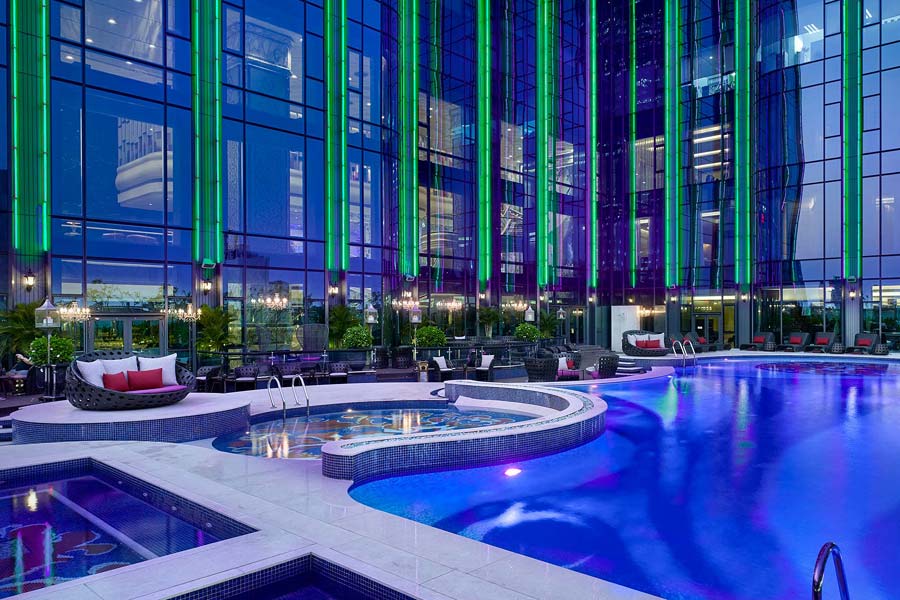
7 Luxury Hotels With Amazing Pools in Saigon

The Ultimate Guide to an Amazing Family Holiday in Vietnam from Australia
Our newsletter.
Get free consultation on designing your travel itinerary in Vietnam
4.1/5 - (17 votes)

Vietnam Travel Guide
Looking for an in-depth Vietnam travel guide ?
Then you’re in the right place!
Thanks to its stunning natural beauty in places Ha Long Bay and the Mekong Delta, bustling cities with incredible street food, and fascinating culture and history, Vietnam is an unmissable destination in Southeast Asia .
It’s also extremely affordable, and visitors will find that their money stretches far in Vietnam when it comes to food, hotels, and transportation.
Keep reading to dive into resources from Jessie on a Journey as well as its sister site Epicure & Culture that will help you with planning a trip to Vietnam.
Note: This guide to Vietnam travel contains affiliate links to trusted partners!

Vietnam Map
Use this Vietnam travel map to begin planning your trip!
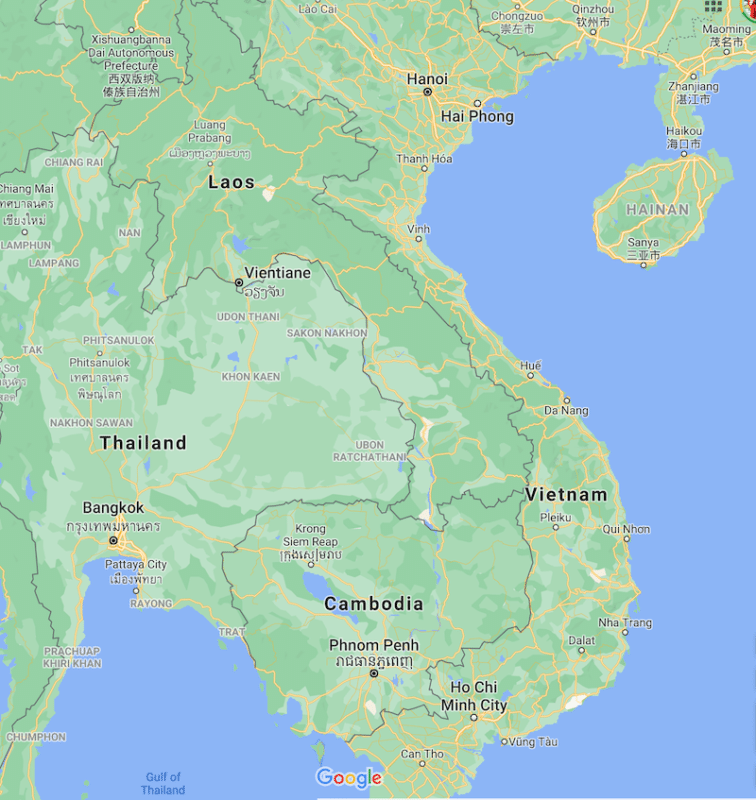
Click here for an interactive version of the above map.
Best Places To Visit In Vietnam
Learn about the top places to visit in Vietnam .
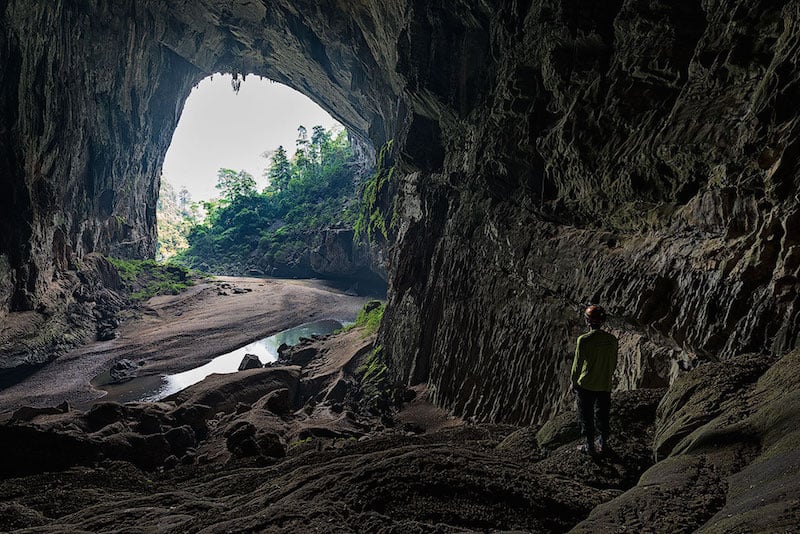
Stunning Images From The World’s Largest Cave In Vietnam
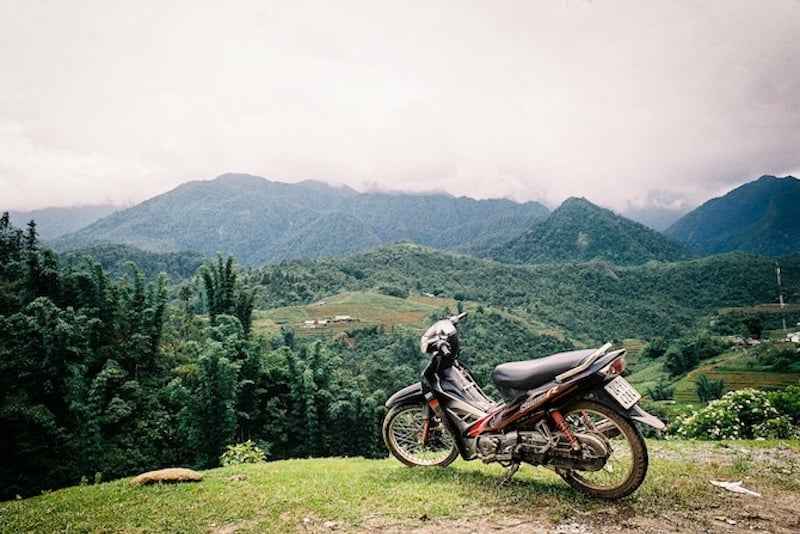
Solo Travel, Local Culture & Going Beyond The Guidebook In Vietnam
Vietnam Travel Advice
Use these Vietnam travel tips to plan the perfect trip.
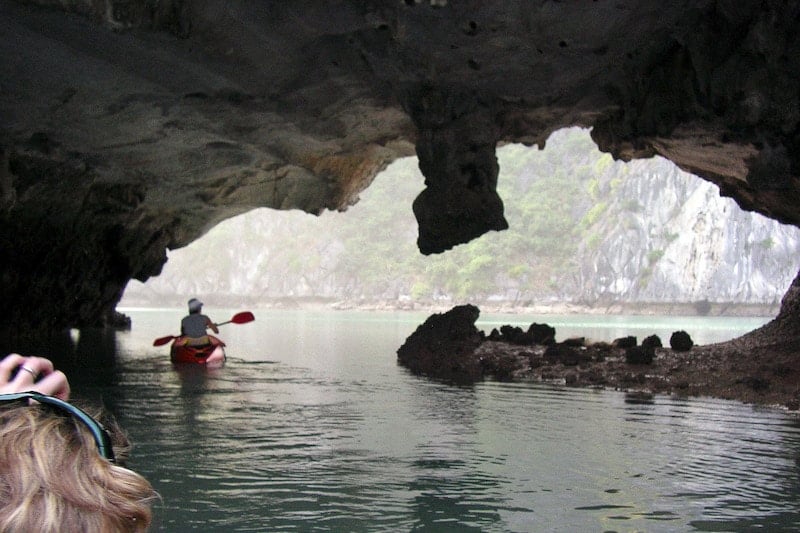
My Unwanted Paparazzi Moment On Cat Ba Island In Vietnam (Important Lesson Included!)
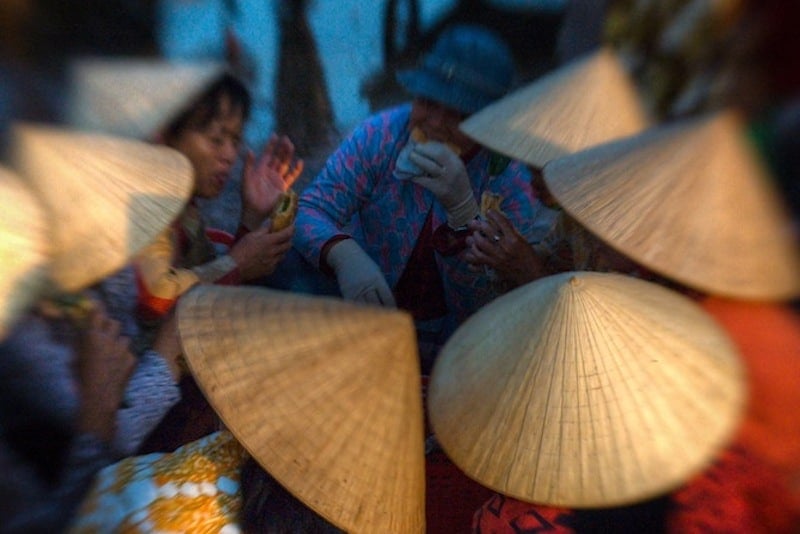
Top 10 Vacation Destinations In Asia
Vietnam Food Trip
Explore the country on a virtual Vietnam food tour with these travel resources.
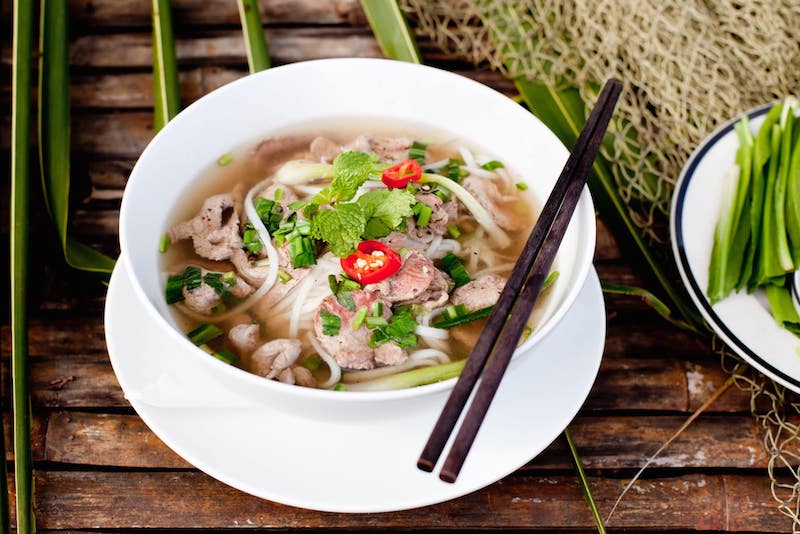
A Guide To Southeast Asian Culture Through Spices

The French Influence On Vietnamese Cuisine
Asia Travel Tips
This Asia travel advice can help you plan the perfect trip.

24 Best Places For Solo Travel In Asia
Top Vietnam Tours
Check out these fun tours in Vietnam from my affiliate partner, Viator:
- Cooking Class in Local Villa with Market Tour (Seasonal Local Wine Tasting) in Hoàn Kiếm
- Saigon Evening Food Tour By Scooter in Ho Chi Minh City
- Overnight Sapa Tour from Hanoi
These excursions will help you learn about Vietnam from a local!
Vietnam Travel Insurance
It doesn’t matter if you’re traveling solo or with a group on a Vietnam tour. When visiting Vietnam — or any other country in the world — make sure to get travel insurance to protect your health and safety.
In my opinion, the best travel medical insurance for travelers is SafetyWing as they’ve got a large network and offer both short-term and long-term coverage — including coverage if you’re traveling for months as well as limited coverage in your home country).
Additionally, SafetyWing is budget-friendly and offers $250,000 worth of coverage with just one low overall deductible of $250.
With coverage, you’ll have peace of mind as you embark on your Vietnam itinerary.
Click my referral link here to price out travel insurance for your trip in just a few clicks .
Vietnam Hotels
Click here to browse hotels in Vietnam!
Prefer self-contained stays?
Click here to check out unique local rentals!
You can also use this map to search for local stays:
Renting A Car In Vietnam
Need a rental car for your Vietnam trip?
Use Discover Cars to quickly compare your car rental options.
Vietnam Travel Guide FAQ
Below, find answers to frequently asked questions about traveling Vietnam .
Q: Is Vietnam safe for tourists?
Vietnam is a safe country for tourists to visit. In fact, it’s one of the best destinations for a solo trip to Asia .
There is very little violent crime; however, tourists should be vigilant when it comes to petty theft and scams, especially in popular tourist destinations.
Q: Is Vietnam cheap to travel?
Vietnam is a very budget-friendly destination! Like many places in Southeast Asia, your money will go far in Vietnam.
A typical backpacker budget is around $30 a day, while a mid-range traveler may want to budget $60-$75 a day.
If you’re on a budget while traveling Asia , definitely add Vietnam to your itinerary.
Q: Can you travel Vietnam by train?
Yes, train travel is one of the best ways to get around Vietnam!
Trains in Vietnam are comfortable, affordable, and scenic. Although they can be slow, they offer great views and a good value for money.
Q: What are some Vietnam travel do’s and don’ts?
Things you should do in Vietnam:
- Do dress conservatively, especially when visiting temples or pagodas
- Do keep an eye on your belongings at all times, especially in tourist areas
- Do learn a few basic phrases in Vietnamese, such as hello, please, and thank you
Things you should not do in Vietnam:
- Don’t take photos without asking for permission first, especially in rural areas or villages
- Don’t expect public restrooms to have toilet paper – always bring your own with you!
- Don’t miss out on trying Vietnamese street food
Q: Do I need a visa to enter Vietnam?
Citizens of most North American and European countries will need a visa in order to visit Vietnam. Visas must be applied for in advance.
It’s recommended to view your country’s Vietnam International Travel Information page for the most up-to-date information on entry and exit requirements. You can also contact the Embassy of the Socialist Republic of Vietnam.
Q: What are some must-try street foods in Vietnam?
Vietnam has some of the best street food in the world!
Experience Vietnam through delicious dishes like pho (a hearty noodle soup), xoi (sticky rice laced with various options like pork or fried egg), and banh mi (a tasty baguette sandwich).
Q: What are some great Vietnam tourist places?
When visiting Vietnam, some tourist spots not to miss include Ho Chi Minh City (aka Saigon), Phú Quốc Island, Mekong Delta (aka the Western Region), Vũng Tàu, Halong Bay, and Ninh Binh, which is a town just an hour-and-a-half from Hanoi, which another great destination.
It’s also easy to get to other countries in Southeast Asia and the rest of Asia from Vietnam, like Hong Kong, Thailand, and Laos.
Q: What is the local currency in Vietnam?
The local currency in Vietnam is the Vietnamese đồng.
What would you add to this Vietnam travel guide?

Enjoyed this guide to Vietnam travel? Pin it for later!
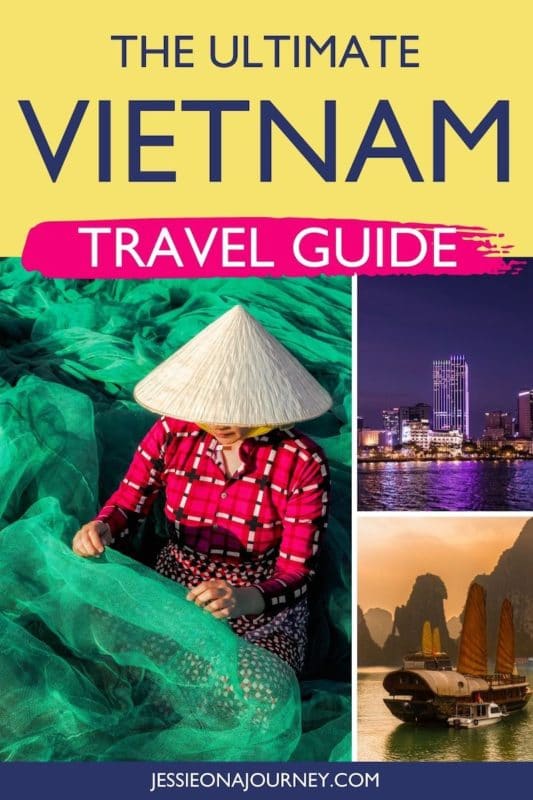
Wander-Lush
Visit Vietnam: The Ultimate Vietnam Travel Guide
Going to Vietnam the first time was life-changing for sure… The food, culture, landscape, and smell; they’re all inseparable. It just seemed like another planet; a delicious one that sort of sucked me in and never let go. Anthony Bourdain
Land of the Blue Dragon
Vietnam: Where motorbikes outnumber the people. For most travellers, this country is synonymous with three things: Frenetic cities, incredible outdoor adventures, and some of the best food on earth.
After my first visit to Vietnam when I travelled the entire length of the country on the Reunification Express , I told myself that unlike the 97% of people who only visit once, I’d be back. Years later, I moved to Hanoi to work with an NGO – an experience I’ll never forget. I have more dear friends in Hanoi than almost any other city. Vietnam feels like a second home to me.
From the jagged peaks of Ha Giang to the backwaters of the Mekong Delta , the one thing Vietnam isn’t lacking is variety. Join the crush inside the canary yellow walls of Hoi An’s UNESCO Ancient Town , chase dragons in Hue , then find room to breathe in one of rural Northern Vietnam’s hidden oases .
Between the velvety rice terraces of Sapa and Mu Cang Chai and the prickly limestone karsts of Halong Bay and Ninh Binh , you’ll find sand dunes in Mui Ne , waterwheels in Pu Luong , tea fields in Thai Nguyen , and hundreds of sweet hamlets and fascinating small cities in between.
From rustic homestays to boutique apartments, sipping cocktails in a Saigon skybar to knocking back a glass at a bia hoi in Hanoi. Vietnam might come off as a little aloof, but at the end of the day, she certainly knows how to treat her guests.
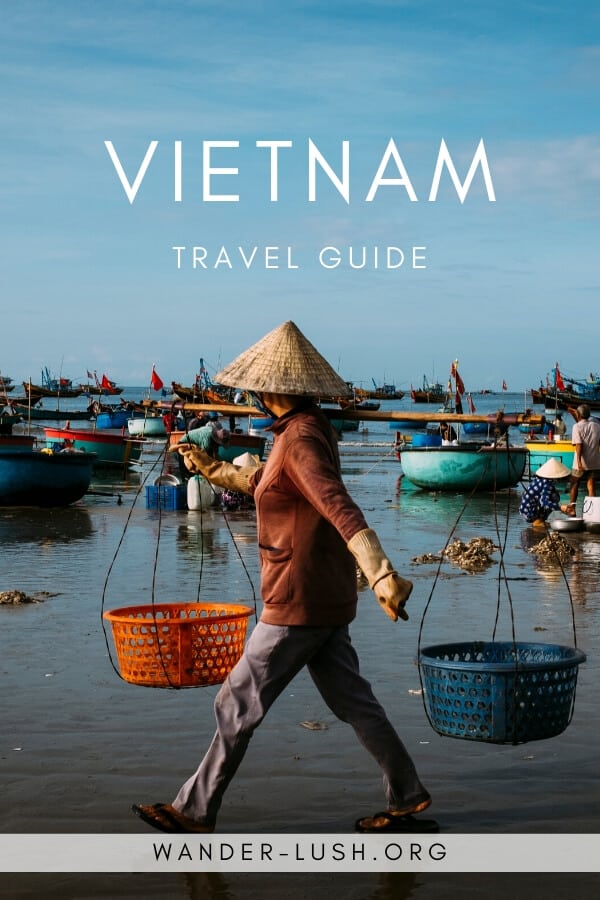
Vietnam travel essentials
Please note: Some of these links are affiliate links, meaning I may earn a commission if you make a purchase by clicking a link (at no extra cost to you). Learn more .
Late February to April (spring shoulder season) for cooler weather.
How long in Vietnam?
3-4 full days for Hanoi; 2 weeks for the highlights; 3-4 weeks for a good overview.
Daily budget
45-60 USD per person per day (mid-range hotel; restaurant meals; taxis; museum tickets).
Getting there
Fly into Hanoi or Saigon; bus from any neighbouring country.
Vietnam visa
eVisa/VOA (single entry; 30 days) or visa-free for some.
Getting around
Domestic flights (Viet Jet, Jetstar); train; bus/minivan.
Where to stay
Family-run guesthouses, homestays or hotels.
Tours & experiences
Food tours, history walks and trekking.
Explore Vietnam
Discover Hanoi’s local side plus all the best things to do in Vietnam with my latest travel guides.
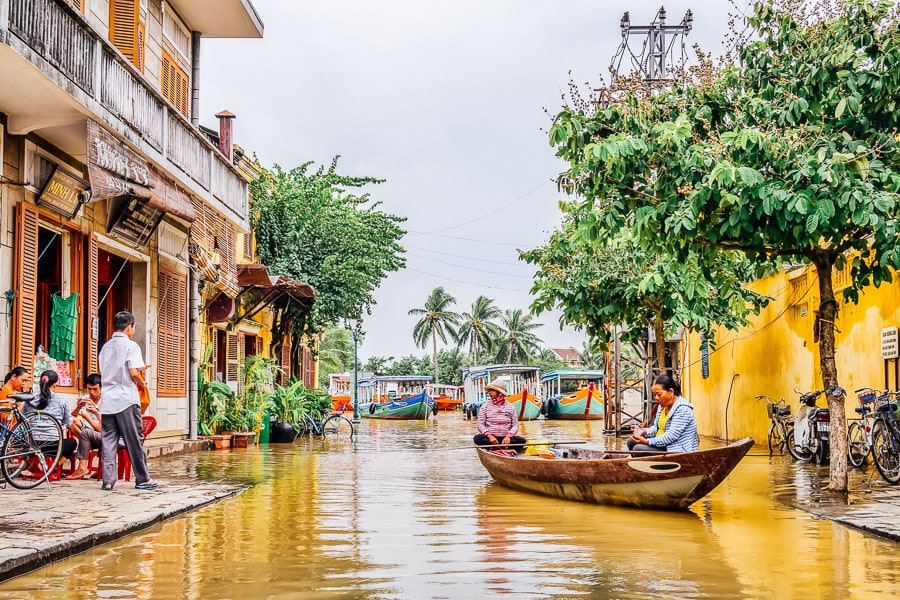

Vietnam With Kids: 6 Best Vietnam Family Holiday Destinations + Travel Tips
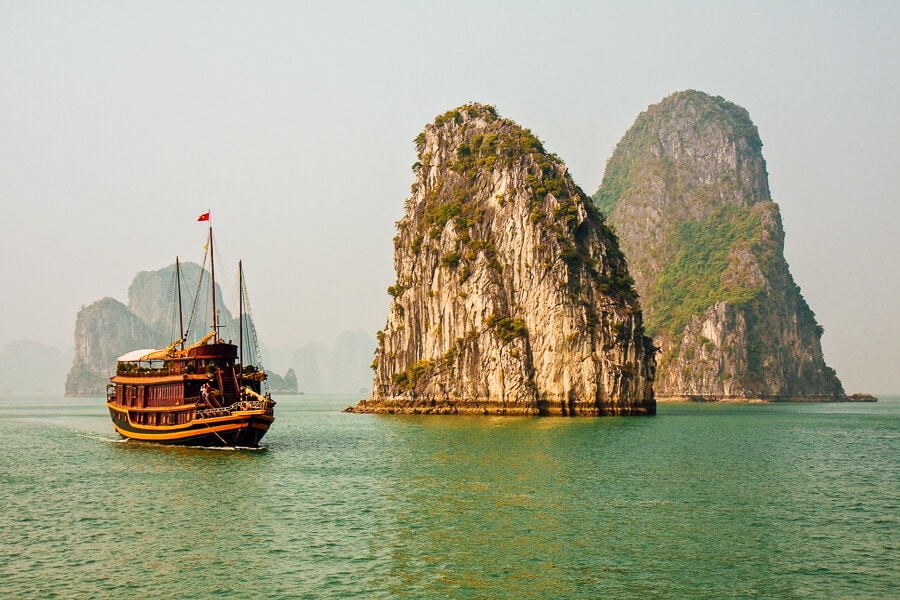
Hanoi to Halong Bay: The Definitive Travel Guide for 2024
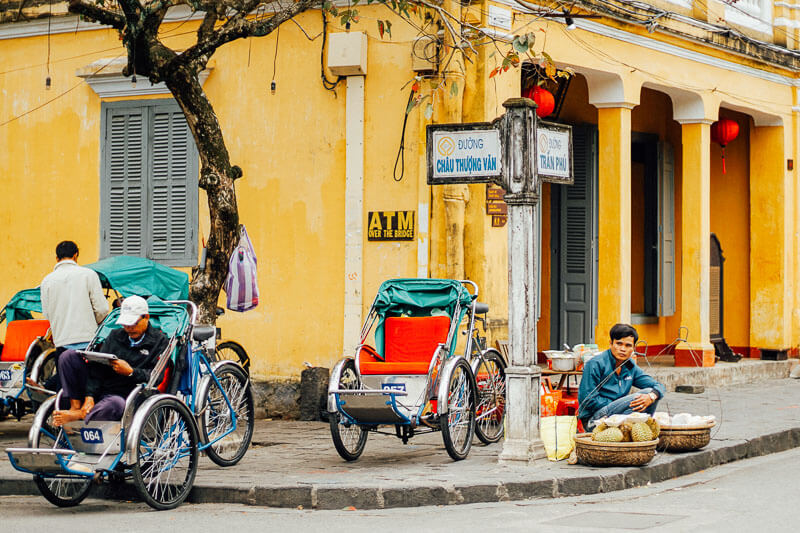
How to Travel from Da Nang to Hoi An in 2024: Detailed Transport Guide

Where to Stay in Ninh Binh: 12 Fantastic Hotels & Bungalows for Every Budget
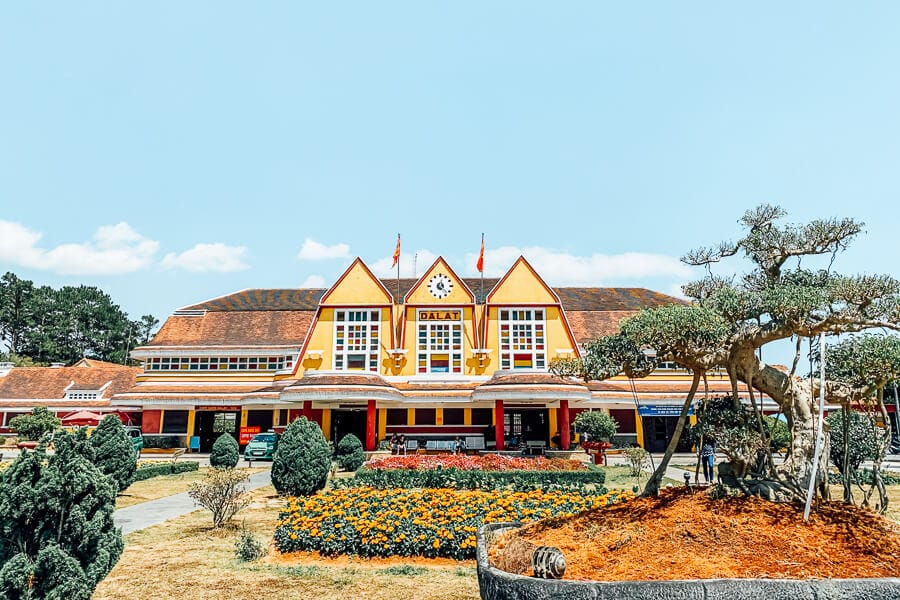
Perfect 3-Day Dalat Itinerary: The Best Things to Do in Vietnam’s City of Eternal Spring
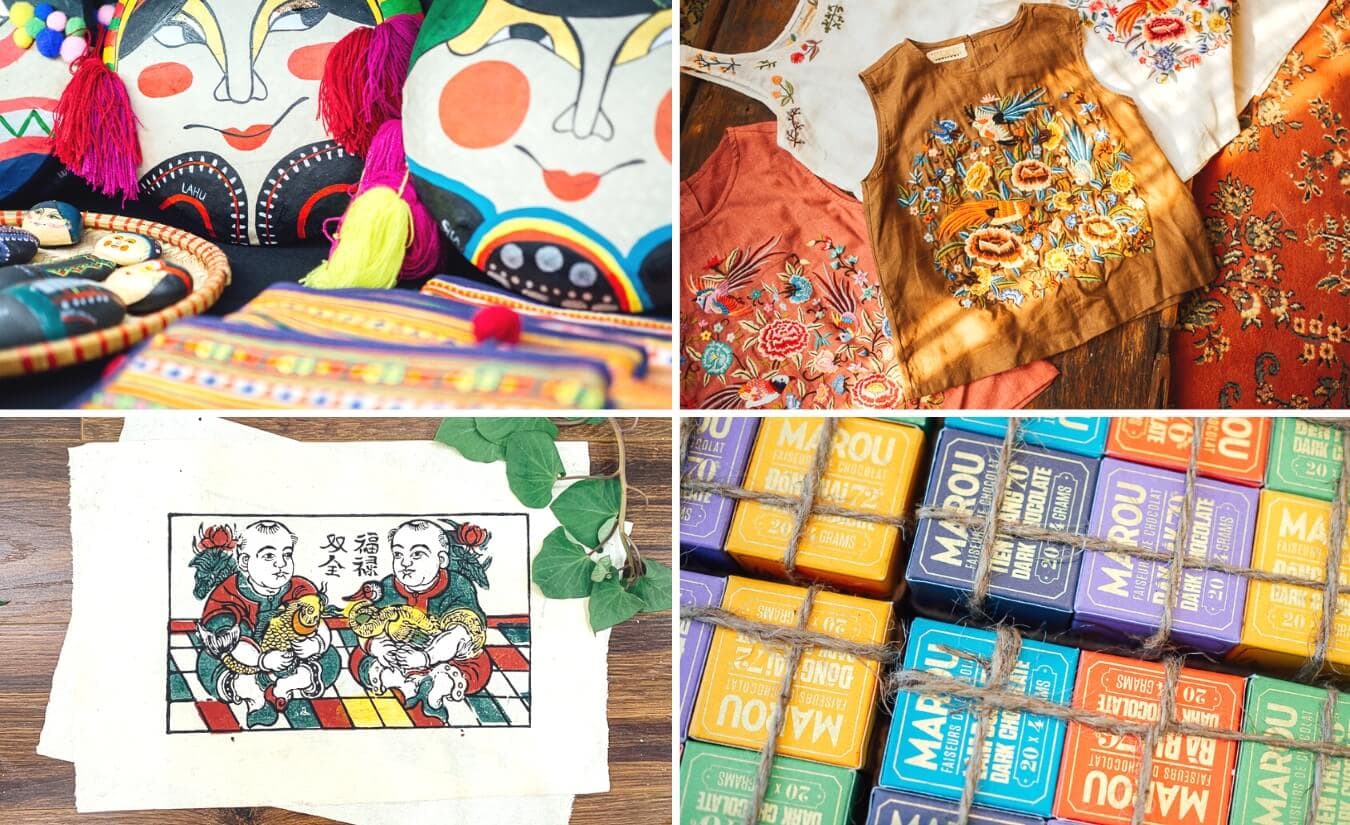
Shopping in Hanoi: 18 Local, Handmade & Authentic Hanoi Souvenirs (With Map)
My vietnam favourites.
Trekking in the rice fields around Ta Phin, Sapa.
Must-eat meal
A plate of Pho Cuon in Hanoi’s Truc Bach neighbourhood.
local experience
Rolling up to Hanoi’s Long Bien produce market at 2am.
best souvenirs
Propaganda posters from Hanoi & Hmong textiles.
The Rough Guide to Vietnam
This practical travel guide to Vietnam features detailed factual travel tips and points-of-interest structured lists of all iconic must-see sights as well as some off-the-beaten-track treasures. Our itinerary suggestions and expert author picks of things to see and do will make it a perfect companion both, ahead of your trip and on the ground. This Vietnam guide book is packed full of details on how to get there and around, pre-departure information and top time-saving tips, including a visual list of things not to miss. Our colour-coded maps make Vietnam easier to navigate while you're there. This guide book to Vietnam has been fully updated post-COVID-19 and it comes with a free eBook. The Rough Guide to VIETNAM covers: Ho Chi Minh City and around, the Mekong Delta, the central highlands, the southern coast, central Vietnam, the northern coast, Hanoi and around and the far north. Inside this Vietnam travel guide you'll find: RECOMMENDATIONS FOR EVERY TYPE OF TRAVELLER
Experiences selected for every kind of trip to Vietnam, from off-the-beaten-track adventures in Ca Mau Peninsula to family activities in child-friendly places, like Tra Su Bird Sanctuary or chilled-out breaks in popular tourist areas, like Ha Long Bay. PRACTICAL TRAVEL TIPS
Essential pre-departure information including Vietnam entry requirements, getting around, health information, travelling with children, sports and outdoor activities, food and drink, festivals, culture and etiquette, shopping, tips for travellers with disabilities and more. TIME-SAVING ITINERARIES
Includes carefully planned routes covering the best of Vietnam, which give a taste of the richness and diversity of the destination, and have been created for different time frames or types of trip. DETAILED REGIONAL COVERAGE
Clear structure within each sightseeing chapter of this Vietnam travel guide includes regional highlights, brief history, detailed sights and places ordered geographically, recommended restaurants, hotels, bars, clubs and major shops or entertainment options. INSIGHTS INTO GETTING AROUND LIKE A LOCAL
Tips on how to beat the crowds, save time and money and find the best local spots for water puppetry, boat trips, cycling, kayaking or exploring markets. HIGHLIGHTS OF THINGS NOT TO MISS
Rough Guides' rundown of Ho Chi Minh City, Da Lat, Kon Tum and Son My's best sights and top experiences helps to make the most of each trip to Vietnam, even in a short time. HONEST AND INDEPENDENT REVIEWS
Written by Rough Guides' expert authors with a trademark blend of humour, honesty and expertise, this Vietnam guide book will help you find the best places, matching different needs. BACKGROUND INFORMATION
Comprehensive 'Contexts' chapter of this travel guide to Vietnam features fascinating insights into Vietnam, with coverage of history, religion, ethnic groups, environment, wildlife and books, plus a handy language section and glossary. FABULOUS FULL COLOUR PHOTOGRAPHY
Features inspirational colour photography, including the stunning Ma Pi Leng Pass and the spectacular Khai Dinh Mausoleum. COLOUR-CODED MAPPING
Practical full-colour maps, with clearly numbered, colour-coded keys for quick orientation in Hoi An, Hue and many more locations in Vietnam, reduce the need to go online. USER-FRIENDLY LAYOUT
With helpful icons, and organised by neighbourhood to help you pick the best spots to spend your time. FREE EBOOK
Free eBook download with every purchase of this guide book to Vietnam allows you to access all of the content from your phone or tablet, for on-the-road exploration.
Description
Book details.
This title is a part of Rough Guides Main Series
Practical travel guides series covering countries, cities and regions, with detailed factual travel tips, perfect for independent, long-stay, backpacking and budget-conscious travellers seeking comprehensive travel information and off-the-beaten track experiences
Extensive practical travel information including getting there, getting around, climate information, safety tips, accommodation explanations, food & drink advice and shopping essentials
Curated author picks with destination highlights at the beginning of each guide
Ready-made itineraries covering every corner of the destination
Colour-coded places chapters with detailed coverage of places and sights, presented in a points-of-interest structure
Extensive recommendations for accommodation, restaurants, shops and leisure activities for all budgets
Colour-coded detailed maps with marked-up key sights
Insights on history and nature highlights
Easy to use, newspaper-style layout
All guides published from January 2021 are printed on paper from responsible sources verified to meet FSC’s strict environmental and social standards
Free eBook with each printed guide published from May 2019
Format: 129 x 198mm
Price: £14.99-£26.99 | $13.99-$34.99
Extent: 616–1208 page
BOOK DETAILS
Which payment options can I use in the Rough Guides Shop?
You can pay with credit card : Visa, MasterCard, American Express, and via PayPal .
How long will it take to receive my order from the Rough Guides Shop?
If you’ve ordered an ebook, it will be delivered to you via email immediately after your purchase.
For printed book orders, we offer DPD next day delivery in the United Kingdom and Northern Ireland and standard (2-8 days), priority (1-3 days) delivery options in the USA.
Please be aware that the delivery times are based on when your item was dispatched and not when you ordered your item. Unless stated otherwise, we intend to send items on the next available business day.
Currently we do not provide a tracking number for your order.
How can I contact Rough Guides about a shop order?
You can contact our shop team at " [email protected] ".
To help our team reply faster, please copy and use one of the following email subject lines:
- "Book shop: orders, shipping, returns"
- "Website: general usage and technical problems"
- "Guide books: corrections and other questions"
- "Tailor-made travel"
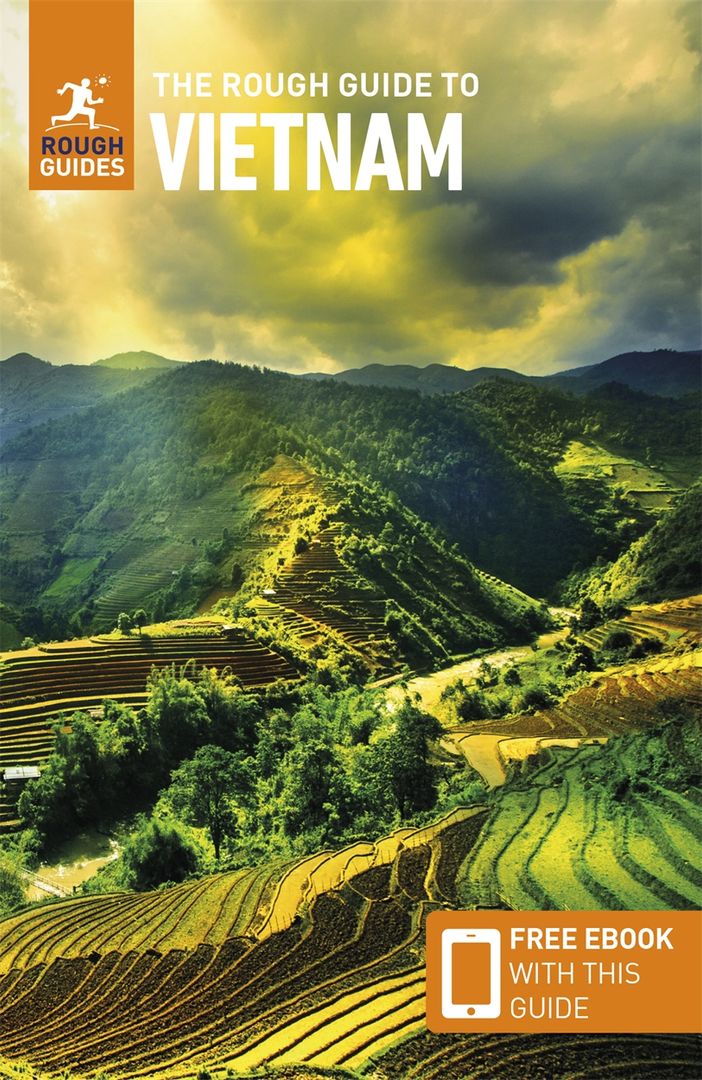
You might also love

The Rough Guide to Southeast Asia On A Budget

Insight Guides Southeast Asia
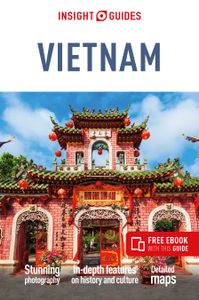
Insight Guides Vietnam

The Rough Guide to the A-Z of Travel
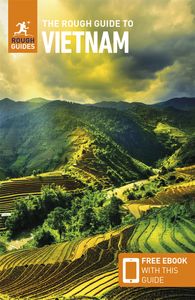
Make the Most of Your Time on Earth
.jpeg)
Insight Guides Explore Vietnam

Pocket Rough Guide Hong Kong & Macau

The Rough Guide to Taiwan

Insight Guides The Silk Road

The Mini Rough Guide to Singapore

The Rough Guide to Sri Lanka

The Rough Guide to Tokyo
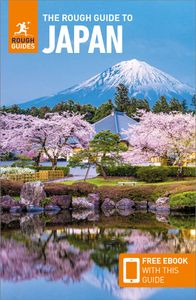
The Rough Guide to Japan

The Rough Guide to India
You are using an outdated browser. Please upgrade your browser to improve your experience.
Live fully in Vietnam
Vietnam opens its door widely to welcome visitors all around the world! Starting from 15th August 2023, Vietnam extends e-visa validity to 90 days and unilateral visa exemption will be valid in 45 days! We are more than happy to welcome you all here and admire our stunning landscapes, free your soul on white sandy beaches, experience our unique and beautiful culture and meet the people in the most friendly country. Particularly, to indulge in our scrumptious cuisine at Michelin rated restaurants or to join us in outstanding mega culture, music, sports and tourism events! Let’s live to the fullest in Vietnam!
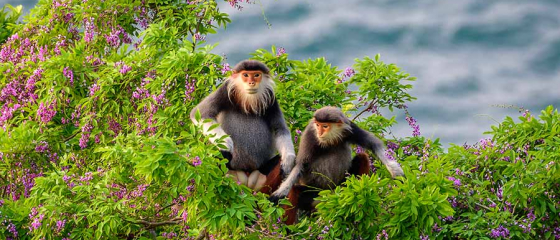
Vietnam - The nature wonder of Asia

Vietnam crowned as “Asia’s Leading Destination” for the 6th time
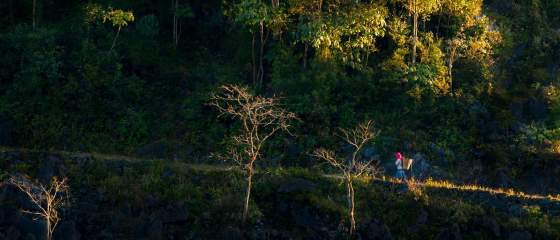
The Ha Giang Loop
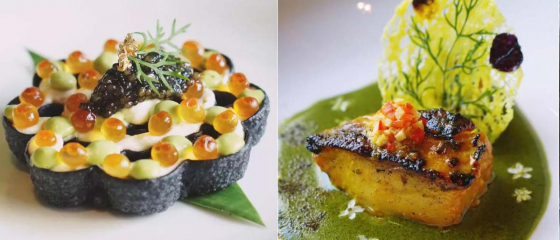
Food & Drinks
Discover one MICHELIN Star restaurants in Vietnam
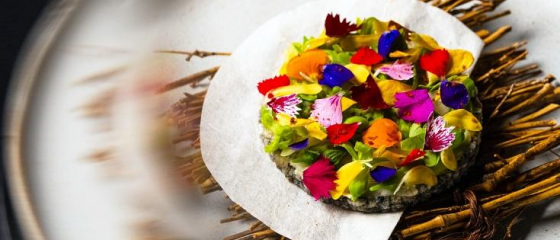
Nén Danang: Vietnam’s First Restaurant to Earn the MICHELIN Green Star

Virtual travel to Trang An Landscape Complex
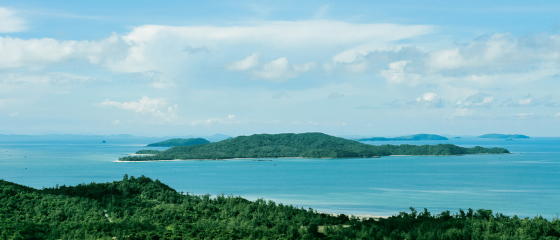
Go green in Co To
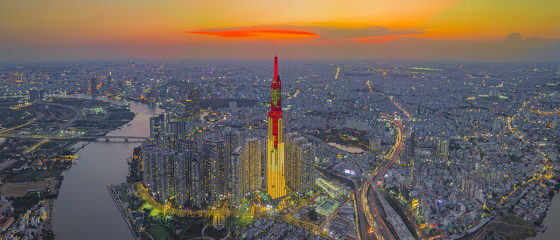
10 Tourist spots not to be missed in Ho Chi Minh City
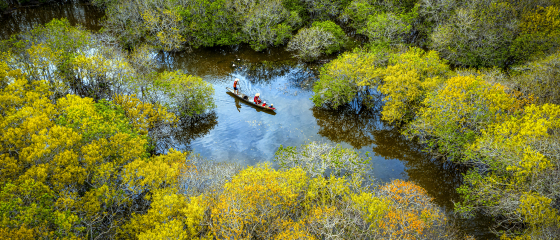
Ru Cha Mangrove Forest: A sleeping beauty of Hue
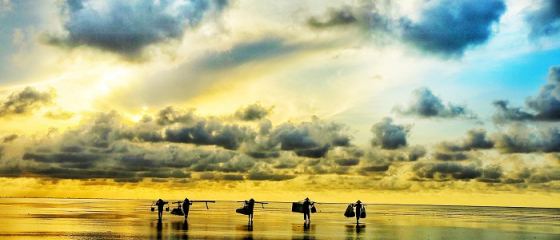
The infinity waters of Quang Lang Beach
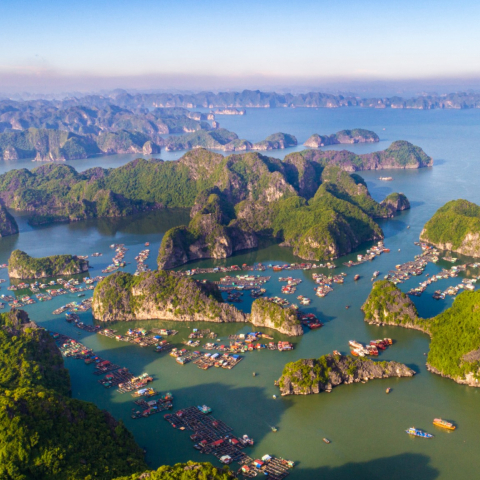
Halong Bay - Cat Ba inter-provincial World Heritage Site: Trending destination in Vietnam
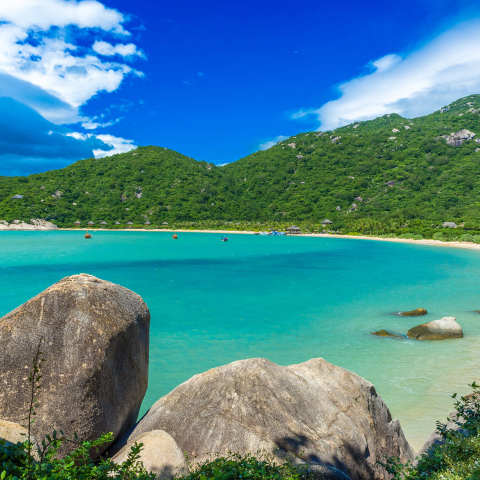
Nha Trang Best Beaches for a Sustainable Vacation
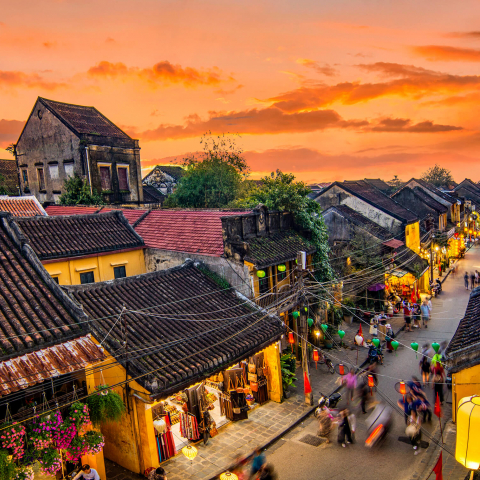
Explore the food of Hoi An
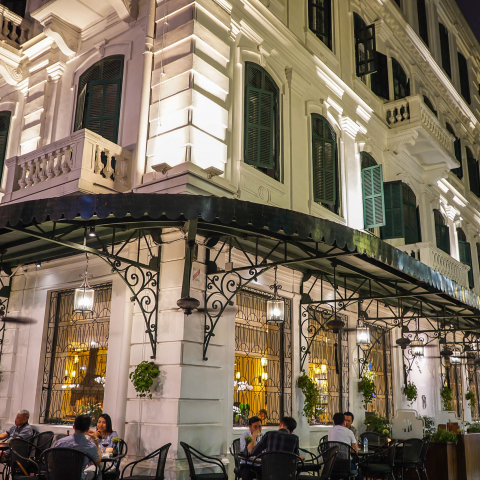
Comfort Meets Culture at Hanoi's Luxury Hotels
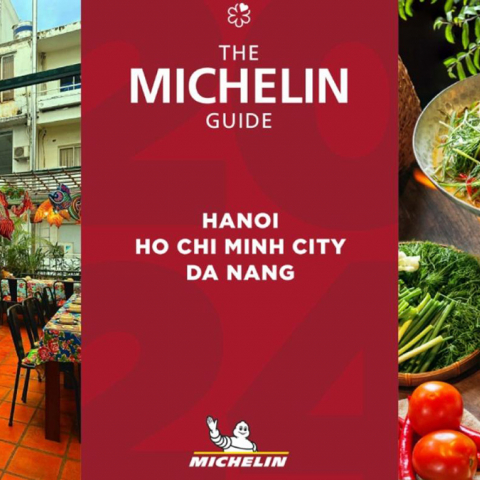
MICHELIN Guide Hanoi - Ho Chi Minh City - Da Nang: An official unveil
Check out upcoming events in Vietnam
must-see sites
Take a 360-degree tour of some of the country's most compelling natural wonders and cultural attractions right here.
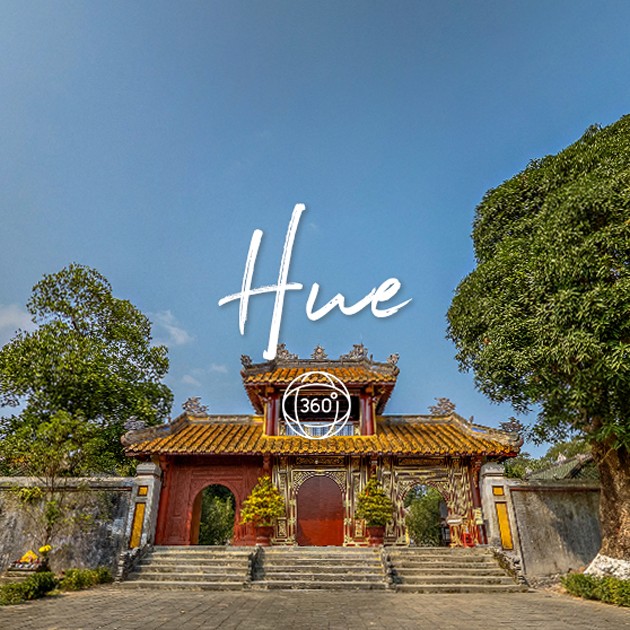
travel tips
Prepare for your trip with these practical articles
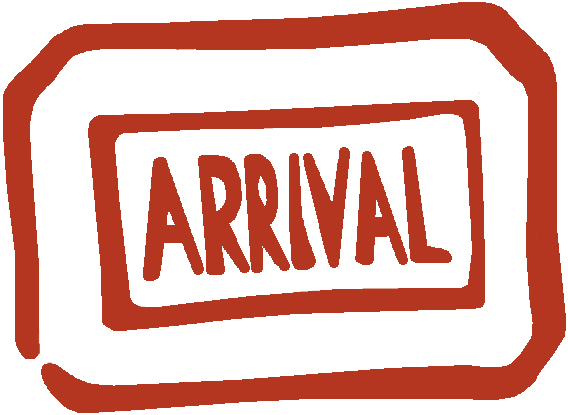
Vietnam through the lens of international news
Find out the reasons why Vietnam is worth to visit

TasteAtlas food rankings are based on the ratings of the TasteAtlas audience, with a series of mechanisms that recognize real users and that ignore bot, nationalist or local patriotic ratings, and give additional value to the ratings of users that the system recognizes as knowledgeable….
- TasteAtlas
Full article

Booking.com
Spring has finally arrived, bringing with it the perfect opportunity to venture out and explore the world.
- Booking.com

Travel Weekly
Visiting the South-East Asian country reminds Thompson Travel’s Sharon Thompson of the wonders of travel…
- Travel Weekly
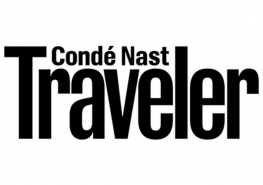
Conde Nast Traveler
To get you started on your next fairy tale adventure, we’ve rounded up 50 of the most beautiful small towns in the world.
- Conde Nast Traveler
share your story
Tag your best #LiveFullyinVietnam moments on Instagram
SHARE YOUR STORY
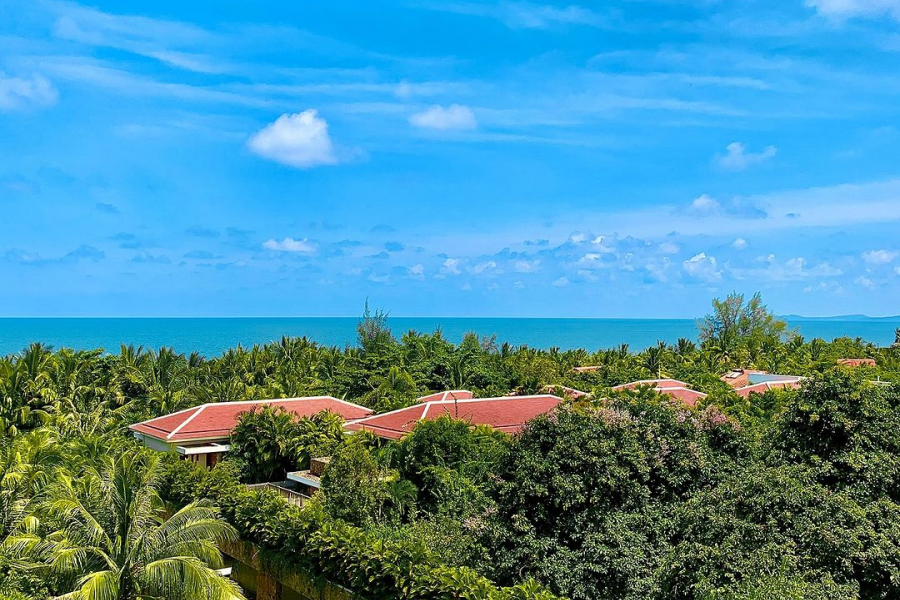
Create an account
Already have an account? Click here to sign in
By clicking submit, you agree to our Privacy Policy and Terms of Use
Sign in with your social accounts
Sign in with your email
Forgot password? Click here to get it back
Don't have an account? Sign up here
Forgot Password
The entered email has subscribed for Vietnam Tourism monthly newsletter
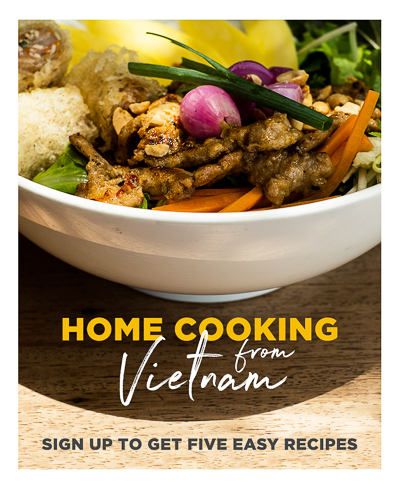

Vietnam Travel Guide
Your ultimate vietnam travel guide, with tips, and things to see and things to do in vietnam. great for first-time and returning travelers..
Vietnam has some amazing sites to see. It is one of our favourite countries that we have ever visited. From great natural wonders to fantastic shopping, mountain adventures and chilling beach life, Vietnam has something to offer for everyone.
Once you get passed the aggressive nature of the touts on the street, it can be a wonderful and fulfilling travel. The people will soon win over your hearts and it will become one of your top travel destinations like it is ours.
These Vietnam travel tips will help you plan your next vacation.
Popular Guides
- Ho Chi Minh
- Cu Chi Tunnels
Our Highlight
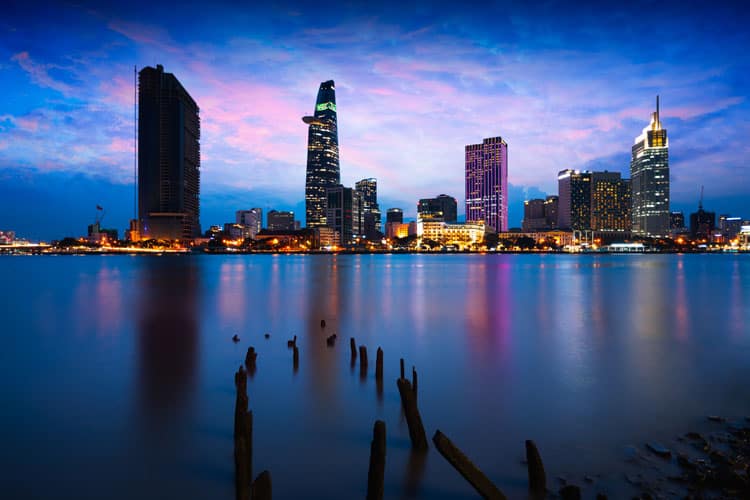
Table of contents
Table of Contents
Fast Facts about Vietnam
- Vietnamese power voltage is 220 V 50 Hz; Power sockets A, C & G
- The Vietnamese currency is the Vietnamese Dong (VND) and is around 2,000 VND for 1 USD
- Vietnam has some of the cheapest beer in the world – a glass of bia hoi can be as low as 0.16 USD.
- Get ready to haggle : tourists tend to get charged more than locals so make sure to drive a hard bargain and don’t underestimate the power of walking away.
- Watch out for gambling scams in Hanoi and Ho Chi Minh City (particularly in the Pham Ngu Lao neighbourhood). The scam starts with a friendly invitation to someone’s home. While waiting, visitors are invited to play a game of cards. Even though the game starts with small wagers, victims have reported losing thousands of dollars over the course of an evening.
- Etiquette plays an important role in Vietnamese society: public displays of affection should be avoided, when you give something to another person, always use both hands and you should avoid pointing with your finger, putting your hands on your hips or crossing your chest with your arms.
- Travel is not recommended during Vietnamese New Year (Tet), which falls in late January or early February as prices are sky high and it can be a little hectic.
- Shop until you drop! Hoi An is a town in Central Vietnam that attracts tourists for its tailor made clothing. The talented seamstresses will have you measured and sized up in an instant. Just be sure to ask for double stitching, otherwise your clothes won’t last to the next city.
Things to See and Do in Vietnam
- Explore the Cu Chi Tunnels – fascinating 200 km system of underground tunnels. You can visit Cu Chi from Ho Chi Minh City on a day tour.
- Go on a Mekong Delta Tour – You will explore the Mekong area by tour boat, traditional rowboat and minibus. The highlight of the trip is a visit to the famous Cai Ba floating market
- Lantern Festival at Hoi An – The lantern festival at Hoi an is something which you cannot miss during your visit to Vietnam. The festival is held on every ‘full moon’ night when people lit a candle at the bottom of a colorful paper lantern.
- Floating markets at Mekong Delta – You can binge upon the floating markets and the countryside life at Mekong delta, which is quite an attraction for the tourists coming here from every part of the globe.
- Visit the church at Tay Ninh – Tây Ninh, a busy town at the Mekong Delta, accommodates some of the most beautiful churches and cathedrals in the country. Visit them to treat yourself with the rich legacy and history of Vietnamese culture.
- Visit Ha Long Bay – Located about 165 km East of Hanoi on the Gulf of Tonkin. It is a spectacular destination.
- See Sapa – Sapa has become a little overcrowded with tourists, but if you book a multi-day trek to stay in a home stay with one of the ethnic minority peoples, you will get a feel for traditional life and will be far enough away from the hustle and bustle of Sapa for an authentic experience.
- Explore Cat Tien National Park – Measuring around 720km² Cat Tien National Park is a treasure trove of wildlife and it is home to many endangered species.
Vietnam Travel Guides
- Places You Have to Visit in Southern Vietnam
- Things to do in Hanoi
- Things to Do in Ho Chi Minh City
- The Very Best Things to do in Vietnam from North to South
Accommodation
Budget – You may need to spend around ($20) on average to stay in Vietnam on a budget. The cheapest form of lodging in Vietnam is a mattress in a dormitory, where you pay for the mattress and share commonplace facilities.
Mid Range – You will spend around $40 to find a room within this range. It will come with all the basic facilities like an air conditioner, hot water and more.
High End – If you are looking for some classy accommodations, you may need to spend around $75-$100 per night. This includes a restaurant, fitness center, and pool.
Check out our favorite booking platforms Booking.com , Tripadvisor and VRBO for the best deals on accommodation in Vietnam.
Pho – Pho comes as one of the most popular soup-based dishes in Vietnam. The dish is prepared with rice noodles & beef and can be enjoyed as a perfect snack at any time of the day.
Cha ca – Cha ca can undoubtedly be termed as the signature dish of Vietnam. Grilled white fish is cooked in the perfect blend of turmeric, ginger, garlic, and fish sauce.
Banh xeo – Bánh xèo is basically a ‘ Vietnamese styled pancake,’ which is prepared out of a perfect mix of rice flour, shrimp and pork belly.
Cao Lau – Cao Lau is another very famous Vietnamese dish that got its origin from the Hoi An town. It is prepared out of rice noodles, pork, and greens while using the age-old Chinese cooking method known as Char siu.
Rau Muong – Also known as stir-fried water spinach or Morning glory, this Vietnamese dish is high on both taste and nutrition.
The Best Ways to Get Around Vietnam
Getting to vietnam:.
Flights: There are 37 airports in total (34 domestic and 3 International) in Vietnam, and you can reach them from almost every major city across the globe.
You can check for the best flights to Vietnam on Skyscanner .
Transportation:
Buses : You can easily find an air-conditioned bus in Vietnam for around $35 to $75 and the same run majorly between Hanoi and HCMC (covering all the major cities during the journey). Still, the price may vary according to the bus operator and preferred route.
Taxis / Uber : Uber is not currently operational in Vietnam, and you will only find taxis from two major taxi companies (Vinasun and Mai Linh) for around $70 (price may vary according to the chosen route).
Car Rental: You may need to shell out around $198 per day to rent a car in Vietnam. The same cost may vary according to the given model or size of the car
You can also compare prices here .
When to go To Vietnam
- Spring season (February to April) and autumn season (August to October) is the best time to visit Vietnam.
- The temperatures are moderate, with frequent mild rainfalls. This is a great time to come if you want to explore the beautiful outdoors in Vietnam.
Where to Stay in Vietnam
Eden Boutique Hotel & Spa – Eden Boutique Hotel and Spa is situated on the recently developed Thac Bac street with just 6 minutes walking distance from the Notre Dame cathedral. You will have access to free WiFi, mini-bars, and a spa.
Hanoi Babylon Garden Hotel & Spa – Hanoi Babylon Garden Hotel & Spa offers lodging with free WiFi and breakfast. The hotel is situated nearby Hoan Kiem Lake.
Acacia Heritage Hotel – While staying at this luxurious hotel, you can get the most picturesque views of the famous ‘Thu Bon’ river. The hotel is nearby to Da Nang International Airport while offering an outdoor pool.
Check out our favorite booking platforms Booking.com , Tripadvisor and VRBO for the best deals on accommodation.
Vietnam Guides
- Top Things to Do in Ho Chi Minh City
- Things to do in Vietnam
What to Pack for Vietnam
Vietnam has a tropical monsoon climate, moderated by two monsoons. The weather varies greatly from North to South, depending on elevation and the type of landscape. Northern Vietnam has four seasons with a cold winter and hot summer.
Central Vietnam has high temperatures all year round, with possible flooding occurring from October to December. Southern Vietnam has a distinct dry season and wet season.
- Dress modestly. Shorts and beachwear, which includes bikinis and swimsuits, should be worn only at the beach, as this kind of dress is really frowned upon in the towns and cities. People visiting pagodas are recommended to cover their legs and shoulders.
- The protection basics – Travellers should stock up on the essentials: sun block, mosquito/insect repellant containing DEET or a pyrethroid insecticide, sunglasses and a hat.
- Pack for Humidity – for humid weather it is best to pack fabrics that breathe as much as possible and natural fabrics, like cotton, linen or rayon (avoiding silk, wool and polyester). Clothing should be loose and comfortable to encourage the flow of air and allow moisture to evaporate. Think: cool but conservative.
- Proper footwear – pack a pair of comfortable sandals that can be slipped on and off easily (as many places require footwear to be left at the door) and if you plan on trekking or hiking, a pair of supportive hiking boots. And don’t forget about those flip flops for the beach!
See our packing tips: packing tips
Vietnam Travel Guide: Best Booking Resources
Whenever we travel to we make sure to start with these companies. We have tried a lot of different ones over the years and all of these have consistently proven to be the best when it comes to offering great prices.
We have used every one of these personally and continue to do so.
- Booking.com : This is our go site to when comparing prices for accommodation. It usually has the cheapest prices, especially in Europe and we love their interface. Not to mention you get free cancellation and you are guaranteed the best price.
- Trip Advisor : What we like about Trip Advisor is that we can look at all the reviews and then book our accommodation. TripAdvisor is where we go when we want to compare prices with multiple accommodation providers.
- VRBO : is the main search engine we use when we are looking for a home or apartment rental. It can sometimes be cheaper than hotels and it is the best way to stay in areas that offer a more local feel.
- Hostelworld : With one of the largest databases of hostels in the world, Hostelworld is the go-to site when you are looking for budget accommodation.
- Skyscanner : This is the first place we check for flights. It consistently comes back with the cheapest and best options. It allows us to compare a lot of airlines to get the best price.
- Rome 2 Rio : If you want to see how to get somewhere by plane, train, bus, ferry or car Rome2Rio lays it all out for you as well as related costs.I love how they show it all to you on a Google Map and it works offline.
- Get Your Guide: For all your day trip and city guide needs, we use Get Your Guide. It has the world’s largest collection of things to do with more than 30,000 activities in 7500 destinations.
- World Nomads Insurance: When traveling to Italy you should always have travel insurance. We have found the best bang for your buck is by far World Nomads.
Vietnam Travel Guide: Related Articles
To browse all our articles and guides about Vietnam click here .
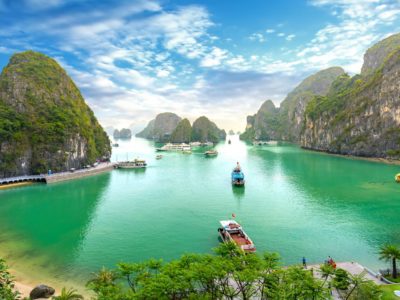
22 Best Things to Do in Vietnam In 2024
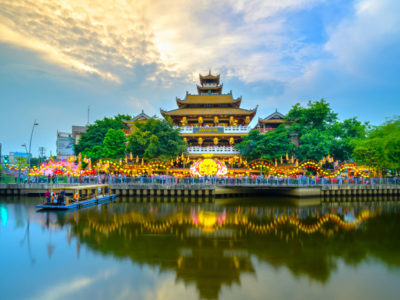
32 Best Things to Do in Ho Chi Minh City, Vietnam
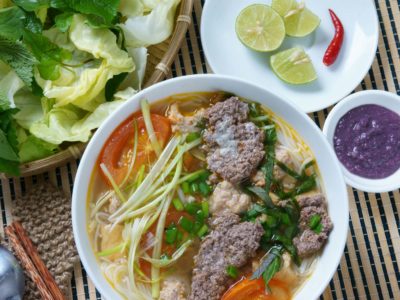
Vietnamese Food: 34 Traditional Dishes to Try in Vietnam

Ultimate VIETNAM Travel Guide
Vietnam is a country located in the Southeast Asia. Hanoi is the capital, a city that offers an abrupt introduction to a fascinating country. Our Vietnam travel guide is here to take the guesswork out of your planning.
After many years of war and closure to the outside world, Vietnam opened its doors completely to tourism in 1997 and since has worked hard to develop its tourism industry.
The country has recovered into a diverse, beautiful destination with great food, natural wonder and overwhelming culture.
After talking with friends who had visited, we weren’t sure we would like Vietnam. So we headed in with plans to only spend a week. Well, we stayed for 3 weeks and can’t wait to get back!
Vietnam turned out to be one of our favorite countries in Southeast Asia .
Destinations
Vietnam travel: quick tips, don’t visit vietnam without:.
UNIVERSAL TRAVEL ADAPTER

GET A GUIDEBOOK

REUSABLE WATER BOTTLE

START PLANNING YOUR TRIP TO VIETNAM!
Where to stay in vietnam.
Below you will find some of the places we have stayed during our travels in Vietnam. These are individual properties that we enjoyed and would recommend to other travelers.
HOW TO GET AROUND IN VIETNAM
Anyone looking to travel to Vietnam will likely fly into Hanoi or Ho Chi Minh City and connect to the other airports across the country. From these major cities, it is possible to use public transportation to see the city or take buses further afield.
Many people choose to engage in group tours or day tours to get around and see things in Vietnam. It is also possible to rent a motorbike and plan a road trip that takes you further afield and out of the city.
TOP VIETNAM TOURS
Classic vietnam.
10 Days Hanoi to Ho Chi Minh City Visits: Hanoi, Halong Bay, Hue, Hoi An & Ho Chi Minh City
BEST OF VIETNAM
15 Days Hanoi to Ho Chi Minh City Visits: Hanoi, Sapa, Halong Bay, Hue, Hoi An & Ho Chi Minh City

EXPLORE VIETNAM – NAT GEO
13 Days Hanoi to Ho Chi Minh City Visits: Hanoi, Mai Chau, Halong Bay, Hue, Hoi An, & Ho Chi Minh City
TRAVELING ON A BUDGET?
Vietnam travel: booking resources, vietnam travel guide: related articles.
Looking for more info? Check out all the articles we’ve written on travel to Vietnam and start planning your dream trip.
21 Unmissable Things to Do in Hanoi
30 epic things to do in vietnam, simple guide to vietnamese food, vietnamese traditional water puppet show in hanoi, how to choose a halong bay cruise, backpacking vietnam: 3 week recap & travel tips, hue to hoi an vietnam motorbike adventure, imperial city of hue vietnam: photo essay, colors of the mekong delta: photo essay, the vietnam snake man, immersion into the vietnam war, vietnam’s great adventure: the buffalo run, adventure on the high sea: 3d/2n halong bay cruise.

Be Inspired
- Destinations
- Things to do
- Eat & Drink
The Complete Guide to Vietnam
15 must-try vietnamese dishes, 10 best places to visit in vietnam in 2024, ao dai – vietnamese traditional dress, 10 best beaches in vietnam.
- Ho Chi Minh City
The 15 best attractions in Dalat
10 days in vietnam, 2 weeks in vietnam, 3 weeks in vietnam, 1 month in vietnam, bun dau mam tom.
20 Best Things to Do in Vietnam
Vietnam Travel Guide Video Series
8 must-try foods in Dalat
10 hidden gems in vietnam, the 10 best attractions in da nang, 7 must-try foods in da nang.
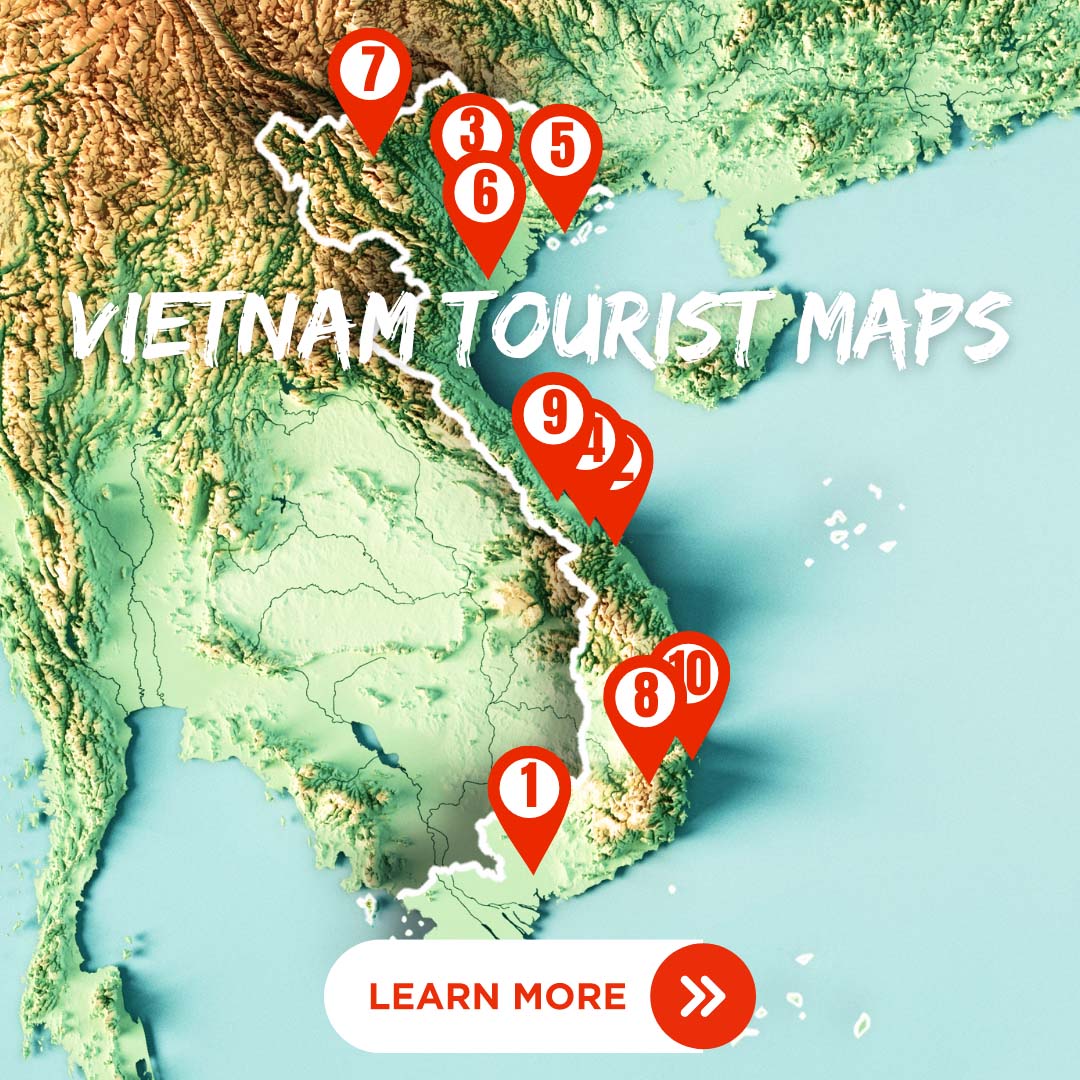
Top destinations
Northern vietnam, hanoi tourist map, central vietnam, southern vietnam, mekong delta attractions map, ho chi minh city tourist map.

[Video] Vietnam Travel Guide: Climate, Visas, Destinations, Cuisine & Tips
[video] hue: a guide to visiting the ancient capital of vietnam, [video] 10 best places to visit in vietnam voted by 7,050 travelers, [video] hoi an: a guide to visiting the most beautiful ancient town in vietnam, foods to try, things to do.
- Map of Vietnam
Climate of Vietnam
Vietnamese currency, vietnam visa, latest articles, sapa tourist map, popular posts.

Top Destinations
Travel guide.
- Best places
- Best dishes
- Vietnam visa
Helpful Resources
- Tourist maps
- Accommodation
- Privacy policy
- Our community
- Partner with us
© 2024 Welcome to Vietnam. All rights reserved.
This website utilizes cookies to improve user experience, analyze website performance and traffic, and deliver personalized content for marketing and advertising purposes. Privacy policy .
The Perfect Vietnam 2-week Itinerary + Insider Tips
May 3, 2023
Paula Martinelli
Looking for the perfect Vietnam 2-week itinerary? Look no further! With its diverse landscape, friendly people, rich culture, and delicious food, Vietnam is an amazing and budget-friendly destination that begs to be explored.
This guide is filled with insider tips , including the best transportation and accommodation options. Explore Ho Chi Minh City , the bustling capital, before heading to the UNESCO World Heritage site of Hoi An . Next up is the vibrant city of Hanoi, followed by a hike through the remote mountains of Sapa . Finally, end your adventure with a relaxing cruise on the stunning Halong Bay .
Vietnam offers an incredibly wide range of experiences for travelers. Get ready to discover the best of Vietnam in a 2-week itinerary and start planning your dream trip now!
If you are planning an itinerary in Vietnam, you will love these articles:
- Vietnam Travel Planning: All You Need to Plan Your Trip
- Vietnam 7-Day Itinerary
DAY 14 Vietnam Itinerary: Relax on Board a Junk Boat on Halong Bay
More tips for your vietnam itinerary.
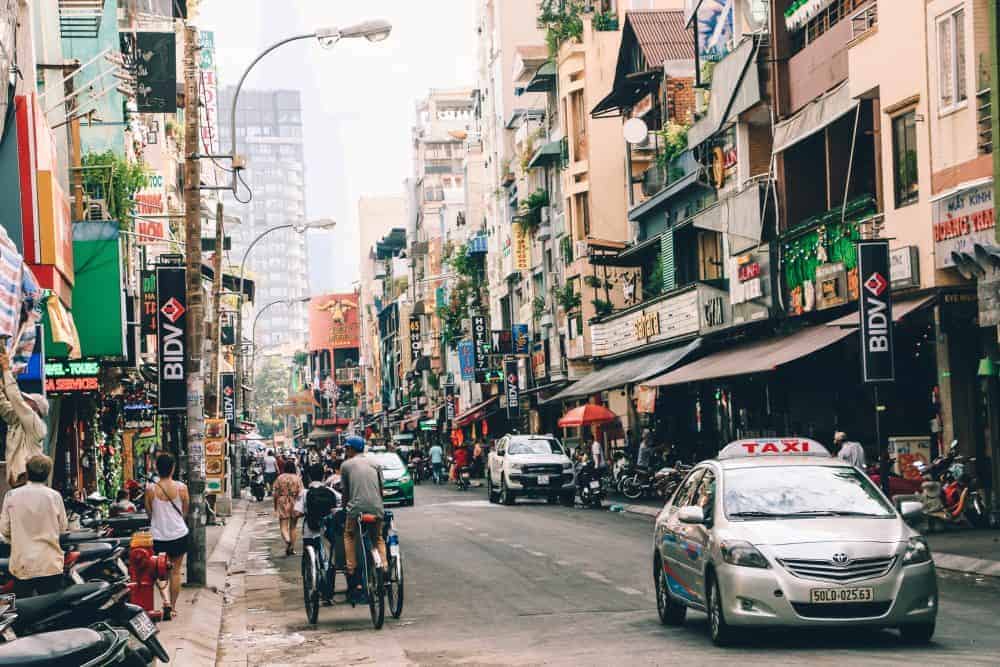
Vietnam 2-Week Itinerary Overview
Vietnam is a large country, and you will need to plan in advance in order to make the most of your itinerary in Vietnam. Here is a quick overview of the itinerary I put together, as I consider it the perfect route to see the best of Vietnam in 2-weeks. If you click on each destination, you will find a full itinerary of each location and all the information and logistics associated with each city.
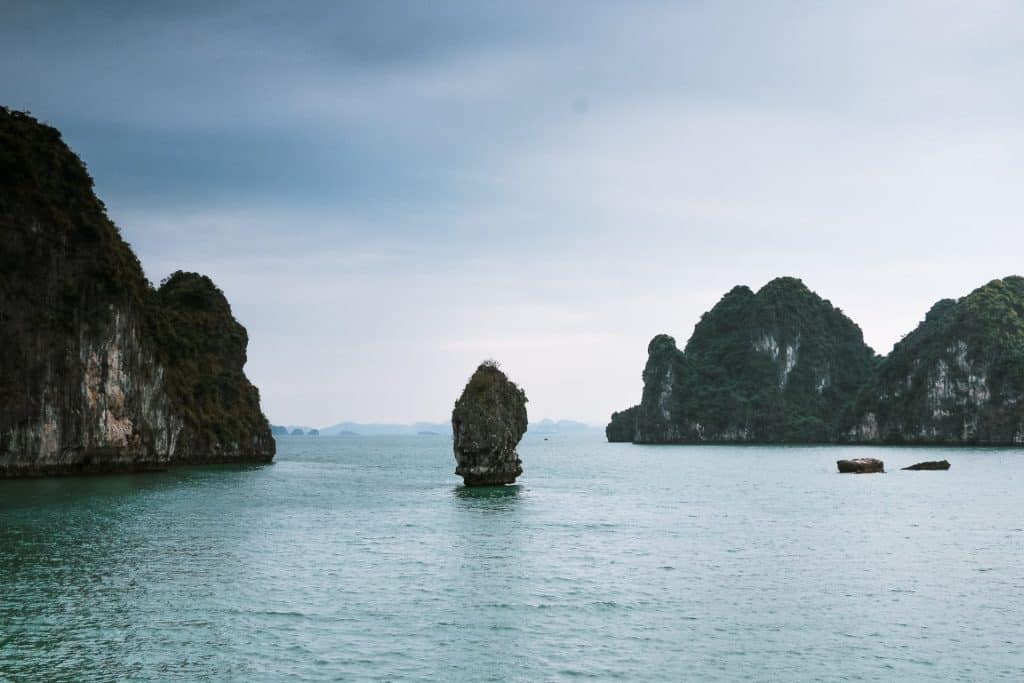
How To Get Around Vietnam 2-week itinerary

Vietnam 2-week Itinerary
Day 1 vietnam itinerary: explore the busy ho chi minh city (hcmc).
- Read More: A Perfect 3-day itinerary in Ho Chi Minh City
- Suggested Tour: An excellent option is to join this Ho Chi Minh City Guided Tour where you will have the chance to explore the best things to do in the city, accompany by a professional local guide.
The best way to start your Vietnam 2-week itinerary is by strolling the busy streets in HCMC . At first, you will get overwhelmed with the people, smells, and especially the traffic. Don’t you worry, it is normal and after a day you should feel more comfortable around this chaotic city!
There are a lot of things to do in HCMC . Take your time to explore and have fun just wandering around, trying street food, drinking Vietnamese coffee, walking the alleys, and getting lost – you will see a lot of interesting things and it is a great introduction to Vietnam.
In the afternoon, visit the Ben Thanh Market where you can find all sorts of produce and souvenirs. But if you’re interested in buying something, practice your negotiating skills. As expected, the vendors normally start at a price of 50% higher because bargaining is expected.
Finish the day by heading to Pub Street . There are many bars and restaurants, including the rooftop. This street is a mix of locals socializing, being seen or working hard selling all sorts of things, and tourists having fun. It’s a place to observe and immerse in the culture of the younger Vietnamese people.
If the Pub Bar sounds too much for you – handling the noise and crowds, another excellent option is to join the Bitexco Tower offering stunning views of a 70-floor building, followed by a Dinner Cruise tour down the Saigon River.
Best Accommodations in Ho Chi Minh City:
- TOP OVERALL PICK: Hotel Grand Saigon is one of the most budget-friendly luxury hotels in District 1 and it’s set in a restored colonial building.
- BUDGET: Toi’s Travel Home Central is a quirky place that offers both dormitory-style rooms and private rooms so there’s something for every budget
- MID-RANGE: Icon Saigon – Lifestyle Design Hotel is an excellent location for exploring Ho Chi Minh City as the Saigon Opera House and the City Hall are both nearby.
- LUXURY: The Myst Dong Khoi is a luxury 5* hotel that’s known for its spectacular interior design, sophisticated rooms, and fantastic facilities.

DAY 2: Explore the busy Ho Chi Minh City (HCMC)
Start your second day of this Vietnam 2-week itinerary by enjoying the beautiful architecture in Ho Chi Minh City. Walking around Ho Chi Minh City, you’ll observe the strong French influence in some architecture, cuisine, and even some ways of life, since Vietnam was once a French colony.
Head to Ho Chi Minh City Hall , a gorgeous building with a French colonial design. Just a short walk you can see other landmarks from the French, Notre Dame Cathedral, and just across the street the beautiful Saigon Central Post Office. Just a short walk visit the Reunification Palace, built in the 60s, during the Vietnam War to be the president’s residence.
The afternoon I spent visiting the War Remnants Museum , but while the exhibits are very moving in the way to show the reality of the war, it can be difficult to swallow some of the reality.
Expert Tip:
I was well-located and walked to the sites in the city. I have found that walking is a great way to explore a city and get to really see it. When needed, I took an Uber and it worked great at a very low rate, I super recommend it. Renting a scooter is an option, but unless you grew up in a major city in Vietnam, I would not recommend it. Traffic rules are very different and the roads are super congested. (Think about walking through a shopping mall during a Christmas rush…now imagine it on scooters instead of walking…that is Ho Chi Minh City).

DAY 3 Vietnam Itinerary: Take a Day Tour to Cu Chi Tunnels & Mekong Delta
Third and last day of your Ho Chi Minh itinerary, take it outside the city and explore the amazing surroundings. The Chu Chi Tunnels are located about 90 minutes from HCMC. The site is fascinating and very educational to visit as these tunnels were used during the War.
This side trip is a must if you have time, and I not only enjoyed it but also learned a lot. I booked a private tour from a pick-up at my hotel and for a day I explored the Mekong Delta, visited the Cu Chi Tunnels, and had other amazing activities included for a very affordable price, with a local guide who explained all about this region.
My Recommendation for the Best Tour:
- This is the tour I used and the one I recommend : You will visit the Cu Chi Tunnels , one of the most popular places in Vietnam related to the Vietnam War, built by the Viet Cong in their fight against US forces, these narrow tunnels allowed soldiers to live supply routes.
- After visiting the Cu Chi Tunnels you will head to the Mekong Delta , an incredible opportunity to see floating markets, swampy mazes, and rural rice paddies.

DAY 4 Vietnam Itinerary: Uncover the Atmospheric Hoi An
- Read More: Top Things to do in Hoi An
- Suggested Transportation: I flew Vietnam Airlines from Saigon to Danang, approximately a 1.5-hour flight.
Next on this Vietnam 2-week itinerary, I took a flight heading south along Vietnam’s coast, and I spent a few days in the amazing city of Hoi An . Smaller and more laid back this ended up being my favorite city in Vietnam. Hoi An is a UNESCO World Heritage Site dating from the 15 th to the 19 th century and it is very well preserved.
Hoi An is also well known for tailor-made clothes and shoes – oh, so dangerous for your wallet! Ho An is very conveniently located on Vietnam’s central coast, making it an ideal location for side trips.
Take your first day to stroll around the Hoi An Ancient Town and enjoy the ancient yellow buildings, as they are exceptionally well-preserved and you will easily spend time just wandering from one picturesque street to the next without getting bored.
While here, you can rent a motorbike or a bike and explore the old town, the beaches, and the rice paddies around the town. Traffic here is much calmer and experienced scooter riders will not feel uncomfortable driving. I also used the scooter to take a side trip to Danang.
Best Accommodations in Hoi An:
- TOP OVERALL PICK: Little Riverside Hoi An is a gorgeous hotel situated along the Thu Bon River and is home to endless facilities including an outdoor swimming pool, an on-site spa, a restaurant, and a bar
- MID RANGE: Golden Holiday Hotel & Spa has beautiful rooms and even better it is super affordable, especially as breakfast is included with your stay.
- LUXURY: Allegro Hoi An – A Little Luxury Hotel & Spa is a 5* hotel located close to the Japanese Covered Bridge and offers free bicycle use so you’ll have no problems exploring Hoi An.

DAY 5 Vietnam Itinerary: Continue to Explore the Best of Hoi An
Today is another great opportunity to continue to explore Hoi An. Start your day walking by the river , and visit some of the landmarks like the Japanese Covered Bridge , dating from the 17th century.
In the town, there are a number of houses you can visit, such as the Tan Ky and the Duc An homes are two of the more popular ones to visit, so make sure you allow some time for this! These two buildings have been inhabited for generations, with the Duc An House being around 400 years old.
After you emerge on some of the stunning architecture, it is time to enjoy the tailor shops in Hoi An . The streets and galleries are packed with tourists carrying designer magazines, and the local tailors can reproduce pretty much anything!
Once the sun goes down, the city transforms to the street yellow light and you should make your way to the Hoi An Night Market , where you can find souvenirs, carving, and some amazing street food.
- This night market tour of Hoi An includes a walking tour of the Ancient Town and then you’ll have a 30-minute cruise along the river. This will give you the perfect opportunity to see the city lit up at night!

DAY 6 Vietnam Itinerary: Continue to Explore the Best of Hoi An
In the morning, take an adventure across to the island village of Cam Nam , it is calmer than the city center and you can see plenty of fruit trees. If you love fresh food and are curious to see where the yummy food in Hoi An comes from visit the Tra Que Vegetable Village and experience the small farming community.
There is also amazing food in Hoi An to explore. This tour is limited to twelve people and you’ll get to visit some of Hoi An’s best foodie hotspots. Not only will you get to try authentic cuisine but you’ll be given other recommendations during your stay!
You can also rent a bicycle and ride on dirt roads and concrete paths among the rice fields. This is another great way to enjoy the beautiful scenery and observe the life of the locals who work in the fields. End your day relaxing by the public beach of An Bang Beach or Hidden Beach .
Best Tours in Hoi An:
- If you’d prefer a local’s advice then I recommend checking out this walking food tour
- I highly recommend this awesome cooking class that takes place in someone’s home so you’ll get the ultimate local experience.
- This Cooking with Jolie in Hoi An focuses on using the freshest ingredients possible and will teach you how to make four traditional Vietnamese dishes.

DAY 7 Vietnam Itinerary: Take a Day Trip to the Hindu Sanctuary of My Son
- Read More: Ultimate Guide to visit My Son Sanctuary
- Recommended Tour: My Son Sanctuary Luxury Trip will take you to visit the temples of My Son, also including a cooking class and lunch at a local home, and a boat ride.
There are so many places to visit around Hoi An as a day trip. On day 7 of this Vietnam 2-week itinerary, I choose to visit My Son Sanctuary, located only 1 hour from Hoi An. You can rent a motorbike or hire a private guide to drive you.
The UNESCO World Heritage Site of My Son is located in a lush rainforest creating a dramatic site. It was built between the 4th and 13th centuries CE, and during this time, Cham was a unique culture that developed on the coast of modern Viet Nam and had its spiritual origins traced back to Indian Hinduism.
Back to Hoi An, don’t miss the Precious Heritage Gallery by world-famous photographer Rehahn. His mission to collect and photograph the costumes of each of Vietnam’s native tribes is stunning to behold. For dinner, you have plenty of amazing options for cafes and restaurants for some traditional or fusion food.
This tour is the best option if you are looking to combine a visit to the My Son Sanctuary, and also, visit the main sites in HoiAn with a local guide. It includes hotel pick up and the whole length of this tour is approximately 7 hours.

DAY 8 Vietnam Itinerary: Take a Day Trip to the Marble Mountains
- Read More: Complete guide to visit the Marble Mountains in Da Nang
- Recommended Tour: Marble Mountain from Hoi An Private Tour , is a 6-8 hours tour with a local guide, offering the best opportunity to learn and explore the best of this Vietnam area.
On day 8 of this Vietnam 2-week itinerary, I rented a motorbike and took a day trip to the city of Danang , to visit the Marble Mountains. A group of five limestone and marble mountains several of which you can climb. You can easily spend a full day exploring this fascinating site!
It is easy to get here, only a one-hour drive from Hoi An. Also, it is cheap, you will find amazing opportunities for photos, have fun exploring the intriguing pagodas and sites, pulse get a 360 degrees view from the top!
The Marble Mountains in Danang are a group of unique five limestone and marble hills in the Ngu Hanh Son District. The mountains’ sheer, porous limestone is punctuated by caves, hiking trails, and tunnels , which are fitted with spectacular Buddhist and Hindu shrines.
If you don’t want to rent your own motorbike to go visit Marble Mountain, this excellent tour offers hotel pick up and they will take you from Hoi An during a 4-hour journey to visit the Marble Mountains and the Lady Buddha.
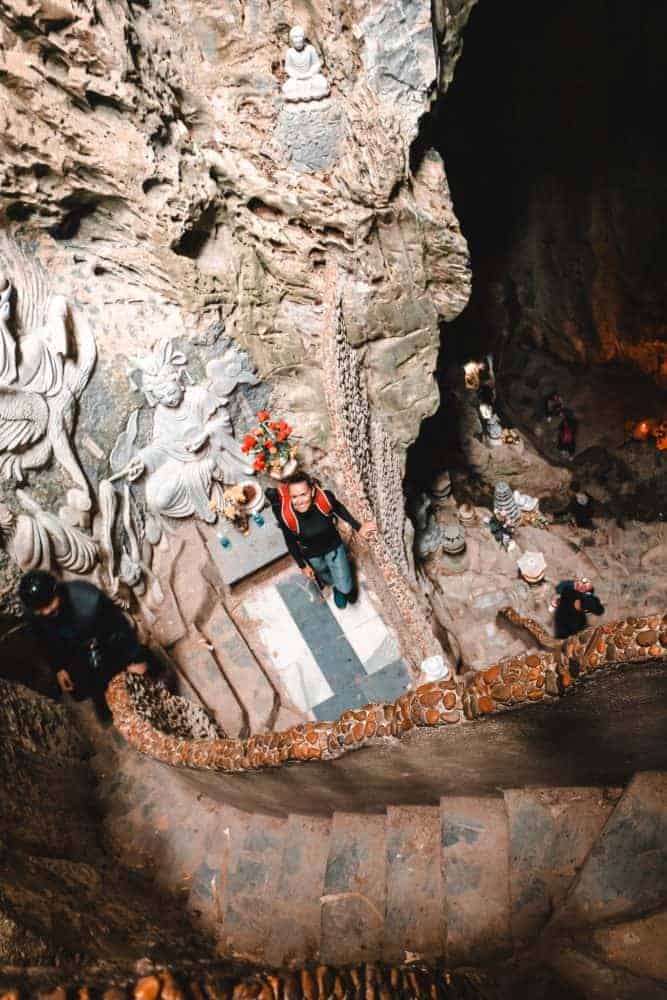
DAY 9 Vietnam Itinerary: Travel to Sapa Town
- Read More: How to do an authentic homestay in Sapa
- Suggested Transportation: I flew Vietnam Airlines from Danang to Hanoi, and took a night train from Hanoi to Sapa
From Hoi An I flew to Hanoi, which is an approximately 2 hr. flight. Arriving in Hanoi I had my night train already booked to Sapa, so I took an Uber from the airport to the train station. You can check options for the night train . While in Sapa, the only transportation you will need is your feet. My night train arrived early morning in Sapa town and my Black Hmong guide was waiting for me at the train station, as I had made arrangements with my guide prior to my trip to Vietnam.
We started hiking to the steep mountains of Sapa. We hiked for about 4 hours, and we arrived at my Homestay at my guide’s house, where she cooked an amazing meal on the fire pit in the middle of the kitchen, while I played with the kids.
If you don’t want to do a homestay with one of the tribes in Sapa, you have the option to visit only the town of Sapa and its surroundings, with the opportunity to visit some villages for a day of hiking.
- If you also want to visit Sapa during your Vietnam itinerary, you have the option to book a tour in advance with a travel agency, and I recommend choosing an ethical tour operator like this one . Or you can book directly with a local lady, if you are interested in my friend Bau, please leave me a comment at the end of this article and I will personally connect with you to provide her contact information.

DAY 10 Vietnam Itinerary: Hike the Misty Mountains in Sapa and Experience Homestay with Black Hmong
On day 10 of my Vietnam 2-week itinerary, I started with an amazing homemade and fresh breakfast, we left for another day of trekking, visiting some local remote villages, visiting the local school, crossing bridges, and seeing some local ladies washing clothes in the river, and visiting the local market to shop for fresh ingredients to cook dinner at my homestay.
During my Sapa hiking, besides the challenges to hike on muddy terrain and up the hills and narrow paths around the rice paddies, I was constantly rewarded with stunning views of the mountains and the villages.
I watched a family making knives and swords, visited the school in the village, crossed beautiful bridges, and saw local ladies washing clothes in the river. Along my hiking in Sapa, I also crossed pigs, dogs, water buffalos, chickens, and cows…all animals walk freely or on private property and I loved seeing people respect animals and treat them as part of their family.
Read More About My Experience in Sapa:
- I would recommend you to read more about what a typical day at a homestay in Sapa looks like , where share a lot of details you will love to learn before you go trekking Sapa and do a homestay with a local hill tribe.
- Also, this 3-day itinerary in Sapa will explain in detail what to expect when you go hike and homestay in Sapa.
- This article explained all about the sustainable tourism of homestays in Sapa

DAY 11 Vietnam Itinerary: Hike the Misty Mountains in Sapa and Experience Homestay with Black Hmong
When you choose to go trekking Sapa and do an authentic homestay, be prepared for a real-life experience with the local hill tribes. They will share everything with you. I really mean, EVERYTHING! Their house, the families, their culture and even their clothes and they’re…well, partyyyyy! 😉
I was so honored to be invited to a local wedding and I have decided to skip the last day of trekking to participate in a traditional and authentic experience. If you are lucky and stay with a local family, you most likely will have the best experience and will participate in the real life of the local tribes in Sapa. I have written a very comprehensive Sapa Ethical Travel Guide .
The fun part started when I had to dress appropriately for the party, which means, I wouldn’t wear my fancy muddy trekking clothes, but instead, I had to wear one of the traditional Black Hmong homemade beautiful clothes. I am not a big girl, but still, the clothes were small for me, considering that the Black H’Mong people are smaller than me.
After the party, I head back to Sapa town and took my night train back to Hanoi.

DAY 12 Vietnam Itinerary: Travel to Hanoi to continue the trip to Halong Bay
- Read More: Best Luxury Cruises in Halong Bay and also Best Overnight cruises in Halong Bay
- Recommended Transportation: Took a night train from Sapa to Hanoi. My cruise tour operator picked me up in Hanoi with a shuttle to Halong Bay.
I took the night train in Sapa back to Hanoi, and I was picked up by my cruise company. I rode in a mini-bus with other travelers from Hanoi to Halong Bay. The cruise company also transported us back to Hanoi (round trip Hanoi-Halong was included in the cruise). The drive was 4 hours each way.
Spend the day sailing among the majestic limestone tasks and relaxing on board the junk boat. Have a drink on the rooftop while appreciating the amazing limestone formations. Visit the floating village and get to see how some local families still live on the bay.
Visiting Halong Bay involves taking a tour, and there are boats of all different budgets, sizes, styles, and with different activities offered, and I recommend doing your research to find the most suitable option for you. Some highly recommended are:
My Recommendation for Tours in Halong Bay:
- La Pinta Cruise was my choice for an overnight cruise in Halong Bay, and I highly recommend it. The boat is great, the accommodations are very comfortable, and the service and food are outstanding.
- All-Inclusive 3-day & 2-night Halong Bay and Lan Ha Bay route tours are one of the most amazing options out there! Not only will you get to visit a variety of destinations, but this cruise puts more of an emphasis on onboard activities and socializing.
- 2-Nights on Best Balcony Cruise is the perfect option. Ran by Halong Bay Cruise Hunters, you know you’re in for a fantastic time as this company has thousands of reviews on Tripadvisor.

DAY 13 Vietnam Itinerary: Relax on Board a Junk Boat on Halong Bay
Halong Bay is the most visited place in Vietnam and every year millions of people come here, and for a reason. The opportunity to sail on a junk ship through hundreds of dramatic limestone mountains isn’t something to be missed.
There are so many karst islands and rocks rising from the water in every direction that it looks mystic. There are caves, secret lagoons, sea gypsies, and approximately 1,900 islands and islets that will just take your breath away. For this reason, the only way to visit Halong Bay is by boat .
The cruise lines offer different tours. The one I took I go to visit a cave which was very intriguing.
In the afternoon I grabbed a kayak and explore the Bay taking the time to appreciate the beauty of this unique place. At night enjoy a very fun cooking class on board your junk boat.

Last day of my 3-day cruise, lounging out on my balcony while watching the majestic scenery of this place before I get back on the road and continue my amazing journey on the way to a week in Cambodia .
Check the section below for very helpful logistics to plan your safe and fun Vietnam 2-week itinerary and safe travels!

Vietnam Trip Resources
Planning a trip to vietnam.
During my planning for the Vietnam 2-week itinerary, I researched the internet and also, bought some books and maps to help me with my itinerary in advance. An excellent guidebook that I used during my itinerary preparation is the Lonely Planet Vietnam Guidebook, as it has tons of great information.
Also, visiting at least one big city to get the vibe of the unstoppable lifestyle in Vietnam is a great idea and you can check between Hanoi vs Saigon and see which city fits best for you . I booked almost everything in advance – flights, accommodation, trains, and tours to Sapa and Halong Bay .
Keep in mind that pre-planning, researching, and understanding what you are looking for will help make your travels far more successful and safe. Make sure you check the following articles:
- Vietnam Travel Tips: Everything you need to know before your trip
- 7 Days Vietnam Itinerary
- Best Hoi An itinerary
- Best Ho Chi Minh City Itinerary
- Best Hanoi Itinerary
- Best Da Nang itinerary
- Incredible things to do in Mui Ne
- 10 Most Incredible Halong Bay Luxury Cruises
- Halong Bay Overnight Cruises: Best things to do + Best Tours
- 15 Essential tips before you go on a cruise in Halong Bay
- Complete Guide to visit Marble Mountain
- Complete Guide to visit My Son Sanctuary
- 3-day in Sapa Itinerary + Authentic Homestay
- All you need to know before you go to Sapa Homestay with a Black Hmong family
- Sapa Ethical Travel: Why you should book with an independent guide
Arrival in Vietnam
You will need a visa to visit Vietnam. You can either apply for a visa via the Vietnamese embassy/ consulate or via one of the methods below:
- Visa on Arrival (VOA) – This is the most popular option for visitors arriving by plane. Go to Vietnam-visa.com to fill out an online application and pay the US$20 fee. You will receive an email with the VOA letter that you print out and show upon your arrival in Vietnam, and you will need to pay for your visa stamping in US dollars, cash only. The single-entry stamping fee is US$25, and the stamping fee for a multiple-entry visa valid for up to 3 months is US$50.
- E-Visa – Citizens of around 80 countries, including the USA and UK can apply for a single entry e-visa valid for 30 days and costs US$25.
Where to Stay in Vietnam
While the right accommodation options depending on your travel style, I am providing some recommendations for places to stay in Vietnam for each stop during my 2-week Vietnam itinerary.
Vietnam has plenty of accommodation options from hostel to luxury, as well as between and you will find whatever is suitable for you. Consider if you are planning to visit during the high season and book your accommodation in advance.
Accommodation in Vietnam is generally very affordable, and you have many options to choose from. Check the best options for hotels, B&B, or Villas.
If you value local or unique experiences like me and like to have a more authentic experience in the places you visit, check the options for guest-house.
How Much Does It Cost 2 Weeks Itinerary in Vietnam?
Traveling around Vietnam is very affordable, and prices can vary quite a lot depending on your preferences. Some people can travel around Vietnam spending an average of $30 a day per person – considering if you eat street food and use a hostel for accommodation.
My trip to Vietnam was a mid-range budget of $72 per day per person . I used a combination of 3 stars hotel, a homestay with a local family in Sapa, with a 5-star cruise in Halong Bay, which was also my biggest expense. I ate street food and also some meals at a restaurant. I opted to fly from one location to another since it saved me time. See below my average price for 2 people to spend 2-week in Vietnam:
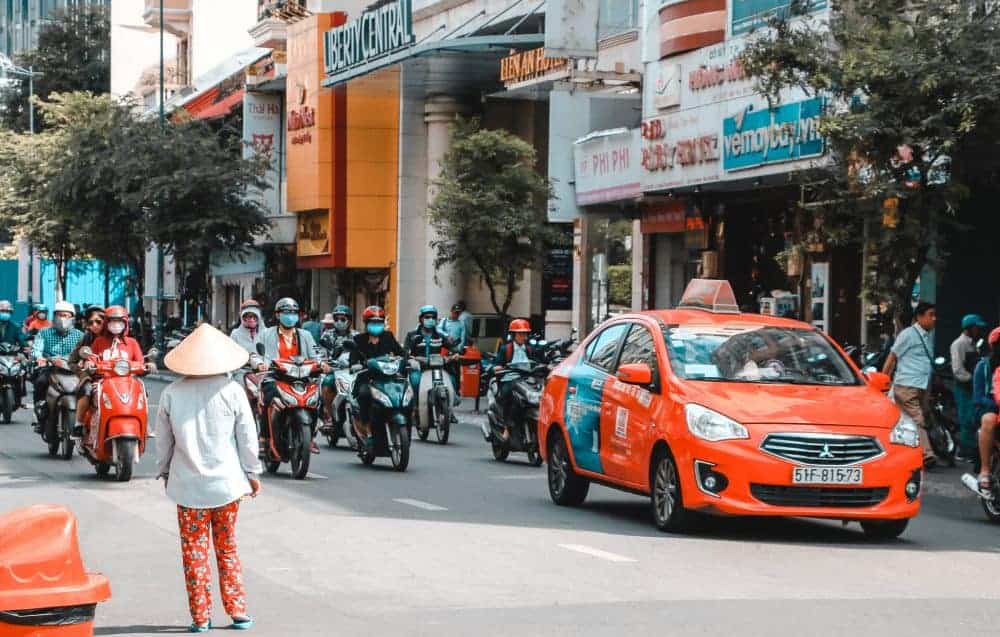
When is the Best Time to Visit Vietnam?
The weather in Vietnam can be split by region.
- In Hanoi & the north, May to October is hot and humid with high rainfall; November to April is cooler and dry.
- In the far north, December & January can be particularly cold.
- Central Vietnam experiences hot, dry weather between January & August when temperatures can hit the mid-30 °C; whilst high levels of rainfall can occur in September, October & November.
- Southern Vietnam is generally dry and hot from November to April, and warm and wet between May & October, with the highest rainfall in June, July & August.
What to pack for Vietnam 2-week itinerary
- A travel backpack bag for a change of clothes
- Dry-fit clothes and layers are also a great idea
- Some warm clothing is needed as the mornings and nights can be quite cool
- Comfortable shoes
- Summer dress
- A pair of jeans
- A rain jacket is a must any time of the year
- Hiking pants
- Extra socks, hat, underwear, and swimsuit if you plan to swim in the waterfall
- Toiletry, toilet paper, and mirror
- Personal items such as medication, flashlight, sunscreen, insect repellent, and wipes
- Some snacks and a water purifier bottle

- Book in Advance – Especially if you are traveling during the high season. You will have more options to choose from accommodations, and you will have a better plan for activities and transportation options.
- Halong Bay – I recommend doing the 3-day cruise , as you can see more of the majestic beauty of this place and also, relax during your busy travel schedule.
- Visit Hoi An – Even if you are short in time, prioritize Hoi An as it has so much to offer and the side trips are amazing.
- Vietnamese Coffee – In my option, it is the best in the world!
- Homestay in Sapa is amazing – If you have the time, include Sapa in your itinerary. Read here more about my experience with homestay with a local tribe.
- Mind the weather – Don’t underestimate the weather, as it can be extremely hot in the summer and very wet.
- Crossing the streets – In the big cities, the traffic is INSANE. Traffic lights don’t mean they will stop for you. Please, be careful!
- Cover up – When you visit temples and pagodas.
- Bargain – Negotiating price is not rude, it is expected!
- Buy SIM card in Vietnam: You can buy a SIM card in Vietnam at the airport, upon your arrival in the country. You’ll find dozens of kiosks selling SIM cards as soon as you exit the baggage claim area in any of Vietnam’s international airports.

HUAWEI E5577s-321 Mobile WiFi Router
I recommend buying this WiFi router. You can insert any SIM card around the world, and it shares data across all your devices, up to 10, via WiFi and the battery lasts up to 12 hours.
Vietnam 2-week itinerary Conclusion
This is a very detailed Vietnam 2-week itinerary, and I hope this can help you to plan your trip and explore the best of Vietnam. Vietnam is a safe country to visit, and it is great for anyone visiting on a budget too. Just make sure you pre-plan in advance, and if you have any additional questions or suggestions just leave a comment below.

Follow + Share
If you found this guide useful, follow me on Instagram to stay up to date with my travels & Subscribe to my YouTube Channel to keep you with my workout videos.
I would love it if you could follow me on Pinterest and share this guide on my social media.
Plan your Trip
You can plan your trip with this easy guide and have access to the best services I recommend and you can get discounted prices.

Why Halong Bay Luxury Cruises Are Worth Every Penny!

Vietnam Travel Tips: How to Plan a Perfect Trip to Vietnam
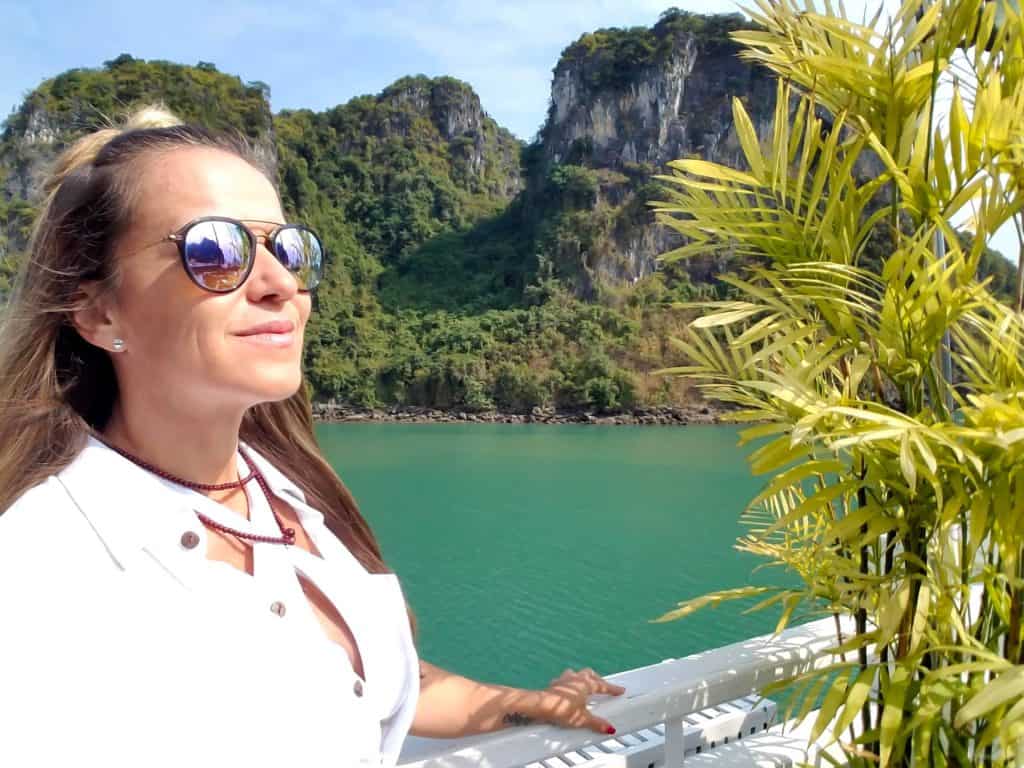
Vietnam Itinerary 7 Days: The Best one week in Vietnam
24 thoughts on “the perfect vietnam 2-week itinerary + insider tips”.
This is brilliant! Such a perfect itinerary for two weeks. Where is your fave spot in Vietnam? I miss the food sooo much! All the best, Cassie xxx
Do you know what I like about this blog? I don’t need to read any other to have a perfect itinerary! Congratulation, very good reading
This is a great Itinerary. I have been thinking of going at the end of the year if that’s possible or maybe next year. This will come handy.
I’d love to go on a SEA tour one day and this will definitely be helpful. Thanks for sharing 🙂
I canceled a trip for April to Vietnam so this will be helpful when I rebook. Such a complete itinerary.
I needed this! I’m planning to go next year (hopefully the pandemic is over by then). I was there in 2015 for a press trip but only stayed for four days in Halong-Hanoi area. Pinning 🙂
What a detailed Vietnam guide! I’ve been wanting to go for ages and will definitely keep this article handy 🙂
What a wonderful itinerary, Paula! I love SEA so I am sure I will use it on my next trip here ? Vietnam has been such a bucket list destination for me and your photos make me wanna go there asap.
I absolutely LOVE Vietnam! I spent a month there a couple of years ago and did a very similar route to you! I especially loved Hoi An and Ha Long Bay. I would also recommend stopping at Ninh Binh if you go again!
This is so great! Vietnam has a special place in my heart <3 Thanks for the helpful guide!!
Saving this one for when travel resumes. We’ve been wanting to go to Vietnam for years, and it seems like we should actually try to make it happen. Great post!
Such a great and thorough guide 🙂 Thanks so much for all the info! I haven’t been to Vietnam yet, but it’s on my list – hopefully in the future!
Hi Nele, I am so happy to hear you enjoyed this guide. I hope you get to visit Vietnam one day, it is an amazing destination to explore.
Thank you Agnes, I am happy to help. I loved Vietnam and I am sure you will love it too!
Brit, I hear you – Vietnam has a special place in my heart too. Not only the gorgeous landscapes, but the people help to make this place even more amazing.
Thank you Ellie, I will absolutely keep your advice to visit Ninh Binh next time. I agree with you, Hoi An and Halong Bay are absolutely phenomenal places and I cannot wait to go back to Vietnam.
I am so happy to hear you enjoyed this guide Charu. I hope you get to travel to Vietnam soon.
Thanks Jiayi for visiting my blog and I am glad you found my guide helpful. I hope you get to visit Vietnam soon, you will love it!
I am so glad to hear you found my guide useful. Hopefully next year traveling will remain and be safe. I am also planning to go back to Vietnam, as I made some dear friends there.
Hi Karen, first of all I am sorry you had to cancel your trip to Vietnam. But hopefully you will rebook it at a safer time, I cannot wait to go back to explore our wonderful Planet.
I hear you! I have been exploring SEA for a few years now and each place I visit, I hold a very special place in my heart. I have been wanting to go and spend a few months on a row next time.
Hello Suvarna, I am so happy to hear you found my itinerary handy. Hopefully you will be able to visit Vietnam anytime soon too.
Thank you so much Fernanda. I try to put as much detail as I can into my itineraries and I am so happy to hear you enjoyed it.
Hi Cassie, thank you so much for checking my blog and for your kind feedback. My favorite place in Vietnam is Sapa, I absolutely love horw isolated and I made a great friend there from the H’mong hill tribe. Ohhhh the food, one of the best in the world, right?
Leave a Comment
This site uses Akismet to reduce spam. Learn how your comment data is processed .
- Today's deals
- Search travel guides

Ultimate Solo Traveler’s Guide to Exploring Vietnam: Top Activities and Hidden Gems
Welcome to the ultimate guide for solo travelers heading to Vietnam! Whether you’re embarking on an adventure to uncover hidden gems, indulging in local cuisine, or simply soaking in the rich cultural heritage, Vietnam offers a plethora of experiences tailored for solo adventurers. In this comprehensive guide, we’ll explore the top activities, tips, and must-see locations to ensure your solo journey is unforgettable.
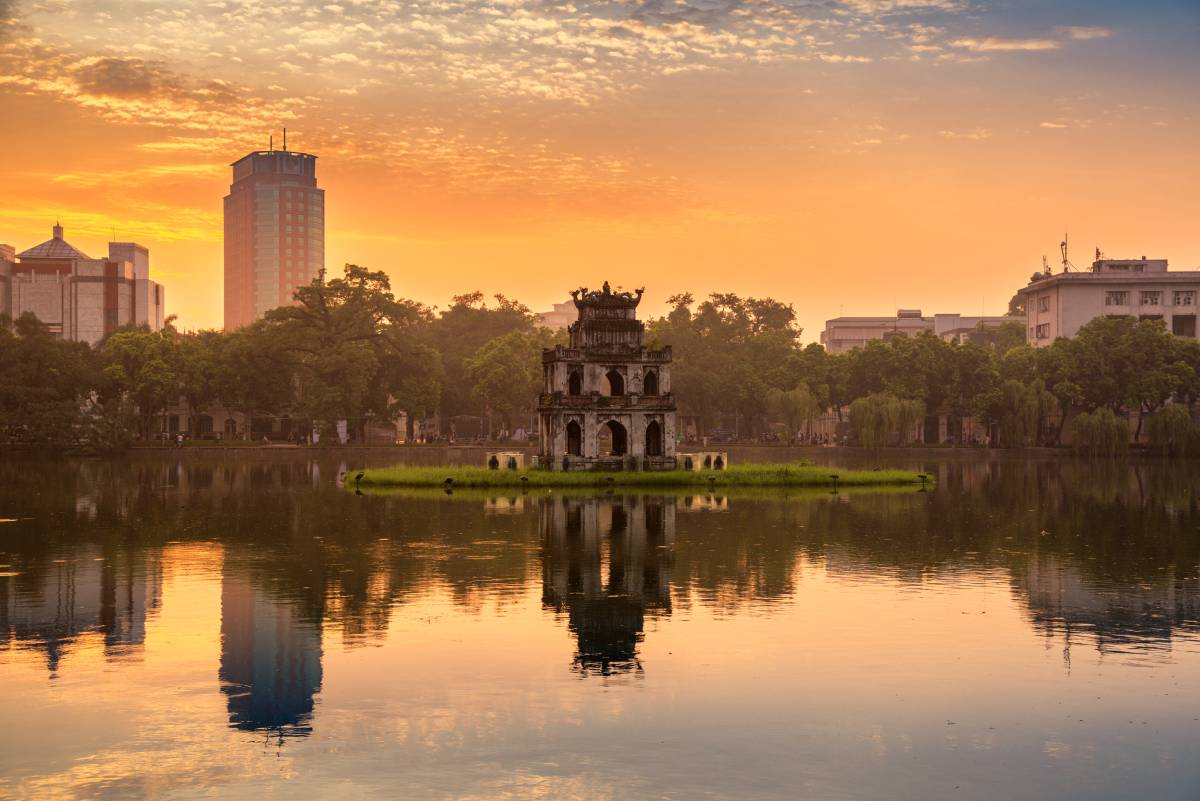
Why Choose Vietnam for Solo Travel?
Vietnam, with its vibrant cities, stunning landscapes, and welcoming locals, is ideal for solo travelers. The country offers a safe environment, affordable accommodation, and numerous opportunities to meet fellow travelers. From bustling metropolises like Ho Chi Minh City and Hanoi to serene destinations like Halong Bay and Hoi An, Vietnam has something for every type of solo traveler.
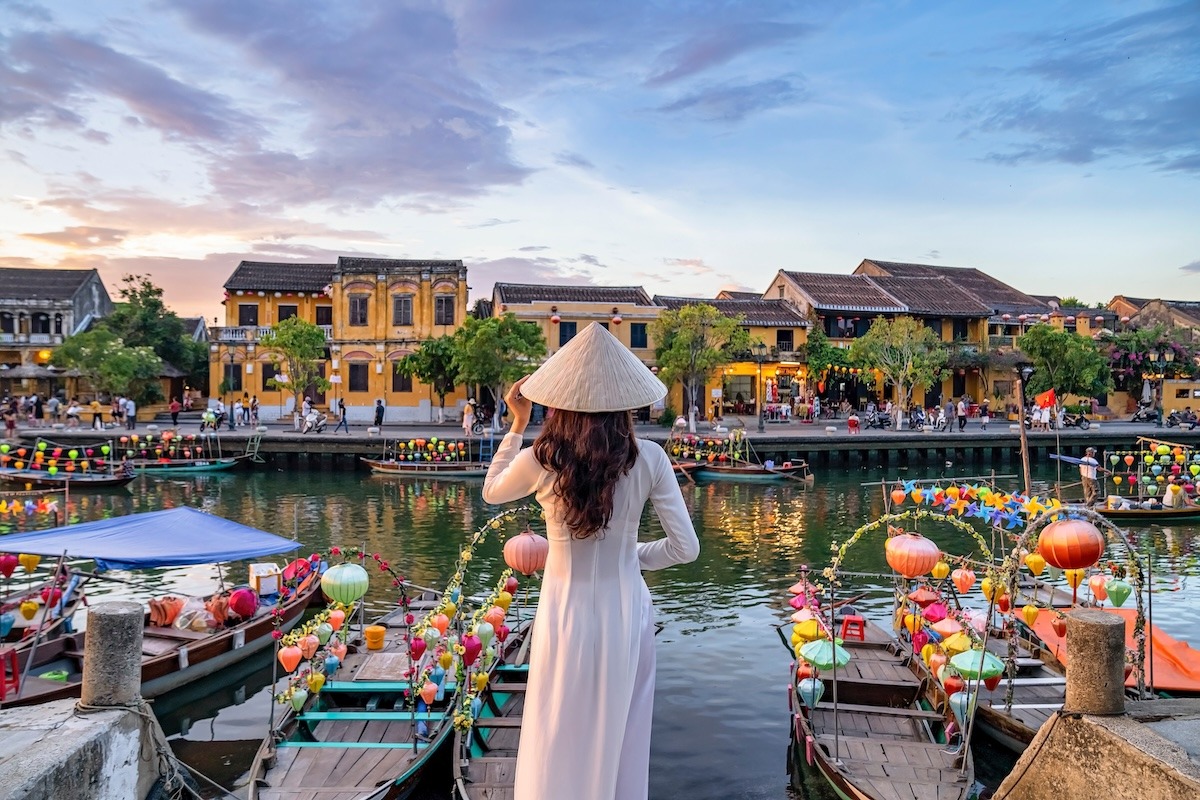
Day-by-Day Itinerary for a 7-Day Solo Trip
Day 1: arrival in hanoi.
Kick off your adventure in Hanoi , the capital city. Start your day with a visit to the Old Quarter , where the narrow streets and ancient buildings offer a glimpse into the city’s history. Don’t miss Hoan Kiem Lake , a serene escape in the heart of the city. For dinner, indulge in local street food such as pho or banh mi.
Day 2: Explore Hanoi’s Cultural Sites
Dedicate your second day to exploring Hanoi’s cultural treasures. Visit the Ho Chi Minh Mausoleum , the Temple of Literature , and the Vietnam Museum of Ethnology . For a unique experience, catch a traditional water puppet show in the evening.
Day 3: Halong Bay Cruise
No trip to Vietnam is complete without experiencing the breathtaking beauty of Halong Bay . Take a day trip from Hanoi to embark on a cruise through the emerald waters, dotted with limestone karsts and islands. Enjoy activities such as kayaking, swimming, and exploring caves.
Day 4: Travel to Hoi An
Catch a flight to Da Nang and make your way to the charming town of Hoi An . Known for its well-preserved Ancient Town, Hoi An is perfect for solo travelers. Wander through the lantern-lit streets, visit local markets, and take a cooking class to learn how to prepare Vietnamese dishes.
Day 5: Relax on Hoi An’s Beaches
Enjoy a leisurely day on Cua Dai or An Bang Beach , just a short ride from the town center. These beaches offer pristine sands and clear waters, perfect for a relaxing solo day out. Don’t forget to try some local seafood at the beachfront restaurants.
Day 6: Da Nang and Marble Mountains
Head back to Da Nang and visit the Marble Mountains , a cluster of five marble and limestone hills. Explore the caves, temples, and scenic viewpoints. In the evening, stroll along the Dragon Bridge and enjoy the vibrant nightlife of Da Nang.
Day 7: Ho Chi Minh City
Conclude your trip in Ho Chi Minh City , the bustling economic hub of Vietnam. Visit the War Remnants Museum , the Cu Chi Tunnels , and Ben Thanh Market . Take in the vibrant atmosphere of District 1 and enjoy a farewell dinner at one of the rooftop bars with stunning views of the city skyline.
Embarking on a solo journey in Vietnam is an enriching experience that combines adventure, culture, and relaxation. The country’s welcoming atmosphere, diverse landscapes, and rich traditions make it a top destination for solo travelers. Whether you’re exploring bustling cities, relaxing on pristine beaches, or discovering historical sites, Vietnam has something to offer every solo adventurer.
With careful planning and an open mind, your solo trip to Vietnam will be a memorable and transformative experience. So pack your bags, book your accommodations, and get ready to immerse yourself in the beauty and charm of Vietnam!
You may also like

Discover the Hidden Gems: The Ultimate Guide to Kanazawa’s Best Tourist Spots
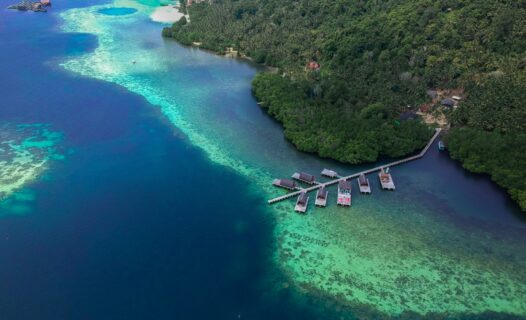
Exploring Bandar Lampung: Top Attractions and Hidden Gems to Discover
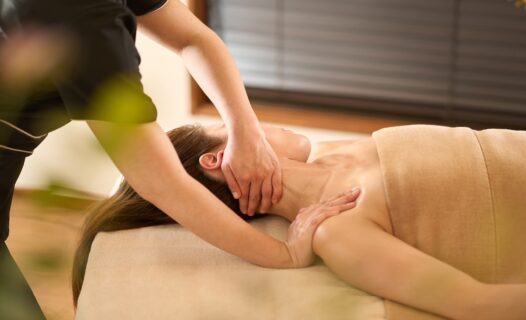
Relax and Rejuvenate: The Ultimate Guide to Finding the Best Massages and Spas in Taichung

Discovering Sibu: Top Tourist Spots You Can't Miss
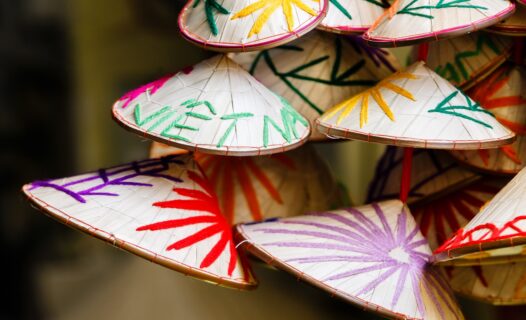
Unravel the Essence of Ho Chi Minh City: Best Souvenirs to Bring Home
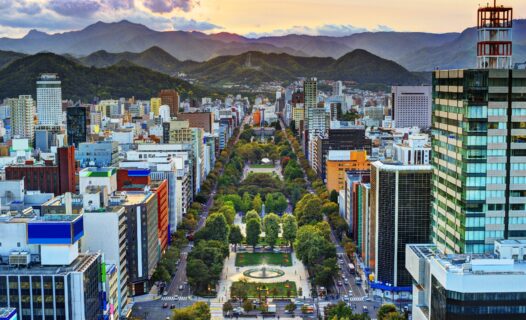
Sapporo Souvenir Shopping Guide: Must-Buy Keepsakes and Where to Find Them
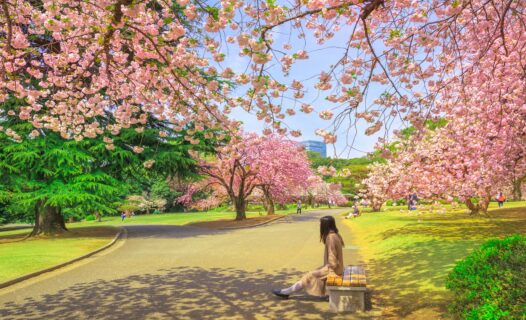
Exploring Shinjuku Gyoen: Tokyo's Serene Oasis Rich in History and Beauty

Unveiling Kota Kinabalu: Top Activities for the Solo Traveler
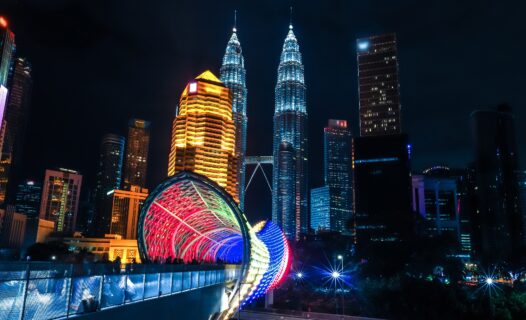
Vibrant Nights: Exploring Malaysia's Top Nighttime Attractions and Activities

Unveiling Nikko: Top Things to Do in Japan's Hidden Gem
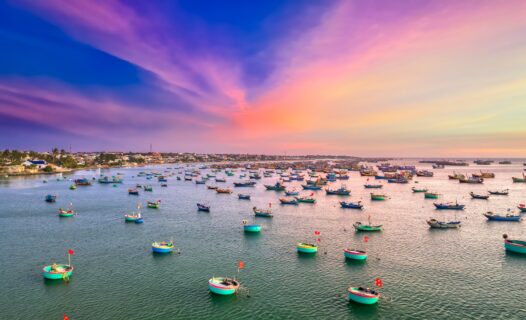
Discover the Best Time to Visit Phan Thiet: A Seasonal Guide for Travelers

Unveiling the Manhattan Skyline: A Spectacular Guide to NYC's Iconic Views

Discovering Joy in the Drizzle: Top Places to Play in the Rain in Tokyo
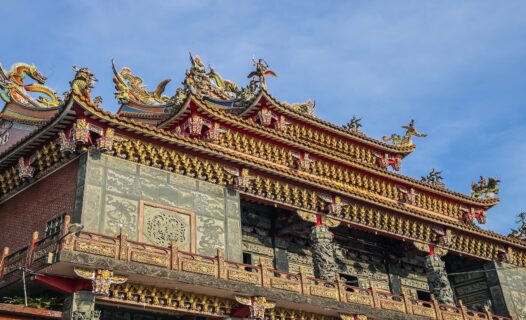
Exploring the Spiritual Heart of Taipei: A Comprehensive Guide to the City God Temple Worship
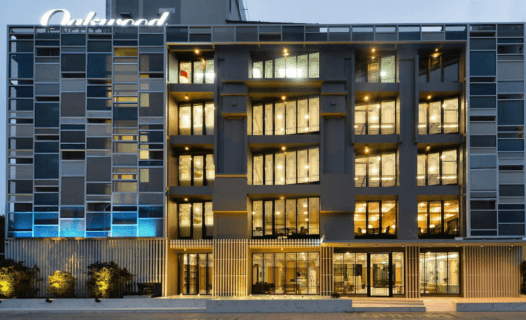
Experience Luxury Living in the Heart of Bangkok: A Comprehensive Guide to Oakwood Hotel & Residence Bangkok

A Culinary Journey Through Dalat: Discover the Best Restaurants and Must-Try Dishes
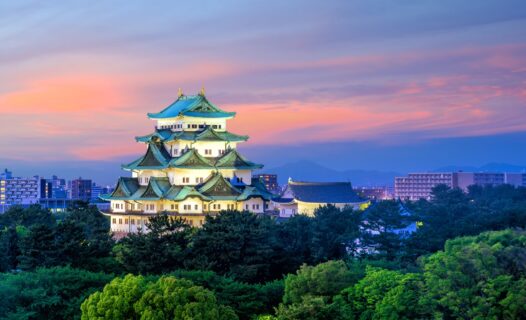
Discover the Magnificent Highlights of Nagoya Castle: A Journey Through History and Culture
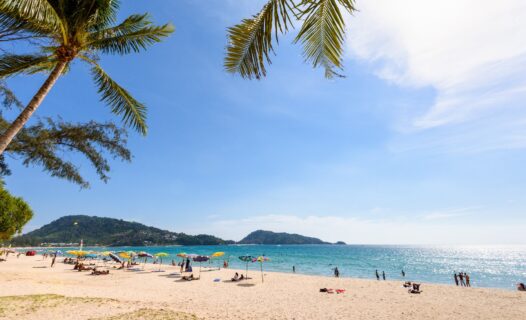
A Perfect Week in Phuket: Your Ultimate 7-Day Itinerary

Bangkok Shopping Guide: Where to Find the Best Markets, Malls, and Bargains

Unveiling Japan's Best Outlet Malls: A Shopper's Paradise

Explore the enchanting city of Kanazawa with this comprehensive travel guide. Discover top attractions, hidden gems, and essential travel tips for a memorable journey.

Discover the top attractions and hidden gems of Bandar Lampung, from natural wonders to cultural landmarks. Prepare for an unforgettable adventure in Sumatra's vibrant city.

Discover the best massages and spas in Taichung with our comprehensive guide. Relax and rejuvenate at top wellness centers and enjoy luxury spa treatments.

Discovering Sibu: Top Tourist Spots You Can't Miss
Discover the top tourist spots in Sibu, Sarawak. Explore this travel guide filled with attractions, cultural heritage, and nature adventures.

Discover the best souvenirs to bring home from Ho Chi Minh City. From traditional Vietnamese crafts to unique local goods, our guide will help you choose the perfect keepsakes.

Explore Sapporo's best souvenirs and where to find them. Discover unique keepsakes, gifts, and traditional items that capture the essence of Sapporo.

Exploring Shinjuku Gyoen: Tokyo's Serene Oasis Rich in History and Beauty
Discover the tranquil beauty of Shinjuku Gyoen in Tokyo. This comprehensive guide covers the best times to visit, attractions, and tips for an unforgettable experience.

Discover the best solo travel activities in Kota Kinabalu. From hiking Mount Kinabalu to exploring Tunku Abdul Rahman Park, here's your ultimate solo adventure in KK.

Vibrant Nights: Exploring Malaysia's Top Nighttime Attractions and Activities
Discover the best things to do in Malaysia at night, from vibrant night markets to exciting nightlife spots. Explore top attractions and activities after dark.

Unveiling Nikko: Top Things to Do in Japan's Hidden Gem
Explore the best attractions and activities in Nikko, Japan. From the stunning Toshogu Shrine to breathtaking hiking trails, our guide covers all you need to know.

Discover the best time to visit Phan Thiet with our comprehensive seasonal guide, full of expert tips, detailed itineraries, and weather insights.

Unveiling the Manhattan Skyline: A Spectacular Guide to NYC's Iconic Views
Explore the best places to witness the Manhattan skyline, from iconic observation decks to cozy rooftop bars. Your ultimate NYC skyline travel guide.

Explore the best indoor activities and attractions in Tokyo for a rainy day. Discover museums, indoor playgrounds, and shopping malls where you can enjoy Tokyo even when it's raining.

Explore the spiritual heart of Taipei with our comprehensive guide to City God Temple worship, including rituals, history, and must-see attractions.

Experience Luxury Living in the Heart of Bangkok: A Comprehensive Guide to Oakwood Hotel & Residence Bangkok
Discover luxury and comfort at Oakwood Hotel & Residence Bangkok. Explore amenities, dining options, and nearby attractions for an unforgettable stay in the heart of Bangkok.

Explore the vibrant culinary scene of Dalat with our detailed food guide. Discover the best restaurants, street food, and must-try dishes in Dalat.

Explore the rich history and stunning architecture of Nagoya Castle, one of Japan's most iconic landmarks. Join us on a journey through its highlights, hidden gems, and cultural treasures.

Discover the ultimate 7-day itinerary for exploring the best of Phuket, from its stunning beaches and vibrant nightlife to cultural excursions and culinary delights.

Discover Bangkok's ultimate shopping destinations, from bustling markets to luxurious malls. Plan your perfect shopping experience with our comprehensive guide.

Unveiling Japan's Best Outlet Malls: A Shopper's Paradise
Explore Japan's best outlet malls with our comprehensive shopping guide. Discover fabulous deals, top brands, and insider tips for a perfect shopping spree in Japan.
Last Updated: September 24, 2024
Current language
All languages.

+84 917 95 1100 |

Myanmar / Burma
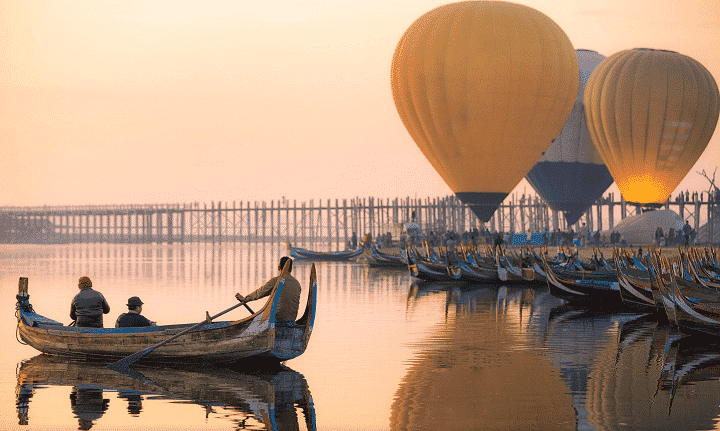
Multi Country
- Vietnam Tour Packages
- Cambodia Tour Packages
- Laos Tour Packages
- Myanmar Tour Packages
- Indochina Tour Packages
- Travel Style
- Mekong Delta
- + Travel Tips
- Travel Blogs
SAPA VIETNAM: TRAVEL GUIDE & THINGS TO DO
Sapa vietnam, sapa vietnam: best local travel guide & things to do + everything you should know before traveling.
Sapa Vietnam : A favourite destination for those who have ventured there, the old French hill station of Sapa is set amongst the picturesque Hoang Lien Son mountain range which is the highest in Vietnam . Inhabited by the Black Hmong ethnic minority and surrounded by many other colorful hill-tribe minorities, Sapa is a perfect place to go to appreciate the lifestyle of these friendly people, especially at the colorful markets.
Best things to expect in Sapa, explore the town overlooks a plunging valley of cascading rice terraces , trekking routes , colorful markets and with mountains towering above on all sides. In addition, views of Sapa offers an epic scenery that are often subdued by thick mist rolling across the peaks, but even if it’s cloudy, the little town is still a fascinating place to be, especially when local hill-tribe people fill the town with colour.
Few best reasons to visit Sapa Vietnam
Explore the breathtaking vistas, trek through rice terraces & ethnic villages
Get on top of Indochina, the Mt. Fansipan (Trekking or Cable car)
Spin around the jaw dropping valleys on a motorbike – O Quy pass or Tram Ton
Shop handicrafts on daily, weekends & night markets held by local Hmong
Choose to homestay in the middle of lush valleys, live with locals.
→ Spend few days hiking in Sapa’s terraced valleys, experience the Northern Vietnam’s must see places on a Best Sapa Tours including an overnight train.
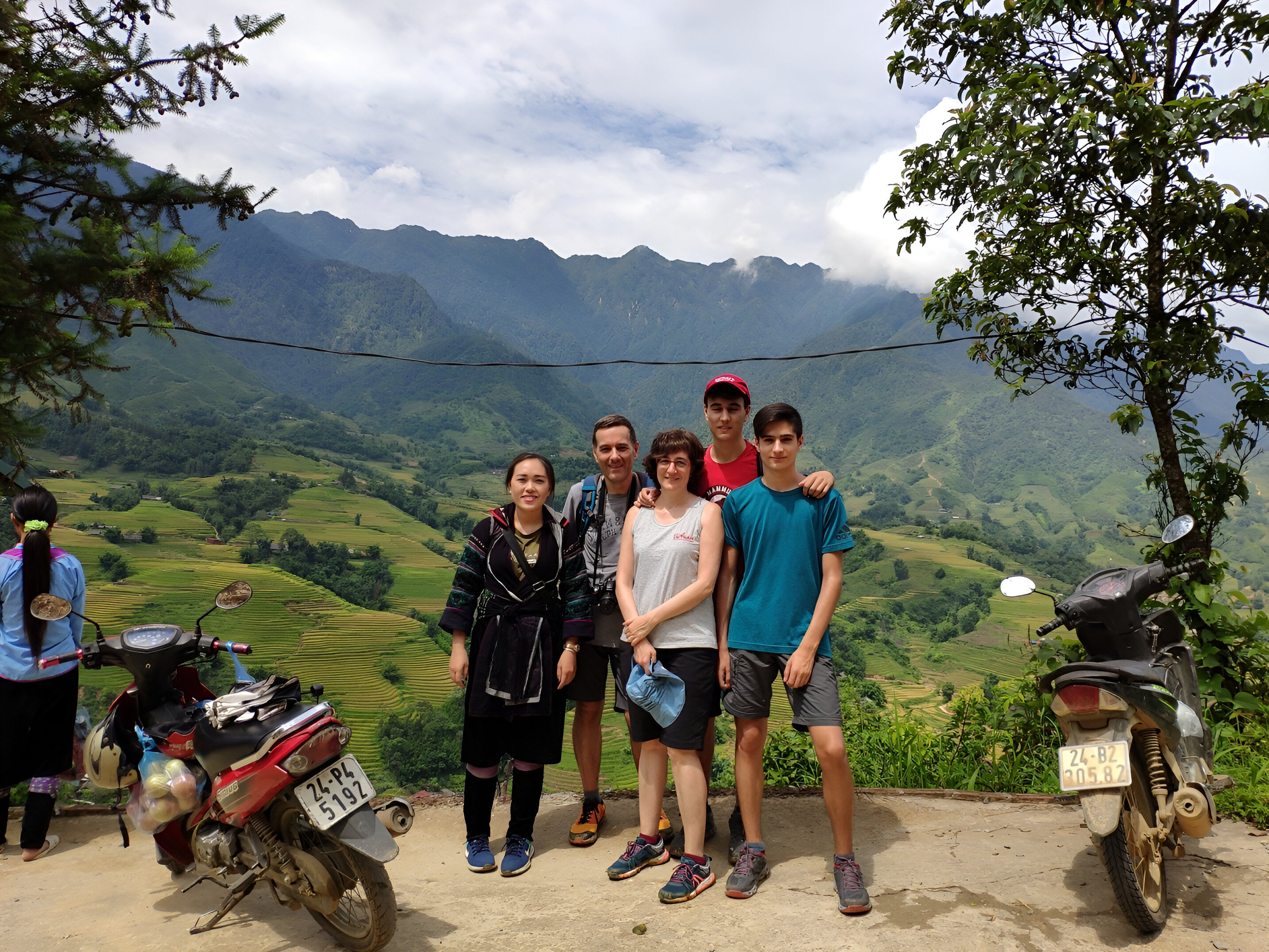
Sapa Useful Travel Information
How many days to stay.
Recommended days to stay in Sapa would be around three to Four days including time for some trekking, ride around the rice terraces on a motorbike, and visit local minority tribes and Hmong markets. Sapa’s variety of things to do offers unlimited activities depending on time of the visit and the things expected by you.
Currently exchange & ATM’s
Currency exchange goes through banks (remember to carry your passport), the easiest are USD and Euros. Your hotels and or small travel agents around the town would also accept to exchange your money into VND. There are around 5 ATM’s in the center of Sapa for withdrawing money in VND, the exchange rate on official rate and the withdraw rate is around 30-50K VND (1.5 to 2 USD). Check out Vietnam currency
Best Time to Visit Sapa Vietnam
The best time to visit Sapa would be the period from mid-March to June and also, September to mid-December that rewards visitors with pleasant weather, though a bit of lingering rain appears at the start, and temperatures dip by December.
Sapa weather experience the dry season from January to June. January and February rank as the coldest (and foggiest) months. From March to May, the weather often shines, and summer stays warm despite the rains from June to August, this is also a great time to visit Sapa and northern mountains.
From December to February, Sapa experiences very cold weather, especially at night. However, you get the chance to watch the sunrise over the valley in the morning. If you’re visiting during the winter months, remember to pack your woolies as temperature drops to below zero.
Check out The best times in the year to visit Vietnam
10 best things to do in Sapa Vietnam [2025 update]
In a beautiful valley close to the Chinese border – Sapa’s development was like nowhere else in Vietnam, with the advent of tourism, Sapa has experienced a renaissance. Bad roads have been upgraded to the good standard, countless new hotels & homestay have popped up and the food, including international menus, has improved immeasurably. Here are top things to do when in Sapa
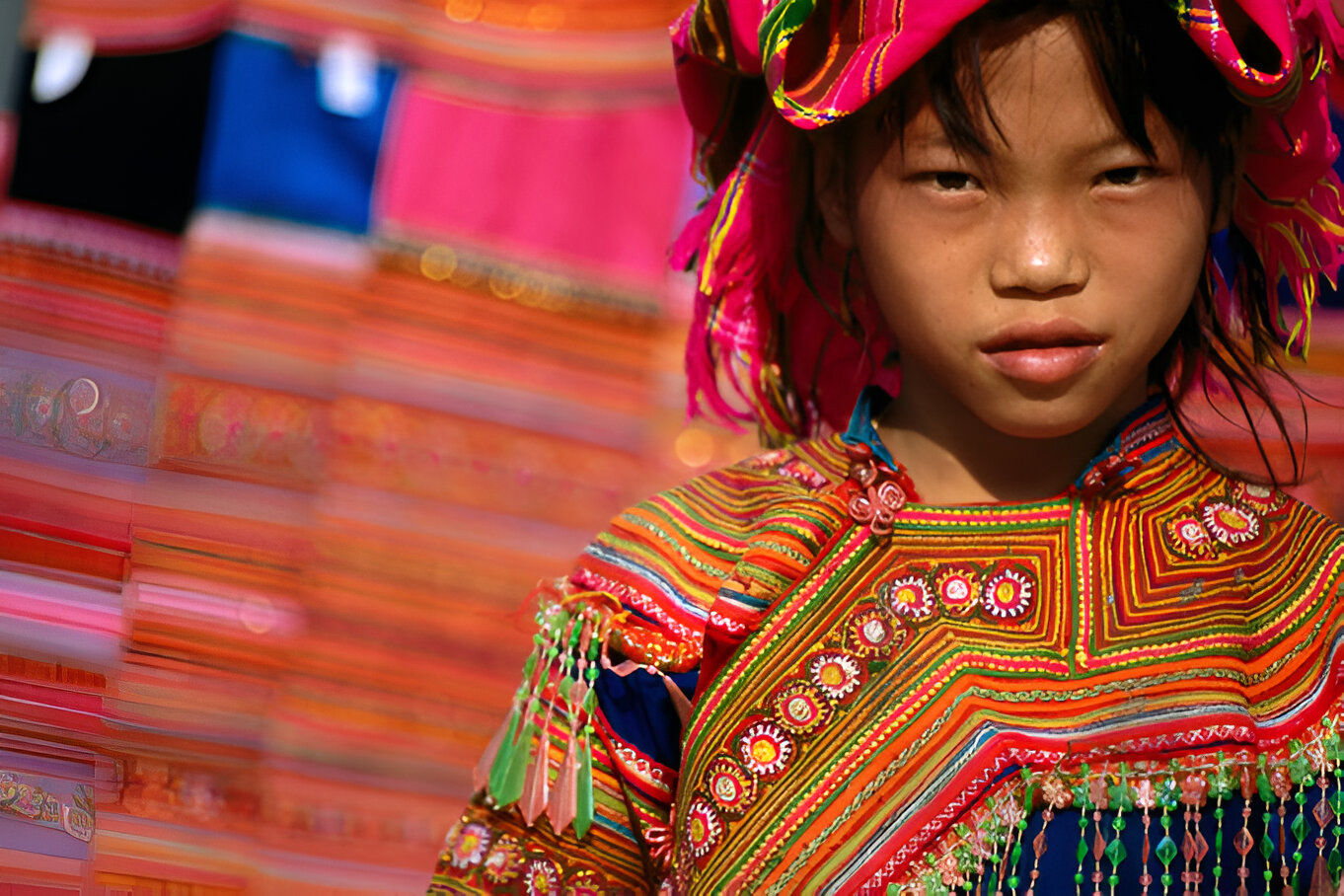
Trekking & Hiking
The best way to see & experience the region like a local is through trekking in Sapa . This adventure takes you through the lush mountains, across the Mường Hoa valley, through bamboo forests, and into local Hmong minority villages. Whether long or short, a trek stands out as one of the top things to do in Sapa , and you shouldn’t skip it while visiting Sapa, Vietnam.
We recommend a minority guide, or plan a head and book a full tour from Hanoi, Cat Cat is the nearest village 3km from Sapa, to start the hike.
Another popular trekking is to Ta Phin village , home to Red Dzao and about 10km from center of hike within the 14km loop through the area, passing by Black H’mong and Red Dzao villages.
For spectacular trekking with valley views, there’s a beautiful hike along a high ridge east of Sapa through the Black H’mong settlements of Sa Seng and Hang Da down to the Ta Van River.
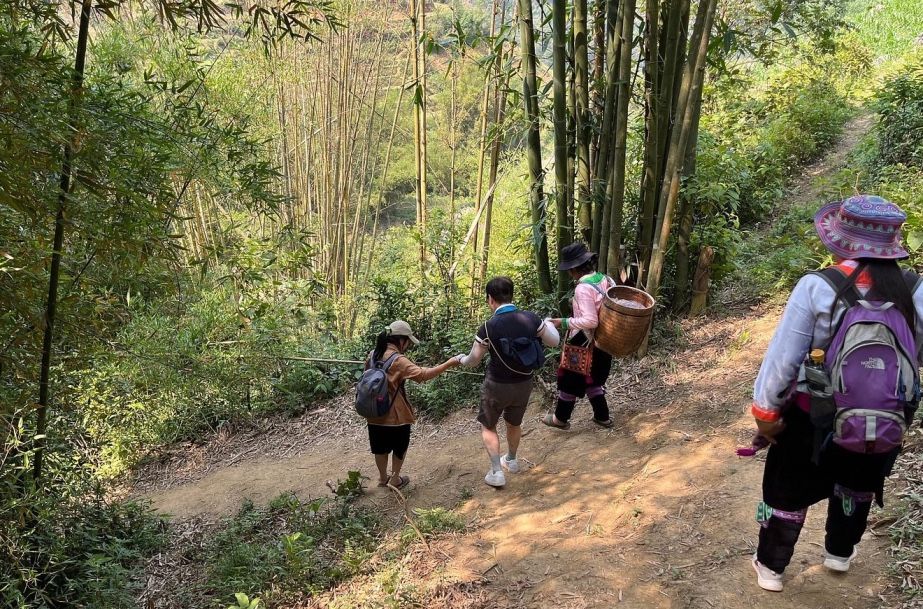
Explore terraced rice fields
Probably the main reason why so many tourist Visiting Sapa and around the terraced green hills by the Muong Hoa mountains. Set aside time to visit the rice terraces in Sapa Vietnam as one of the best things to do in the north. This is the Vietnam of your imagination: emerald green rows of terraced fields stretch as far as the eye can see, dotted with wooden houses and dusted with clouds.
Best rice fields in Sapa, and generally in Lao Cai province are in villages of Ta Phin, Y Ty, Ban Ho and Ta Van. check out Vietnam Famous Rice Fields
During summer and fall abundant rains can sometimes cloud views of the slopes. mid-September might be a more reliable period to see the golden rice fields, in this time, the landscape is golden and activity levels are high. June is when the fields are green & lush, so the landscape is golden and activity levels are high.
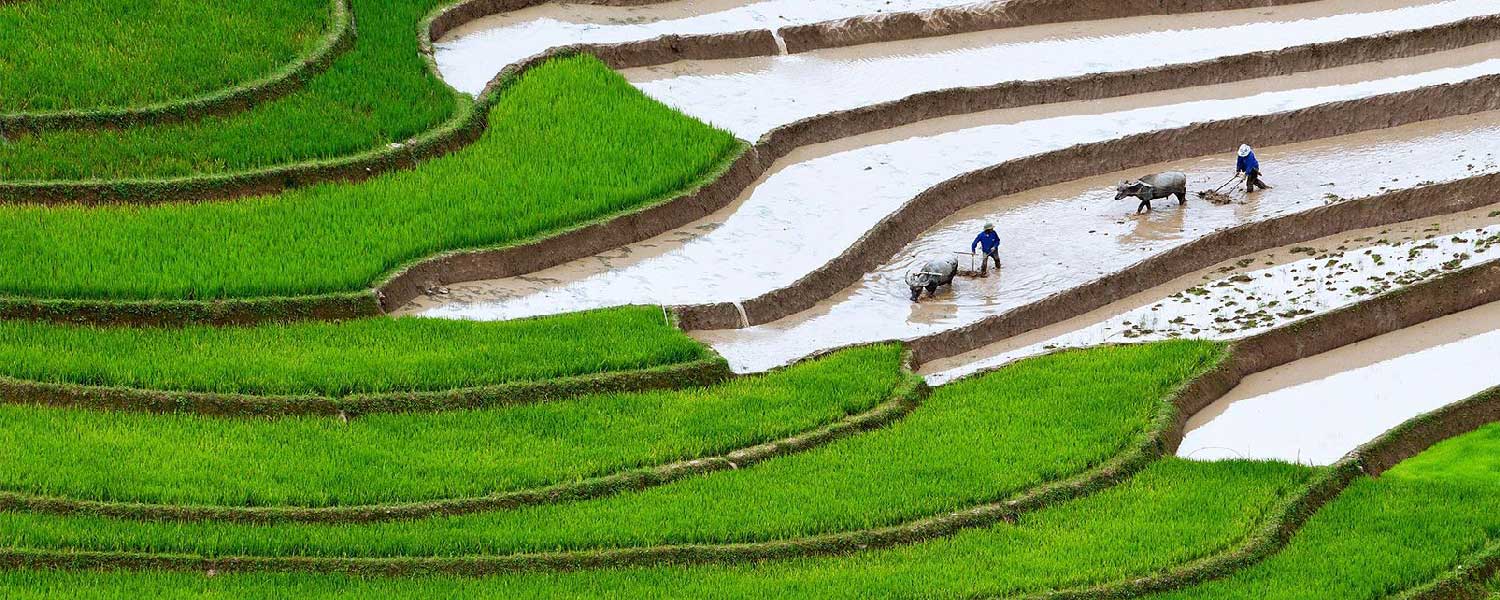
Visit hill tribes & minority villages
The mountain villages, hill tribes and ethnic minorities are another great reason to visit Sapa and the region would be of considerably less interest without the H’mong and Dzao tribal people, the largest ethnic groups in Sapa. The billowing red headdresses of the Red Dzao are visible all over town, a surreal sight amid the accelerating development.
The H’mong are more numerous and canny traders. Their villages may look medieval, but traditionally, they are all farmers and grow rice and keep buffaloes for trading. Most of the Montagnards have had little formal education and are illiterate, yet all the youngsters have a good command of English, French and a handful of other languages that enable them to become a de-facto guide leading tourists through the minority villages.
If possible, try to visit during the week, when Sapa is less crowded and more intimate. Crowds flock to Sapa for the Saturday market, but a smaller market is held every day. There is plenty to see on weekdays, and there are lots of interesting villages within walking distance of the centre.
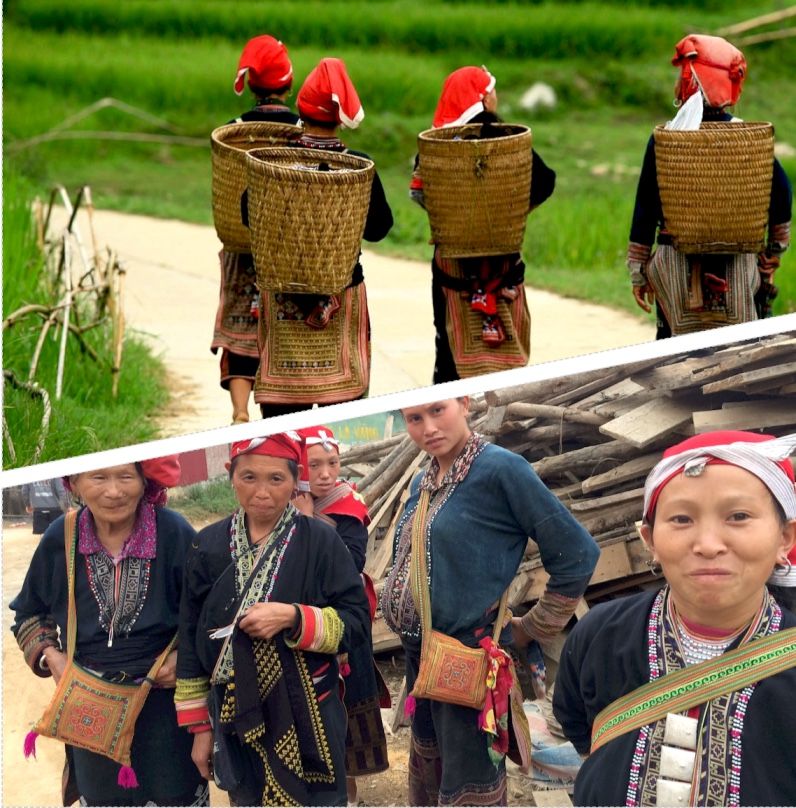
Homestay with local Hmong
Stay in a homestay to tik-up one of the best things to do while in Sapa. Homestays are just around anywhere in the town and most of them are run and manage by local minority people, however, I do recommend to choose to stay around the Sapa town in villages to get closer to the nature, hill tribe villages and next to the rice fields. The experience would be unique but very worthy.
Many homestay are cozy and small and they’re fully booked specially at the weekend, upon check in (which is mostly very flexible in time), the host family may ask you if you would prefer to eat dinner and lunch with them and if you do confirm, you will be eating a local made fresh foods. Th food might be simple, however, most homestay families learn to cook foods that cater to the taste of western travelers.
In addition, the off-the-beaten non-touristy things to do in Sapa mostly offers if you choose a homestay, trekking through the jungles, visit local houses and more.
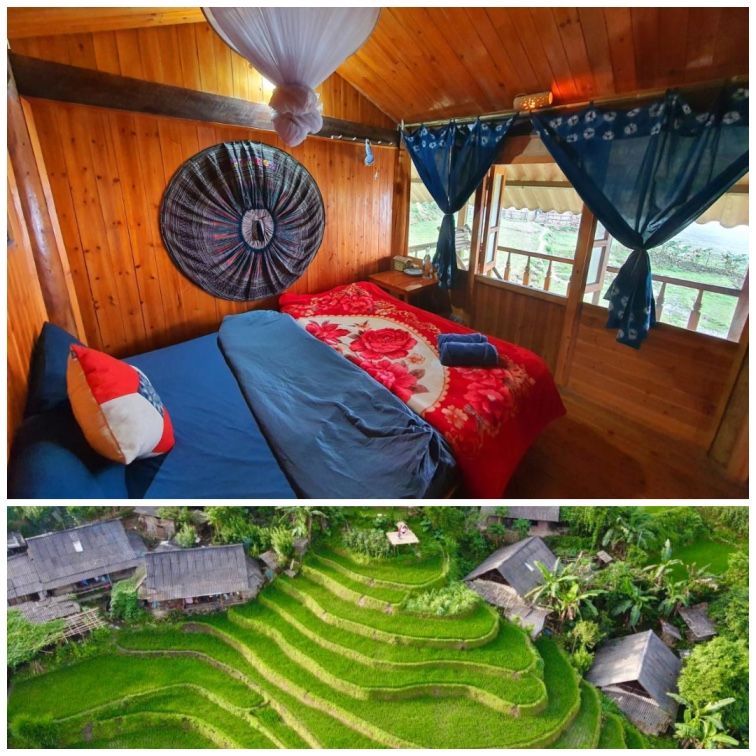
Visit Unique Hill Tribe Markets
Sapa’s colorful markets are on top list of best things to do when visiting Sapa. The mountain markets are about a lifestyle where hill-tribe minorities from surrounding villages go to the market most days to sell handicrafts and ethnic-style clothing. Saturday is the busiest day to visit markets in Sapa.
Bac Ha market is long touted as the weekend approaching, visitors flood in to meet the flower H’mong at the famous morning market. The market is a good base to explore the surrounding highlands as well. The colourful Flower H’mong are the most visible, but other groups include Dzao, Giay (Nhang), Han (Hoa), Xa Fang, La chi, Nung, Phula, Thai and Thulao are also present to the market to sell their local goods.
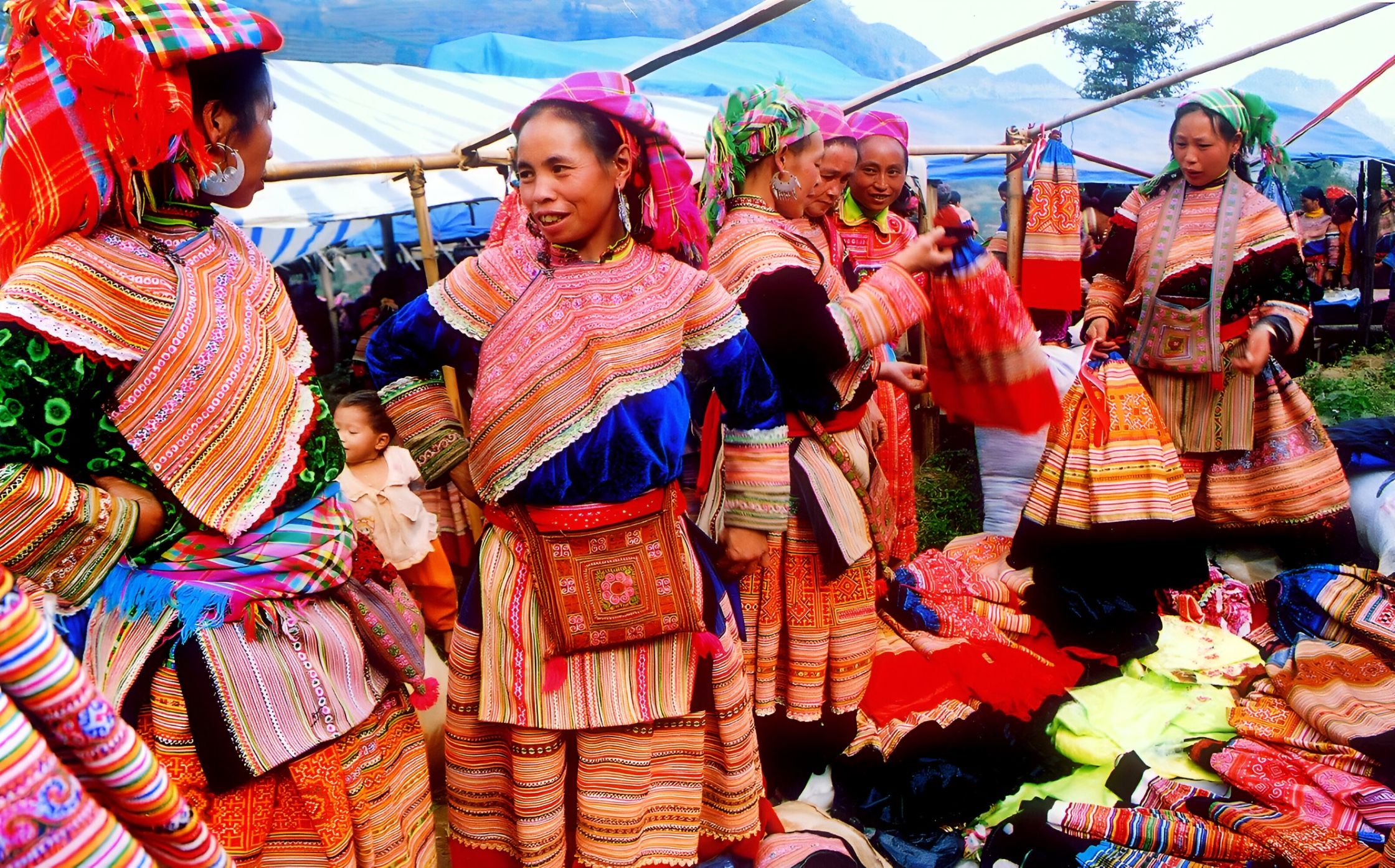
Private tours are the perfect choice to travel independently, groups of friends, or travellers with specific requirements. Plan your trip with our Best deal Vietnam Tours & Trips
Start Planning
Fansipan Mountain Peak by Cable Car
This the highest mountain in Vietnam , Fansipan serves as a major tourist highlight and a top things to do for anyone Visiting Sapa Vietnam. In the past, organizing a 2-3 treks with equipment was the only possible way to reach the peak. While this option remains available , today you can take a 6.5 KM cable car ride from the station in Sapa town crossing the Muong Hoa Valley to the summit of Fansipan in just 20 minutes.
Once you reach the peak, the view over the whole region including Sapa and surrounding mountain passes is beyond imagination. With few pagodas and temples, you may have more things to do once at the Fansipan summit.
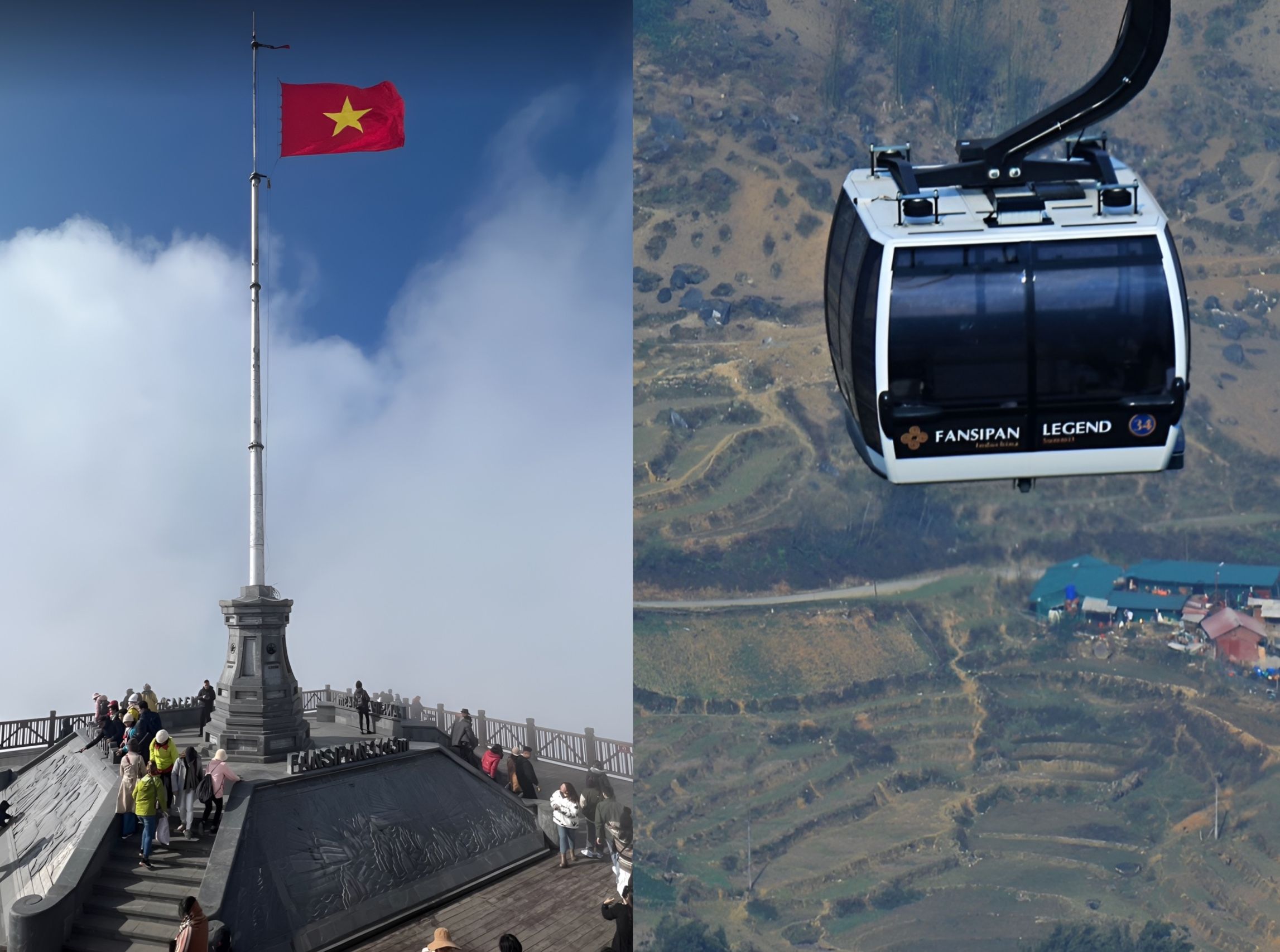
Trekking Mt. Fansipan Independently
Trekking Fansipan , the highest in Vietnam & Indochina – still in demand as it is accessible year round to sensibly equipped travelers in good shape, but don’t underestimate the challenge. It is very wet, and can be extremely slippery and generally bone feeling cold. Don’t attempt the hike and trek upward if the weather in Sapa is poor and cold, as limited visibility on Fansipan can be treacherous.
What is the difficulty level of Fansipan?
Fansipan’s difficulty and the actual trek ranks up to top level and it requires a moderate fitness level and preparation and a bit of hiking experience. The 21km hike to the summit can be reached only on foot, the terrain is rough and adverse weather is frequent. The round trip usually takes three days, however, some experienced hikers do it in two days, and you’ll need to be fit. After walking through hill-tribe villages on the first morning, it’s just forest, mountain vistas and occasional wildlife, including monkeys, mountain goats and birds.

Ride along O Quy Ho Pass (Đèo Ô Quý Hồ)
O Quy Ho Pass stretches along the Hoang Lien Son mountain, it is the longest pass in the Northwestern region on the 4D national highway from Lao Chai to Sapa, the beautiful mountain pass ranks as one of the four most beautiful yet most hazardous mountain passes in Vietnam at an altitude of 2,035 meters. Locally known as the Gate of Heaven as it is covered with clouds. Many motorbike riders choose to cross O Quy Ho pass to experience the magical overview. Check out Vietnam motorbike Tours
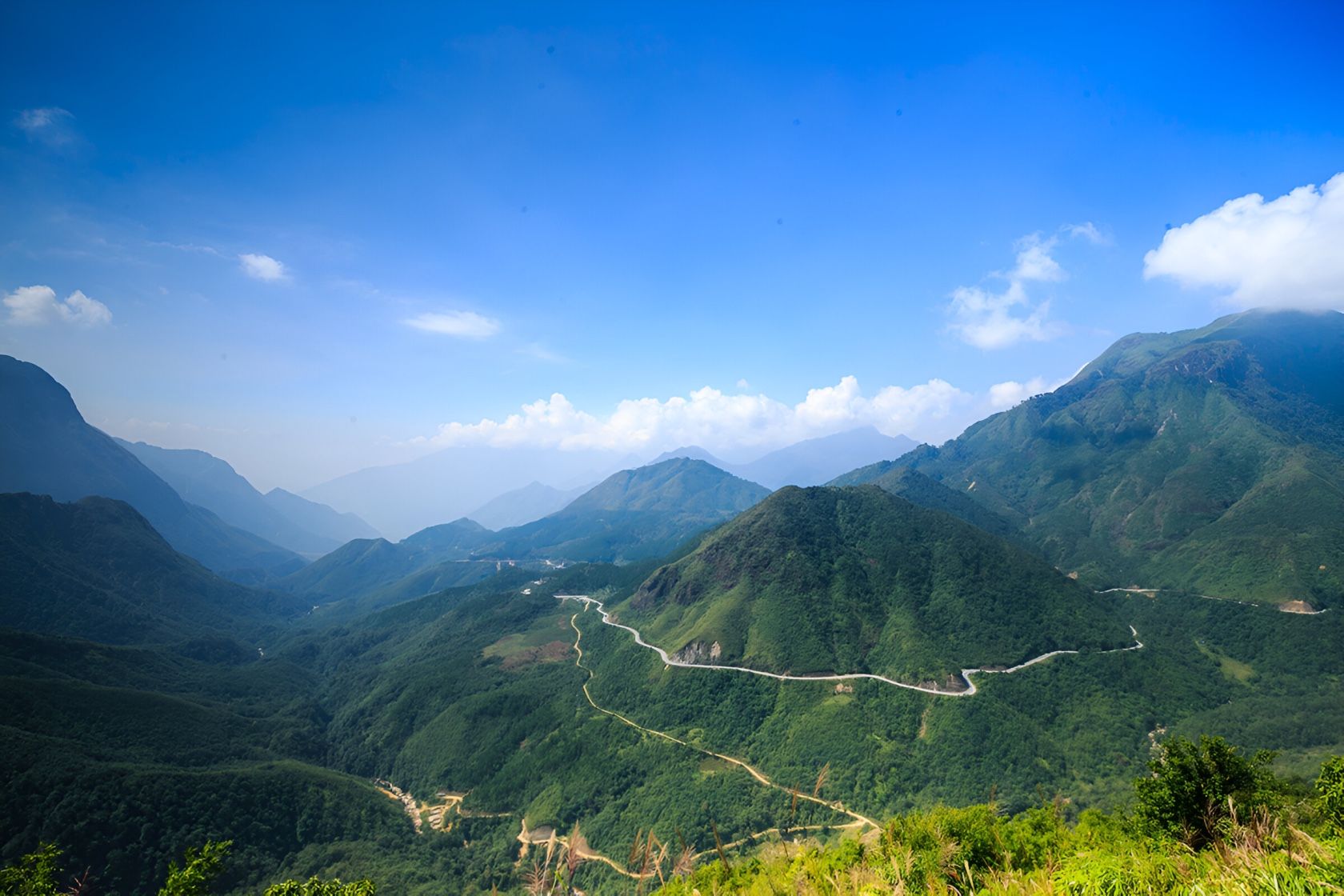
Silver Waterfall & Love Waterfall
A scenic motorbike ride toward Tram Ton Pass, from Sapa city center to the Glass Bridge outside the town reveals more attractions beyond the stunning scenery of Ô Quy Hồ Pass. Along the way, discover two famous waterfalls in Sapa : Silver Waterfall and Love Waterfall . You can catch a glimpse of Silver Waterfall from the road, but a small fee of 20,000 VND lets you get up close for a better view.
Another attractive yet less touristy waterfall is the Love Waterfall which is also near the Sapa city center. To get there, you’ll need a 45 minutes hike up through the lush forest.
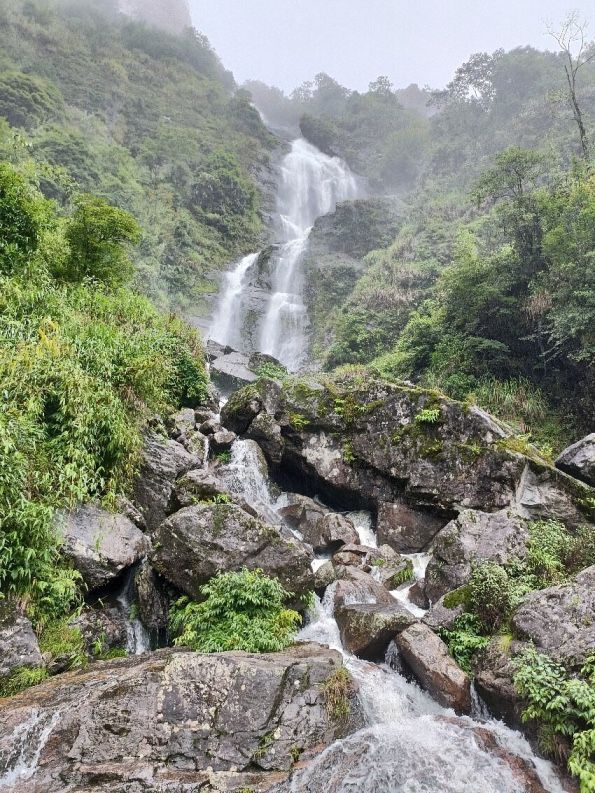
Wander around the center of Sapa
Even if the nicest things to do in Sapa are required to drive outside the town or go for trekking, you are still free to explore the center of Sapa for few good things to see. Sapa’s attraction including the local market and the historic Sapa Stone Church . that has long been considered as a symbol of Sapa tourism area. The whole church was built by stone (walls, floors, bell towers, etc.) that are linked by a mixture of sand, lime and molasses.
Weekdays are a good time to visit the markets, in addition, you can also visit a museum that features exhibits on various ethnic communities in the region. Lastly, you can take a stroll around the lake or visit Ham Rong Mountain to see the cityscape. The center of Sapa is home to a variety of tourist shops, pubs, restaurants, and street food vendors.
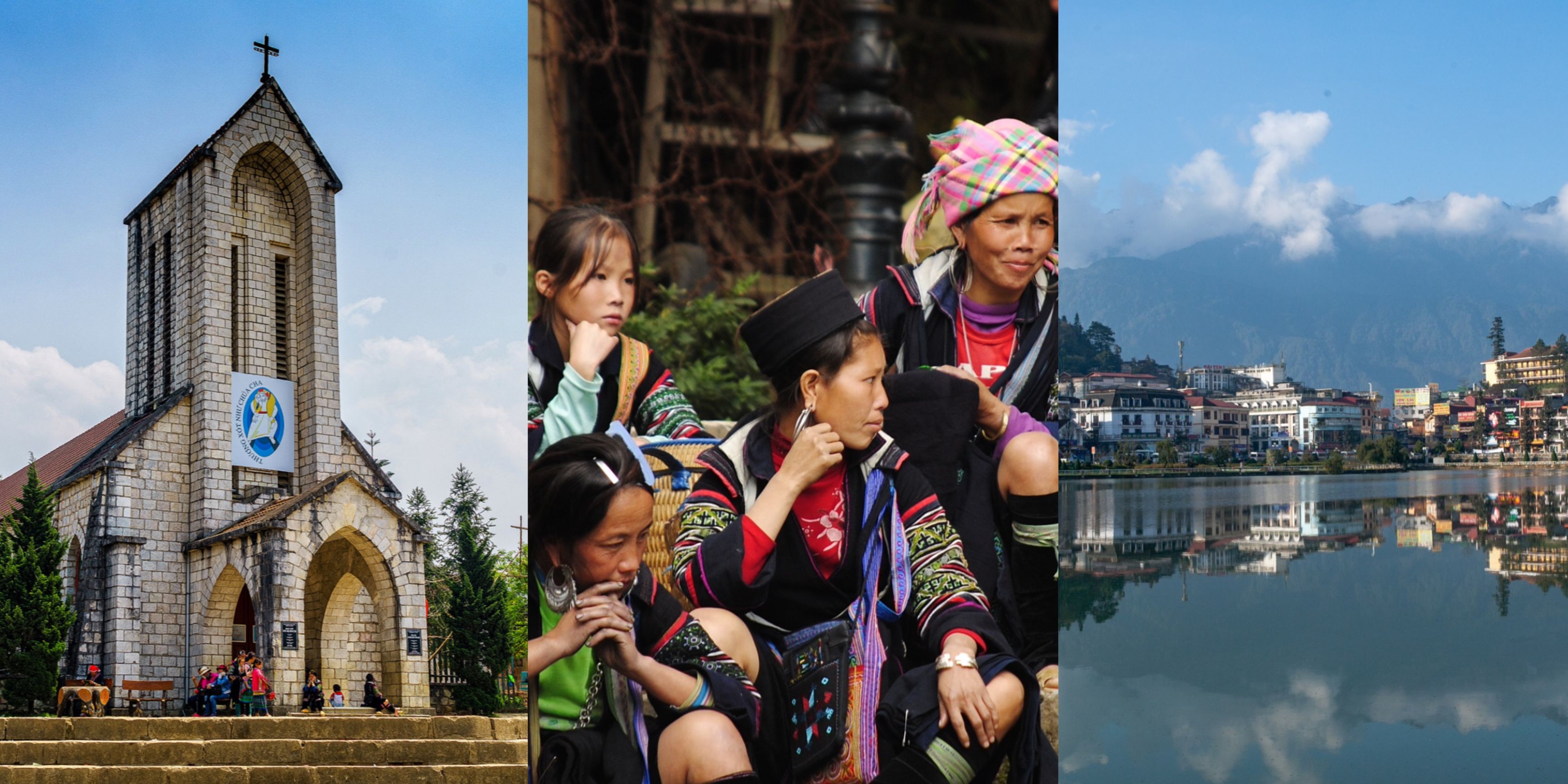
Sapa by motorbike
For any reason, if hiking or trekking in Sapa’s majestic landscape isn’t your thing, but if you’re looking for an alternative to visit them altogether, you’ll still have a great choice and that would be “Sapa by motorbike”.
Sapa Vietnam offers great landscapes and motorbike tours are the best ways to explore them. Sapa attracts many Vietnamese & foreign motorbike riders all year round.
Rent a motorbike is the best way to do some looping and visit mountain passes, rice fields and local hamlets. once in Sapa, rent a motorbike & spend a couple of days exploring the Sapa with motorbike on the Sapa-Sin Ho Scenic Loop; you’ll enjoy some of the grandest alpine scenery in Southeast Asia and if you have more time, combine it with a famous Ha Giang Loop all on a motorbike.
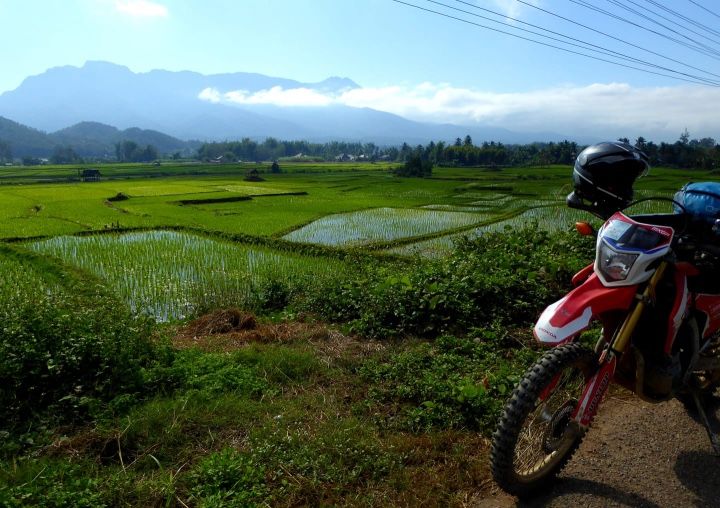
Where to stay in Sapa, Vietnam
Since tourism is booming following by tourist services – hotels, hostels & homestays are the first things anyone is looking for. There are many options to choose from ranging from budget to luxury, and from hostels to homestays. Sapa center is now occupied with luxury hotels, this provides a better choice for those seeking to stay around the center where they can walk to the nearby places, restaurants & the local night markets held every evening.
Hotels in the Center of Sapa
Many accommodation ranging from simple 3 stars to the top luxury 5 stars are now erected in and around the center of Sapa (Where stone church is located). Staying in the center of Sapa will be beneficial and gives you an easy access to numerous restaurants, shops, and attractions.
Staying in center of Sapa : Very touristy, busy area & not recommended if you’re looking for an authentic experience – HOWEVER, within walking distance, you’ll find Ham Rong Mountain and the train station to board the cable car to Fansipan and a lot more.
Homestays around Sapa [in the villages]
Homestays in Sapa are one of the best ways to get to know the local culture while staying in the lap of nature and away from the touristy side of Sapa. There are a handful of home-stays run by locals just within 5-10km from the center of town and they all offer a simple yet genuine experience.
Sapa’s ethnic population and terraced rice fields are what really make it charming and to experience this, many visitors are now prefer to book a homestay instead of staying in one of the luxury hotels in the Sapa town.
Most villages provide homestays from basic bed and shower to the more facilitate and modern ones equipped with Air condition, hot shower and a great view.
Accommodation on Muong Hoa – Cat Cat & Ta Van
Muong Hoa Valley along with Ta Van & Cat Cat village are also a great place to stay since offers breathtaking views of the mountains and terraced rice fields as it travels deep into Muong Hoa Valley from Sapa. The accommodation options along this areas offer nothing but an amazing views. You have the option of staying in a more tranquil farther out or closer to Sapa town.
The accommodation options along Ta Van & Cat Cat including simple hotels and few home-stays, remember to book them in advance.
Sapa: Food & Drinks
In Sapa, you’ll find a variety of places to eat, from small eateries to the bigger neon flashed Chinese style restaurant at the center of the town. There are plenty of options when it comes to what to eat in Sapa, however, try the local foods made by hill-tribe minorities, they are often comes with a bowl of rice, veggies, mountain herbs and fishes.
In addition to local foods, Sala offers plenty of places to eat western foods, try bigger hotels as well as restaurants in the town, they offer anything from Pizza, Pasta and English breakfast.
Street foods
Once in Sapa, from the center and where the stone church is located, walk toward Cau May Road and near the entrance to the viewing point, you’ll find several street food stalls offering a great selection of finger foods.
Try the Sapa spring rolls, fresh, grilled and filled with veggies. You can also spot other snacks like sticky rice wrapped in banana leaves or in bamboo tube, little rice cakes, and a variety of Vietnamese fruit . You can also follow locals, sit in the small plastic chair, order anything from chicken BBQ to rice and noodles and eat it right in the street. If you’re in Sapa, you should give a street food a good try.
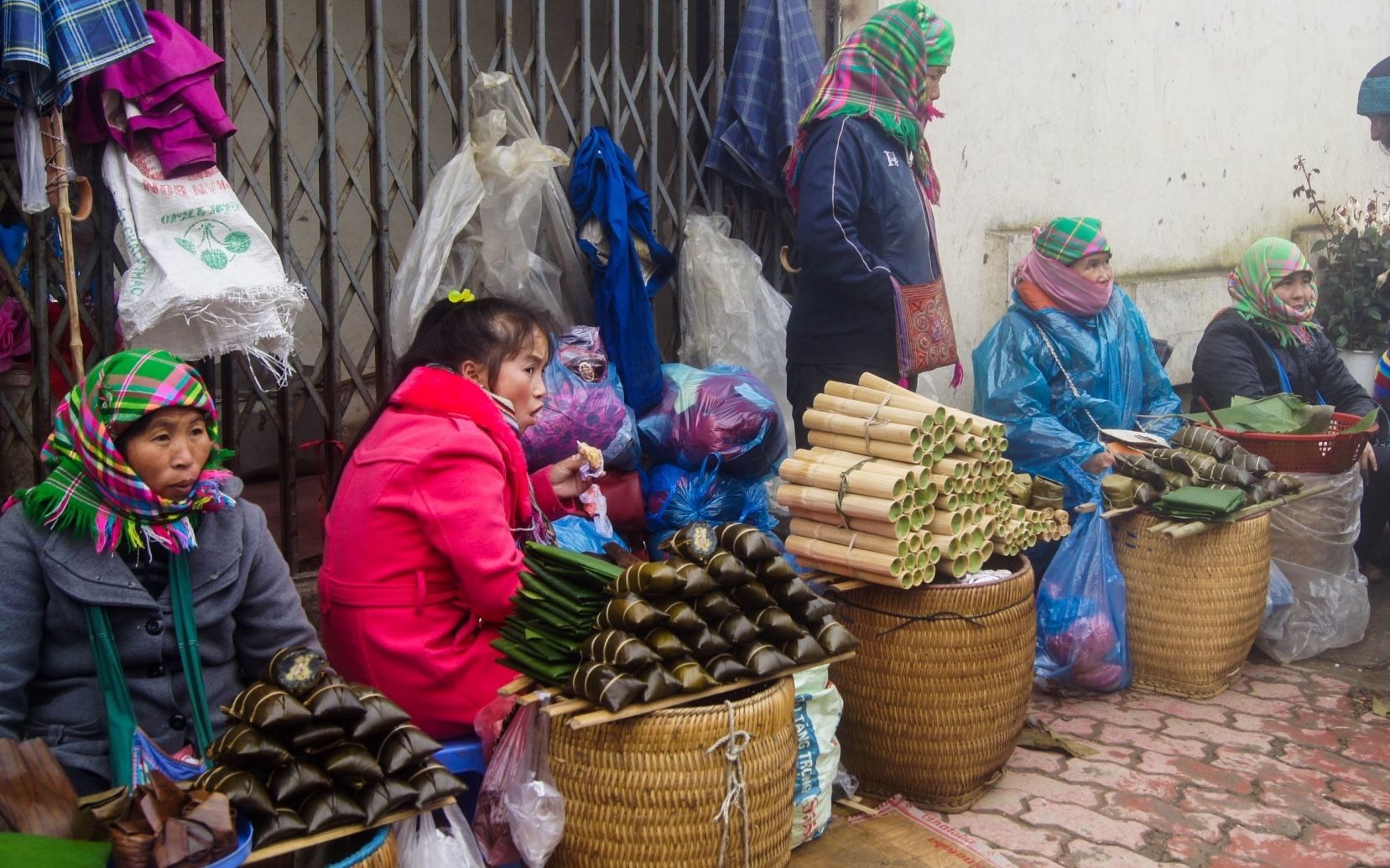
Another great thing about Sapa is the abundance of small cafes where you can enjoy ca phe sua da (Vietnamese coffee with condensed milk). You won’t struggle to find a nice spot to sit down, rest your feet, and enjoy a refreshing drink.
At night, you can discover local bars in Sapa with pool tables and foosball at the bottom of Cau May Road. If you need a late-night beer, you’ll find one or two places, but most will close by 11 PM. Many local eateries offer rice-wine and other local wines, upon request.
Forget about disco and bar and late night dancing when while Visiting Sapa, It’s true that the small town is not familiar with modern nightlife, however, with the growing tourism and probably a demands, there are few Karaoke places, bars to get few beers and cocktails and a number of massage parlors around the center of Sapa.
Check out Massage in Vietnam Sapa
How to Get to Sapa Vietnam
Sapa does NOT have an airpot and the closet international airport is Noi Bai International Airport (HAN), in Hanoi. How to travel to Sapa by overnight train, bus, VIP van or car . There are several options for anyone with any budget and traveling style in mind.
The distance from Hanoi to Sapa is 319 kilometres (200 miles). Here are the few best ways to get you to Sapa from Hanoi in 2025
Trains to Sapa
The 8 hours train journey from Hanoi to Lao Cai (the nearest train station, 35 km to Sapa), plus an additional 1 hour bus / car travel to the center of Sapa town. The most popular mods of transportation is to take an overnight sleeper train from Hanoi to Sapa. The train has benefits and drawbacks. Overall, it’s a dependable and safe mode of transportation and a very affordable way to travel.
Several trains run from Hanoi to Sapa every night, plus a few hat depart in day time – all operated by state-run Vietnam Railways. Each train features standard Vietnam Railways carriages and some more luxurious ones from private companies. The cheapest tickets are for the regular carriages on the Sapa Reunification Express .
Hanoi to Sapa by bus
Several buses travel from Hanoi to Sapa during the day and you can book them either online or simply ask your hotel guy and that is included a free pick up from your hotel. The bus journey from Hanoi to Sapa takes around 6 hours and actually many travelers and backpackers would prefer the overnight sleeper bus.
The buses travel through CT05, the Hanoi- Lao Cai express way, and generally the bus drivers are experienced enough and they ride with limited speed, so the bus travel feels safe and accommodations.
Hanoi to Sapa limousine van
The limousine van is probably the fastest and the most comfortable way to get yourself to Sapa in less than 5 hours. The Van limousine services are run pretty much anytime from 6Am through 3PM and the tickets are around 500k-600k and it is included a free water and a snack. The minivans are featuring comfortable seat, USB charging ports, WIFI and in Hanoi, they usually pick passenger up at Hanoi’s old quarter.
Itinerary: Explore Best Of Sapa & Around In 2 Days
Sapa Town, Cat Cat/Ta Phin Village, Silver Waterfall, Love Waterfall, Stone Church
Spend the day exploring Sapa. Start with sunrise views and a visit to Sapa market around 6 a.m. Enjoy breakfast at your hotel from 7 to 8 a.m., then take a private car to Cat Cat/Ta Phin village. Explore the villages from 8 a.m. to noon, then have lunch at local restaurants.
In the afternoon, head to Silver Waterfall and Love Waterfall. Enjoy the beautiful scenery overlooking the whole region, then return to Sapa town. Take an hour to relax and shop before dinner at Do Quyen restaurant from 7 to 9 p.m. Afterward, enjoy coffee or visit the stone church.
Day 2: Mount Fansipan, O Quy Ho, Ham Rong Mountain
On the second day, enjoy the Mt. Fansipan, the highest in Vietnam and Indochina. Leave Hotel at 8 a.m. for the cable car. Spend the morning enjoying the views from the mountain until noon. Have lunch at a local restaurant.
Next, visit O Quy Ho and Ham Rong Mountain, which are close together, making it easy to explore both in the afternoon. These stunning locations offer fantastic photo opportunities.
This was an itinerary suggestion for 2 days Visiting Sapa and around. With the tourism industry evolving rapidly, don’t miss the chance to experience Sapa.
FAQ → Tips for traveling in Sapa, Vietnam
Is sapa really worth visiting.
Is is worth going to Sapa? Absolutely, The alpine character, home to some of the best rice fields, easy hikes & great mountain passes along with the local tribal people are only few of the best things to drag you to plan a trip to Sapa. For the best and an impactful travel experiences, plan it correct and based on your expectations. Book a tour from Hanoi, or experience the whole region on a motorbike. Also, train travel is much more comfortable.
How many days in Sapa is enough?
If you’re traveling to Sapa for the first time, a stay of 2-3 days is most recommended. If you’re interested in off-the-beaten track, Sapa and surrounded mountains would be the ideal start, basically 4-6 days will do if you’re heading from Sapa to villages and travel with motorbike along the area. It’s always a good idea to check current travel conditions and weather forecasts before planning for Sapa.
What is special about Sapa?
Sapa is definitely a special place to visit & more travellers are booking to stay in for the climate, rice terraces, waterfalls, majestic mountains, top peaks and hiking trails. The climate (cold in winter) and to visit the hill tribes (mostly Hmong, Dao and Kinh people) who call Sapa a home. The Saturday market is the best place to buy handicrafts.
Just 9km (5.5mi) from Sapa is Fansipan (3143m/10,309ft), which is Indochina’s highest peak. A hike to the top and back takes about four days, Cable car made it easy to visit at anytime.
Can you do Sapa without a tour?
You can do Sapa by yourself, however, to trek in Sapa without a guide, some travelers may find it challenging due to the lack of trail markers or signs. Many of the best trekking routes lead through terraced rice fields owned by local farmers, making it beneficial to have a local companion who can share insights and ensure you don’t get lost. Exploring with a guide also allowing you to understand the local tribal culture and traditions, so, overall, Sapa with a tour would be more beneficial.
Visiting Sapa with kids
Things to do in Sapa with kids – Most families visit Sapa to go trekking, which offers a fantastic way to explore local villages and the countryside just outside the center of Sapa town. If you have a few days, consider a motorbike tour to Love Waterfall and an amazing view points on O Quy Ho mountain pass. Don’t miss the cable car ride and the trek to the summit of Fansipan (3,147 meters). These activities provide thrilling adventures for kids and create lasting memories for the whole family.
- Tripadvisor
Speak to a Vietnam Trip Advisor to create your next dream holiday.
Copyright 2013-2017 Vietnamese Private Tours Ltd With Vietnam Luxury Travel
Deals of the Week Irresistible Asia Up to 50% OFF
Self Driving in Northern Vietnam 12 Days
- Hiking & Trekking
- Self-Guided
- Personalized
- Christmas & New Year

- Explore Hanoi's vibrant city center
- Drive through Bac Son's golden rice fields
- Visit Ban Gioc waterfall and local villages
- Cruise through Halong Bay's limestone islands
- Shop at ethnic markets in Bac Ha
- Introduction
- Day 1 ARRIVE IN HANOI (D) – BY BUS
- Day 2 HANOI – BAC SON – QUANG UYEN (B, D)
- Day 3 QUANG UYEN – BAN GIOC (B, D)
- Day 4 BAN GIOC – CAO BANG (B, D)
- Day 5 CAO BANG – MEO VAC (B, D)
- Day 6 MEO VAC – HA GIANG (B, D)
- Day 7 HA GIANG – BAC HA (B, D)
- Day 8 BAC HA – LAO CAI (B, D)
- Day 9 LAO CAI – HA NOI (B, D)
- Day 10 HA NOI – HALONG (B, L, D) – BY BUS
- Day 11 HA LONG - HANOI (B, Brunch D) – BY BUS
- Day 12 HA NOI - DEPARTURE(B)
Want to read it later?
Download this tour’s PDF brochure and start tour planning offline
What's Included
- Accommodation
- Additional Services
Where You'll Stay
Ha Noi Tokyo
Sai Gon - Ban Gioc
Sunny Cao Bang
Hoa Cuong - Meo Vac
Phoenix Ha Giang
Grand Muong Thanh - Lao Cai
La Regina Legend Cruise
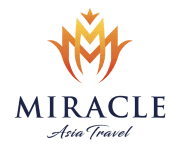
Operated by
Miracle Asia Travel
Number of tours
1 to 99 years old
Response time
less than 1 hour
Response rate
We are team of experience with passionate in enjoying and delivering authentic travel experience to people around the world. Specialized in Vietnam & Cambodia, Miracle Asia is more than happy to design unique travel experience. From small group to luxury travel ones that we have provided....
Your Peace of Mind Options
Cancellation policy.
A transparent overview of applicable fees.
Dates & Availability
Why book with tourradar.
- Flexible payment options
- Trusted and vetted operators
- Rated excellent on
- Best price guarantee
- 24/7 customer support
- Earn €50 in travel credits
To protect your payment and ensure your booking will be processed in Austria, never transfer or communicate outside of the TourRadar website or app.
- Upcoming departures
- October 2024
- November 2024
- December 2024
- January 2025
- February 2025
- Get Instant Confirmation Saturday 5 Oct, 2024 Wednesday 16 Oct, 2024 Multiple Room Types €3,497 Confirm Dates
- Get Instant Confirmation Saturday 12 Oct, 2024 Wednesday 23 Oct, 2024 Multiple Room Types €3,497 Confirm Dates
- Get Instant Confirmation Saturday 19 Oct, 2024 Wednesday 30 Oct, 2024 Multiple Room Types €3,497 Confirm Dates
- Get Instant Confirmation Saturday 26 Oct, 2024 Wednesday 6 Nov, 2024 Multiple Room Types €3,497 Confirm Dates
- Get Instant Confirmation Saturday 2 Nov, 2024 Wednesday 13 Nov, 2024 Multiple Room Types €3,497 Confirm Dates
- Get Instant Confirmation Saturday 9 Nov, 2024 Wednesday 20 Nov, 2024 Multiple Room Types €3,497 Confirm Dates
- Get Instant Confirmation Saturday 16 Nov, 2024 Wednesday 27 Nov, 2024 Multiple Room Types €3,497 Confirm Dates
- Get Instant Confirmation Saturday 23 Nov, 2024 Wednesday 4 Dec, 2024 Multiple Room Types €3,497 Confirm Dates
- Get Instant Confirmation Saturday 30 Nov, 2024 Wednesday 11 Dec, 2024 Multiple Room Types €3,497 Confirm Dates
- Get Instant Confirmation Saturday 7 Dec, 2024 Wednesday 18 Dec, 2024 Multiple Room Types €3,497 Confirm Dates
Good to Know
- Currency ₫ Dong Vietnam
As a traveller from USA, Canada you will need an adaptor for types C, E, F, G. As a traveller from England you will need an adaptor for types A, B, C, E, F. As a traveller from Australia, New Zealand, South Africa you will need an adaptor for types A, B, C, E, F, G.
- These are only indications, so please visit your doctor before you travel to be 100% sure.
- Typhoid - Recommended for Vietnam. Ideally 2 weeks before travel.
- Hepatitis A - Recommended for Vietnam. Ideally 2 weeks before travel.
- Cholera - Recommended for Vietnam. Ideally 2 weeks before travel.
- Tuberculosis - Recommended for Vietnam. Ideally 3 months before travel.
- Hepatitis B - Recommended for Vietnam. Ideally 2 months before travel.
- Rabies - Recommended for Vietnam. Ideally 1 month before travel.
- Yellow fever - Certificate of vaccination required if arriving from an area with a risk of yellow fever transmission for Vietnam. Ideally 10 days before travel.
- Japanese B encephalitis - Recommended for Vietnam. Ideally 1 month before travel.
- Unfortunately we cannot offer you a visa application service. Whether you need a visa or not depends on your nationality and where you wish to travel. Assuming your home country does not have a visa agreement with the country you're planning to visit, you will need to apply for a visa in advance of your scheduled departure.
- Here is an indication for which countries you might need a visa. Please contact the local embassy for help applying for visas to these places.
- For any tour departing before 23rd November 2024 a full payment is necessary. For tours departing after 23rd November 2024, a minimum payment of 20% is required to confirm your booking with Miracle Asia Travel. The final payment will be automatically charged to your credit card on the designated due date. The final payment of the remaining balance is required at least 60 days prior to the departure date of your tour. TourRadar never charges you a booking fee and will charge you in the stated currency.
- Some departure dates and prices may vary and Miracle Asia Travel will contact you with any discrepancies before your booking is confirmed.
- The following cards are accepted for "Miracle Asia Travel" tours: Visa, Maestro, Mastercard, American Express or PayPal. TourRadar does NOT charge you an extra fee for using any of these payment methods.
- Your money is safe with TourRadar, as we only pay the tour operator after your tour has departed.
- TourRadar is an authorised Agent of Miracle Asia Travel. Please familiarise yourself with the Miracle Asia Travel payment, cancellation and refund conditions .
- Insurance Unless otherwise mentioned, TourRadar does not provide travel insurance. We do however recommend purchasing it through our tried and trusted partner, World Travel Nomads .
- Accessibility Some tours are not suitable for mobility-restricted traveller, however, some operators may be able to accommodate special requests. For any enquiries, you can contact our customer support team , who are ready and waiting to help you.
- Egypt Tours
- Alaska Vacation Packages
- New Zealand Tours
- Grand Canyon Vacation Packages
- Spain Tours
- Croatia Sailing Tours
- Arctic Odyssey - From Norway to Svalbard
Similar Tours

Keep Exploring Vietnam
- Vietnam Travel Guide | All You Need to Know
- 10 Best Hiking & Trekking Companies
- Your Guide to Planning a Private Hike 2024/2025
- Best Hiking Tours in The World 2024/2025
- Vietnam from Hanoi
- Vietnam Hiking & Trekking
- Small group tour
- 12 days Vietnam
- Operators in Asia
- Northeast Vietnam
- Self Driving in Northern Vietnam 12 Days Tours in Vietnam
- Hiking & Trekking Tours
- Northeast Vietnam Tours
- Vietnam Tours
- Self-Guided Tours
- Private Tours
- Personalized Tours
- Christmas & New Year Tours
- Northern Vietnam
- Vietnam tours

COMMENTS
Learn everything you need to know about travel to Vietnam in this comprehensive guide. Discover the best things to do, places to visit, tips and advice for your trip to this amazing country.
Explore Vietnam's natural beauty, cultural diversity and dynamic cities with Lonely Planet's expert tips and advice. Find the best time, places and attractions to visit, as well as articles, road trips and activities for your trip.
Learn how to plan your trip to Vietnam with this comprehensive guide by Nomadic Matt, a travel blogger and expert. Find out the best places to see, things to do, costs, budget, safety, and more.
10. Ha Giang. Best for mountain views. Trekking to the minority villages in the hills around Sapa is one of Vietnam's top draws, but the country's trekking capital feels rather commercialized these days. Hikers have to walk further every year to find the rural idyll that first drew people to the northwest.
Vietnam has three major airlines, namely Vietnam Airlines, Vietjet Air, and Bamboo Airways, providing extensive coverage to numerous domestic airports across the country, totaling around 21 airports. 2. Bus travel. Bus travel in Vietnam is a popular and extensive mode of transportation, with a network that connects every corner of the country.
In North Vietnam (Hanoi, Sapa, Ha Giang, Halong Bay) in September and November or March and April, the weather is cool and dry and the local tourism sector is not overwhelmed by intra-Vietnamese travel. August and September are also Sapa's harvest season and the best time to highland hills in vibrant bloom. Central Vietnam (Hoi An, Nha Trang ...
Costs of Traveling in Vietnam. Travel on a budget in Vietnam, from $110 − $240 USD weekly per person, mid-range $280 − $830 USD, and high-end from $750 − $1250 USD. However, costs depend on factors like accommodation, transportation, and activities. We did not include flights. Check flight prices here.
Take a boat trip through the limestone tunnels and between karst hills to the three long, tunnel caves at Tam Cocitself. 4. Hue. Travel to the engaging city of Hue and take a day-long boat trip along the Perfume River to visit the Thien Mu Pagoda and Hon Chen Temple, the Imperial City, and the Tu Duc mausoleum.
Best time to visit Vietnam. The climate in Vietnam varies from north to south, allowing you the flexibility to choose the best time for your visit, depending on where you're planning to travel in Vietnam.. North Vietnam: In the northern regions, including the bustling capital Hanoi, summers are hot and humid, while winters bring a cooler, drier atmosphere.
Step 2: Open the official website for Vietnam's e-Visa Application. Step 3: Upload your .jpg images (passport data page and passport photo) and fill out the required fields on the form. Step 4: Pay the e-Visa fee of US$ 25 for single entry visa or US$50 for multiple entry visa using any of the payment methods offered.
The Perfect 2-Week Vietnam Itinerary. Our Vietnam travel itinerary will show you how to tackle this amazing country, ensuring that you see the best places to visit in Vietnam. The itinerary begins in the country's north with Hanoi and works its way south to Ho Chi Minh City, but the reverse works just as well.
Looking for an in-depth Vietnam travel guide?. Then you're in the right place! Thanks to its stunning natural beauty in places Ha Long Bay and the Mekong Delta, bustling cities with incredible street food, and fascinating culture and history, Vietnam is an unmissable destination in Southeast Asia.. It's also extremely affordable, and visitors will find that their money stretches far in ...
From the jagged peaks of Ha Giang to the backwaters of the Mekong Delta, the one thing Vietnam isn't lacking is variety. Join the crush inside the canary yellow walls of Hoi An's UNESCO Ancient Town, chase dragons in Hue, then find room to breathe in one of rural Northern Vietnam's hidden oases. Between the velvety rice terraces of Sapa ...
Series: Rough Guides Main Series. Publication Date: 1/1/2023. Pages: 504. Dimensions: 129 x 198. $ 25.99. to cart. Discover the post-COVID-19 fully updated Rough Guide to Vietnam, a comprehensive and entertaining travel guide to Vietnam that comes complete with a free eBook and detailed maps.
Live fully in Vietnam. Vietnam opens its door widely to welcome visitors all around the world! Starting from 15th August 2023, Vietnam extends e-visa validity to 90 days and unilateral visa exemption will be valid in 45 days! We are more than happy to welcome you all here and admire our stunning landscapes, free your soul on white sandy beaches ...
The Best Ways to Get Around Vietnam Getting to Vietnam: Flights: There are 37 airports in total (34 domestic and 3 International) in Vietnam, and you can reach them from almost every major city across the globe. You can check for the best flights to Vietnam on Skyscanner.. Transportation: Buses: You can easily find an air-conditioned bus in Vietnam for around $35 to $75 and the same run ...
4. Hike Hang Múa Peak in Tam Coc. The natural paradise of Tam Coc, a small town in the beautiful Ninh Binh Province, is one of the best things to do in Vietnam. Here, hundreds of limestone karsts tower out over calm rice paddies. As a result, the area has been famously nicknamed 'Ha Long Bay on land'.
This ultimate Vietnam travel guide gives everything you need to plan a trip. Tips, best companies, when to go, what to expect & more. ... BEST OF VIETNAM. 15 Days Hanoi to Ho Chi Minh City Visits: Hanoi, Sapa, Halong Bay, Hue, Hoi An & Ho Chi Minh City. LEARN MORE. EXPLORE VIETNAM - NAT GEO.
This is the official travel guide website of Welcome to Vietnam, which gives you the most necessary and clear information about Vietnam tourism. ... 10 Best Places to Visit in Vietnam (Voted by 7,050 Travelers) 09:53. Hoi An: A Guide to Visiting the Most Beautiful Ancient Town in Vietnam.
First-time visitors to Vietnam will love this fast-paced trip that squeezes the best of the country into 12 days. The itinerary crosses from north to south, starting in the capital, Hanoi, and ending in the largest city, Ho Chi Minh City. In between, you'll join a street food tour, hike between villages in the lush highlands, take an overnight cruise near Ha Long Bay, and walk through the ...
Currency: The currency of Vietnam is the Vietnamese Dong. Credit Cards and ATMs: You won't have a problem finding ATMs in Vietnam's big cities like Ho Chi Minh and Hanoi. Most ATMs accept Visa cards, but you might struggle to find one that accepts Cirrus and Maestro. Plugs: The plugs in Vietnam are types A, C, and F.
Places in Vietnam. Classic highlights. Hanoi, Ha Long Bay, Hue, Hoi An, Ho Chi Minh City (all the "H" destinations!) City life. Hanoi for history/traditional ambiance/markets, Ho Chi Minh City for nightlife & energetic vibe. Nature & wildlife. Ba Be National Park, Phong Nha, Cat Ba National Park. Trekking & hiking.
DAY 1 Vietnam Itinerary: Explore the busy Ho Chi Minh City (HCMC) Read More: A Perfect 3-day itinerary in Ho Chi Minh City Suggested Tour: An excellent option is to join this Ho Chi Minh City Guided Tour where you will have the chance to explore the best things to do in the city, accompany by a professional local guide. The best way to start your Vietnam 2-week itinerary is by strolling the ...
Day-by-Day Itinerary for a 7-Day Solo Trip Day 1: Arrival in Hanoi. Kick off your adventure in Hanoi, the capital city.Start your day with a visit to the Old Quarter, where the narrow streets and ancient buildings offer a glimpse into the city's history.Don't miss Hoan Kiem Lake, a serene escape in the heart of the city.For dinner, indulge in local street food such as pho or banh mi.
Sapa Vietnam: A favourite destination for those who have ventured there, the old French hill station of Sapa is set amongst the picturesque Hoang Lien Son mountain range which is the highest in Vietnam.Inhabited by the Black Hmong ethnic minority and surrounded by many other colorful hill-tribe minorities, Sapa is a perfect place to go to appreciate the lifestyle of these friendly people ...
Self Driving in Northern Vietnam 12 Days, a 12 days tour from Hanoi to Quang Uyen, Ban Gioc and 8 destinations. Best Selection - Best Price - Trusted Payments. Shop 2,500 operators. 4.5 stars on (6,790 reviews) ... Keep Exploring Vietnam . Vietnam Travel Guide | All You Need to Know; 10 Best Hiking & Trekking Companies; Your Guide to Planning a ...